Paul van Yperen's Blog, page 123
May 30, 2022
Written by Gabriele D’ Annunzio
Italian novelist and playwright Gabriele D'Annunzio (1863-1938) was also a decorated fighter pilot, journalist, politician, and dandy. He was conceited, eccentric, called himself the greatest Italian poet since Dante, and compared himself to Caesar, Nelson, and Byron. Today, EFSP presents postcards and photos of films based on novels and plays by D'Annunzio
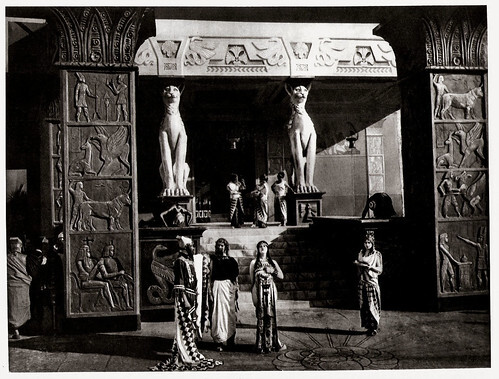
Publicity still of the Italian silent film classic Cabiria (Giovanni Pastrone, 1914), with Alex Bernard, Edoardo Davesnes, Italia Almirante-Manzini and Lydia Quaranta .
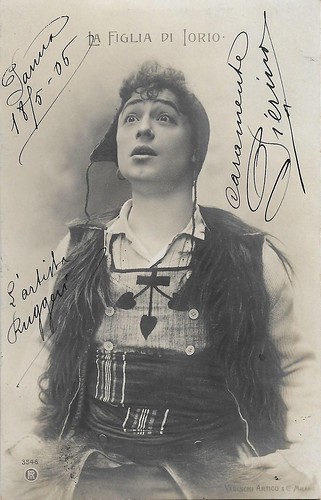
Italian postcard by RPH, no. 3546. Photo: Varischi Artico.& Co., Milano. Mailed 18 May 1906. Ruggero Ruggeri as Aligi in the stage play 'La figlia di Jorio' (1904).
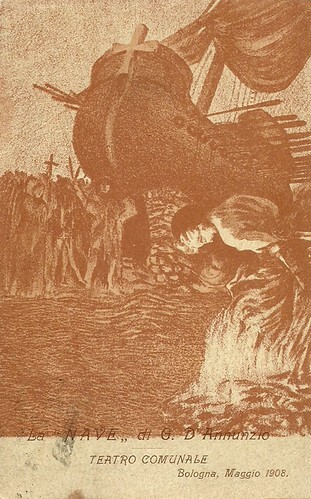
Vintage Italian postcard. Publicity for the staging of the play 'La Nave' by Gabriele D'Annunzio at the Teatro Comunale in Bologna in May 1908.
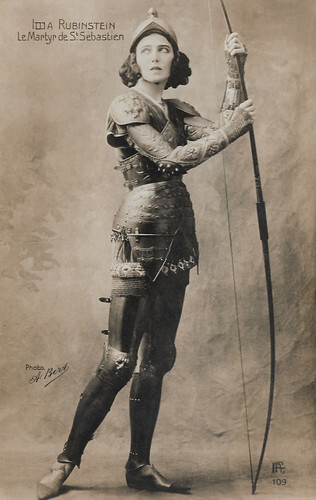
French postcard by RA, no. 109. Photo: A. Bert. Ida Rubinstein in the French stage production Le Martyr de St. Sebastien (1911).

Italian postcard by IPA CT, no. 3876. Photo: Film della Soc. Ambrosio, Torino. V. Uff. Rev. St., Terni. Umberto Mozzato as Lucio Settala and Helena Makowska as Gioconda Dianti in La Gioconda (Eleuterio Rodolfi, 1916). Caption: Lucio Settala is madly in love with his model Gioconda Dianti.
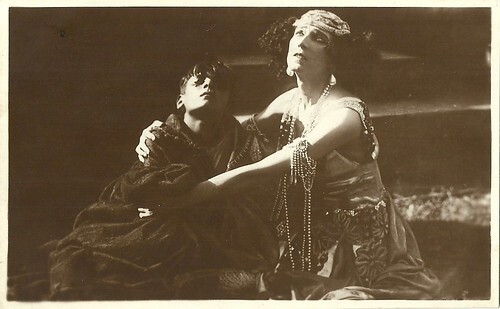
Italian postcard. Photo: Unione Cinematografica Italiana / Ambrosio-Zanotta. Ida Rubinstein in the Italian silent film La nave (Gabriellino D'Annunzio, Mario Roncoroni, 1921), based on the homonymous play by Gabriele D'Annunzio.
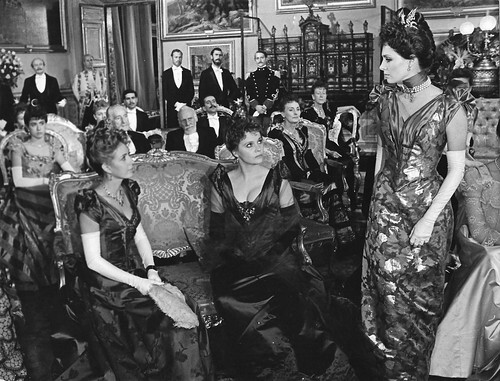
Italian press photo. Photo: Mario Tursi. Marie Dubois , Laura Antonelli and Jennifer O'Neill in L'innocente/The Innocent (Luchino Visconti, 1976). Setting: Palazzo Colonna, Rome. Collection: Ivo Blom.
The cult of beauty
Gabriele D'Annunzio was born in 1863 in Pescara into a wealthy family of landowners. His father's name was Francesco Rapagnetta. At the age of 13, Francesco was adopted by his uncle Antonio D'Annunzio, after which he assumed the surname D'Annunzio. Gabriele attended school at the lycem Cicognini at Prato in Tuscany. In 1879. at the age of 16, he published his first book of poetry, called 'Primo Vere'. He was influenced by the poetry book 'Odi barbare' by Giosuè Carducci, but also by the poet Lorenzo Stecchetti, whose work 'Postuma' was then in vogue. In order to attract more attention to his book of poetry, he sent a fictitious story to a newspaper, stating that he had died in a fall from a horse.
D'Annunzio was a brilliant student, reading everything his teachers recommended and even more. He devoured the works of Plutarch, Virgil, Catullus, Italian Renaissance poets, Niccolo Tommaséo, Manzoni, Stoppani, De Gubernatis, Byron, Goethe, Milton, and Darwin, among others. He remained in the capital until 1891. He stayed there in the palazzo Roccagiovine, among other places. D'Annunzio tried to distinguish himself from the masses by living like a dandy. As for his clothes, he was very meticulous and fastidious. For instance, he refused to wear clothes made in Italy. At the time, French or British fashion was held in higher esteem than Italian. In 1882, he published a collection of poems entitled 'Elegie romane', which was a response to Goethe's 'Roman Elegies', a work that recounted the German author's journey to Italy (1786-1788).
In 1883 he caused a scandal. He kidnapped Countess Maria Hardouin di Gallese and finally married her when she was already pregnant with their first child. She gave him three sons. His first novel, 'Il piacere' (The Child of Pleasure, 1889) received good reviews. The main character Andrea Spirelli, a young aristocrat, is based on the author himself. One of the most striking consequences of d'Annunzio's appearance in the literary world was the creation of a d'Annunzian audience of his own, formed not so much by the content of his work as by the star power assumed by the author. His scandalous behaviour, the cult of beauty, and his disregard for bourgeois values created an aura of fascination.
Then followed two other novels, 'L'Innocente' (The Intruder, 1891) and 'Giovanni Episcopo' (1892). These three novels made a strong impression on the public. 'L'Innocente' was praised by foreign literary critics and would later be filmed by Luchino Visconti . D'Annunzio's next work, 'Il trionfo della morte' (The Triumph of Death, 1894), was followed soon by 'Le vergini delle rocce' (The Maidens of the Rocks, 1896) and 'Il fuoco' (The Flame of Life, 1900).
D'Annunzio became a member of the Italian parliament for the conservatives in 1897. He was an extreme nationalist. In 1901, D'Annunzio and Ettore Ferrari, Grand Master of the Masonic lodge the Great East of Italy, founded the Università Popolare di Milano (People's University of Milan). He had an affair with the famous actress Eleonora Duse , which lasted from 1897 to 1902, and then had a flashback relationship with the eccentric Luisa Casati until a few years before his death.
A later phase of D'Annunzio's work is his dramatic production, represented by 'Il sogno di un mattino di primavera' (1897), a lyrical fantasia in one act, and his 'Città Morta' (The Dead City, 1898), written for Sarah Bernhardt. In 1898 he wrote his 'Sogno di un pomeriggio d'autunno' and 'La Gioconda'; in the succeeding year 'La gloria, an attempt at an contemporary political tragedy which met with no success, probably because of the audacity of the personal and political allusions in some of its scenes; and then 'Francesca da Rimini' (1901), based on an episode from Dante Alighieri's 'Inferno'.
D'Annunzio's profligate lifestyle with rash purchases saddled him with large debts. To escape his Italian creditors, he left for France in 1910. In Paris, he collaborated with Claude Debussy and Léon Bakst on 'Le Martyre de saint Sébastien' (1911), written for Ida Rubinstein and choreographed by Michel Fokine. The work drew the wrath of the Archbishop of Paris, Léon Adolphe Amette, who threatened excommunication for any Catholic attending the performance. Back in Italy, he contributed to the screenplay of the feature film Cabiria (Giovanni Pastrone, 1914). He wrote all of the intertitles, named the characters and the film itself. The film is set in ancient Sicily, Carthage, and Cirta during the period of the Second Punic War (218–202 BC). It follows a melodramatic main plot about an abducted little girl, Cabiria, and features an eruption of Mount Etna, heinous religious rituals in Carthage, the alpine trek of Hannibal, Archimedes' defeat of the Roman fleet at the Siege of Syracuse, and Scipio maneuvering in North Africa. Apart from being a classic on its own terms, the film is also notable for being the first film in which the long-running film character Maciste ( Bartolomeo Pagano ) makes his debut.
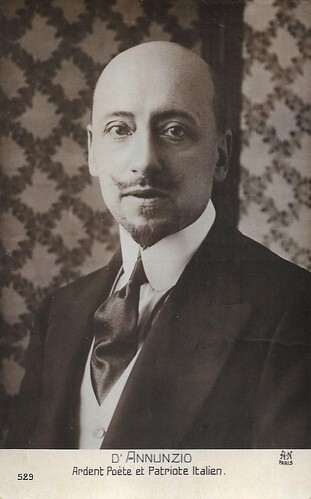
French postcard by A.N., Paris, no. 529. Gabriele D'Annunzio.

Italian postcard, no. 127. Photo: Sciutto, Genova. Eleonora Duse in the play 'La città morta' (The Dead City) by Gabriele D'Annunzio. The photo was made for the performance of Duse in Genoa, Teatro Paganini, in April 1901. The blind Anna holds Bianca Maria onto her lap. She understands that the girl is in love with her own husband Alessandro.
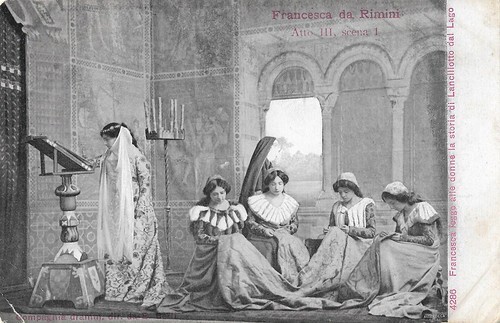
Italian postcard by Alterocca, Terni, no. 4286. A stage production by Compagnia drammatica di E. Berti of 'Francesca da Rimini' (1903), a play by Gabriele D'Annunzio, based on a tale from 'Dante's Inferno' (Paolo & Francesca). The play was first performed in 1901 with Eleonora Duse in the lead. This card refers to the second version by the stage company of Ettore Berti and Giuseppe Masi, with Emilia Varini as Francesca and Berti as Paolo. The play was performed e.g. at the prestigious Teatro Carignano in Turin from 7 March 1903. Caption: Act III, scene 1. Francesca reads the ladies the story of Lancelot du Lac. 'Francesca da Rimini' was filmed various times, in particular in Italy: in 1908 by Mario Morais for Comerio (actress unknown), in 1910 by Ugo Falena for Film d'Arte Italiana with Francesca Bertini in the lead; in 1922 by Carlo Dalbani and Mario Volpe with Mary Bayma-Riva in the lead; while in 1921, it was an episode of the Dante biopic La mirabile visione by Caramba. After WWII, Raffaele Matarazzo did a sound version, Paolo e Francesca (1950), with Odile Versois in the lead. Non-Italian adaptations were in 1908 by Stuart Blackton (Francesca di Rimini; or, The Two Brothers) with Florence Turner as Francesca; and in 1913 by Arthur Maude with Constance Crawley. Many TV movies followed from the 1950s onward.
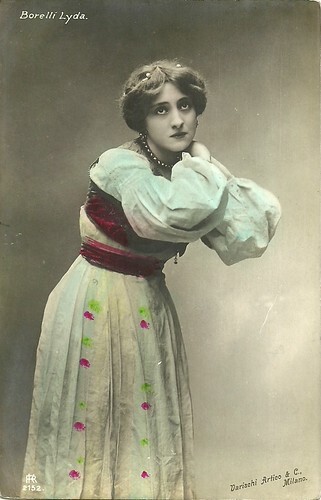
Italian postcard by Varischi Artico Co., Milano, no. 152. Lyda Borelli as Favetta in the stage play La figlia di Jorio (Gabriele D'Annunzio, 1904). In 1903 Gabriele D'Annunzio wrote the drama 'La figlia di Jorio' (The Daughter of Jorio), a pastoral tragedy situated in the Abruzzi mountains in center Italy. On 2 March 1904 the stage company Talli-Calabresi-Grammatica performed the premiere of the play at the Teatro Lirico in Milan. Protagonist should have been Eleonora Duse, but she fell ill. D'Annunzio, whose relationship with Duse was fading, didn't wait for her healing and gave the female lead to Irma Grammatica - which hurt Duse dearly. The painter Francesco Paolo Michetti, a good friend of D'Annunzio, designed the sets and costumes. The play was a huge success, also in Chieti in Abruzzi when it was performed there the same year. In 1907, with D'Annunzio's permission, a version in Abruzzese dialect was written and performed.
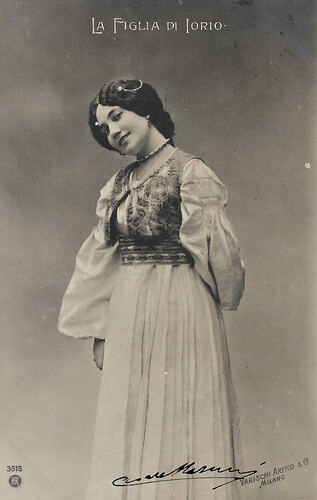
Italian postcard by RA, no. 3515. Photo: Varischi Artico & Co., Milano. Giannina Chiantoni as Ornella in 'La figlia di Jorio' (1904).

Italian postcard. Anna De Marco as Gigliola in La fiaccola sotto il moggio (Eleuterio Rodolfi, Ambrosio 1916), an adaptation of the play by Gabriele D'Annunzio. Caption: "All was dark. An unrelenting scourge scatters in the night the trembling survivors. Blessed is the one who rests in peace!" The vengeful Gigliola visits the grave of her mother in the family chapel, one year after the murder. She holds a wrath in her hands.
An announcement of fascist violence
During the First World War, Gabriele D'Annunzio advocated Italian participation in the conflict. In 1915, he enlisted in the Italian army. He became a fighter pilot. In 1917, he took part in the battles near the Isonzo river. On 10 February 1918, he took part in the raid on the Austro-Hungarian fleet in the port of Buccari. This raid was materially unsuccessful but had an important psychological effect. He received several military medals of honour.
Since Italy only acquired part of Dalmatia at the Treaty of Saint-Germain, but most of it was awarded to Yugoslavia, Gabriele d'Annunzio and his irregular troops (4,000 legionaries) occupied the city of Fiume (now Rijeka) on the Dalmatian coast on 12 September 1919 and founded the Italian Regency Carnaro. He thus became the figurehead of the irredentist movement in Italy. He declared that the Italian Regency of Carnaro was an independent state. He did not recognise the Treaty of Rapallo and declared war on Italy.
The regime installed by D'Annunzio in Fiume was a forerunner and had all the characteristics of the later fascist administration. This action was an announcement of fascist violence in the coming decades (compare D'Annunzio's 1919 speech to his troops (the Arditi): "every bullet from our guns must kill a Slovene or a Croat"). The 15-month occupation of Fiume ended when the Italian Navy bombed the city. D'Annunzio was wounded. This occupation showed the weakness of the Italian state.
At the end of 1920, D'Annunzio took possession of a confiscated villa on Lake Garda, where he lived until his death in 1938. In 1921 he became a member of the Académie royale de langue et de littérature françaises de Belgique. On the night of 13 to 14 August 1922, he fell out of a window of the villa where he lived. Possibly this was an accident, possibly he was pushed out of the window. Shortly afterwards, Benito Mussolini seized power. D'Annunzio kept silent about the exact circumstances of his fall. Mussolini had the writer guarded in the villa by some carabinieri. He feared the possible influence of D'Annunzio on public opinion or on the army.
In 1924, D'Annunzio was eulogised and given the title Prince of Montenevoso. In 1937, he warned Mussolini not to enter into a military alliance with Nazi Germany. A year later, in 1938, Gabriele d'Annunzio passed away in Gardone Riviera.
His literary style developed and changed regularly, but the development towards a kind of hedonism as it emerged at the beginning of the 20th century remains more or less central. His earlier work is lyrical, somewhat inhibited about the expression of emotions, in which naturalism can be recognised. D'Annunzio was associated with the Decadent movement, which interacted with French Symbolism. After 1883, under the influence of Friedrich Nietzsche, the 'übermensch' motif became central to his work.
His last novel, 'Forse che si, forse che no', is set in Mantua, in the Gonzaga palace. The protagonist is a nobleman who has a passionate relationship with Isabella. Unlike the other D'Annunzian 'übermenschen', he has understood the changes in the modern world. Instead of escaping into a decadent life, he indulges in machines, cars, and airplanes. He also sympathises to some extent with the Futurist art movement.
The novels of d'Gabriele D'Annunzio influenced those of his compatriot Curzio Malaparte. The tendency to identify with nature that occurs in d'Annunzio's poetry was adopted by Salvatore Quasimodo. Besides his novels, novellas, and poetry, D'Annunzio also left behind political works and about 10,000 letters.
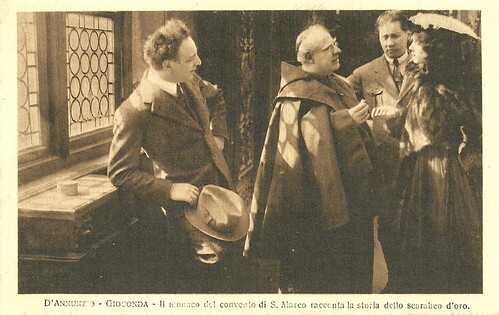
Italian postcard by IPA CT, no. 3662. Photo: Film della Società Ambrosio, Torino. Helena Makowska in La Gioconda (Eleuterio Rodolfi, 1917), based on Gabriele D'Annunzio's play. Caption: The monk of the convent of St. Mark told the story of the golden scarabee.' Helena Makowska played the model Gioconda Dianti but also the Egyptian courtesan in the legend told. Left in the image Umberto Mozzato as the artist Lucio Settala.
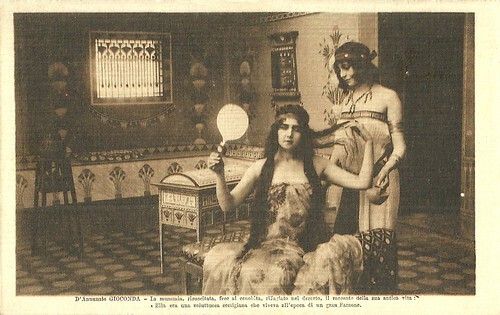
Italian postcard by IPA CT, no. 3873. Photo: Film della Società Ambrosio, Torino. Helena Makowska in La Gioconda (Eleuterio Rodolfi, 1917), based on Gabriele D'Annunzio's play. Caption: The resurrected mummy told the monk, refugee in the desert, the story of her ancient life: She had been a voluptuous courtesan who lived in the times of the great Pharaon.'
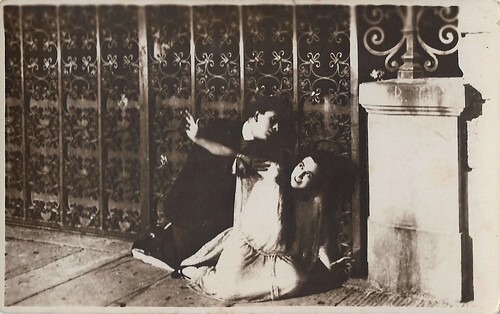
Italian postcard by G.B. Falci, Milano, unnumbered. Photo: Unione Cinematografica Italiana. Maria Carmi as Isabella Inghirami in the Italian silent film Forse che sí, forse che no (Gaston Ravel, 1920), based on Gabriele D'Annunzio's eponymous novel (1910). The maddened Isabella does not understand Paolo's pleas anymore.
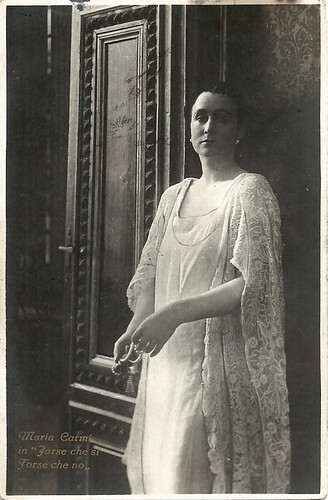
Italian postcard. G.B. Falci, Milano, unnumbered. Maria Carmi as Isabella Inghirami in the Italian silent film Forse che sí, forse che no (Gaston Ravel, 1920), based on Gabriele D'Annunzio's eponymous novel (1910). In 1916 the play had already been adapted to film by Mario Gargiulo, with Tina Xeo in the lead.
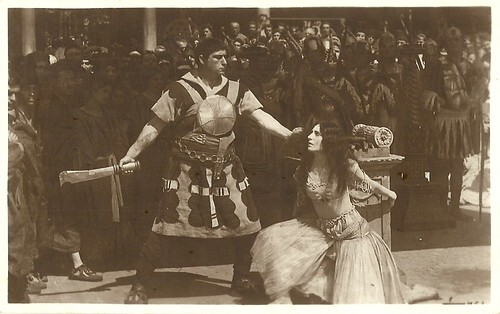
Italian postcard. Photo: Unione Cinematografica Italiana / Ambrosio-Zanotta. Ida Rubinstein in the Italian silent film La nave (Gabriellino D'Annunzio, Mario Roncoroni, 1921), based on the homonymous play by Gabriele D'Annunzio. In 1921, Russian dancer and actress Ida Rubinstein, close friend of Gabriele D'Annunzio, played the lead of Basiliola in the film La nave, directed by D'Annunzio's son Gabriellino and by Mario Roncoroni. The film was based on a play by D'Annunzio, which already had been turned into an opera and had been filmed in 1912 by the company Ambrosio, but without much success. Guido Marussig, who had designed both the play and the opera, designed sets, and costumes for the 1921 film. The directors shot the film in a style typical of the later silent epics in Italy, denying innovation in film language and instead focusing on acting, set & costume design, harking back to earlier epics such as Cabiria, but adding cruelty and sado-masochism. La nave is set in early medieval times. In the Venetian plains, at the town of Aquileia, Basiliola, daughter of the dethroned tribune Orso Faledro returns per ship and notices her father and brothers have been blinded by the Graticò brothers, of whom Marco (Alfredo Boccolini) is the new tribune and Sergio (Ciro Galvani) has become a bishop. Basiliola decides to ruin all involved. In an extended dance scene, she seduces Sergio, the lecherous bishop.
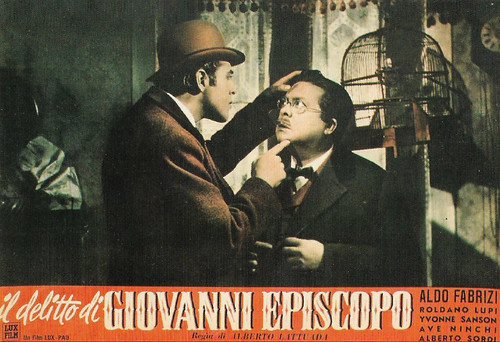
Italian postcard by Ed. Gel, series Aldo Fabrizi. Poster/lobby card for Il delitto di Giovanni Episcopo/Flesh Will Surrender (Alberto Lattuada, 1947), with Aldo Fabrizi and based on the novel by D'Annunzio.
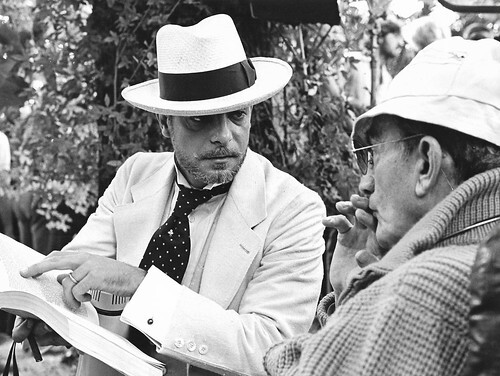
Italian press photo. Photo: Mario Tursi. Giancarlo Giannini and Luchino Visconti discussing the text during the shooting of L'innocente/ The Innocent (Luchino Visconti, 1976). Setting: Tuscany, near Lucca. Collection: Ivo Blom.
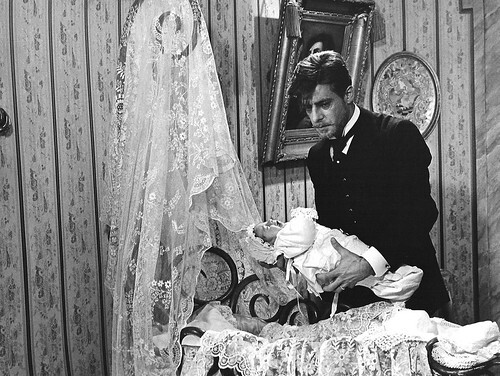
Italian press photo. Photo: Mario Tursi. Giancarlo Giannini in L'Innocente/The Innocent (Luchino Visconti, 1976). Collection: Ivo Blom.
Sources: Wikipedia (Dutch, French, and English), and IMDb.

Publicity still of the Italian silent film classic Cabiria (Giovanni Pastrone, 1914), with Alex Bernard, Edoardo Davesnes, Italia Almirante-Manzini and Lydia Quaranta .

Italian postcard by RPH, no. 3546. Photo: Varischi Artico.& Co., Milano. Mailed 18 May 1906. Ruggero Ruggeri as Aligi in the stage play 'La figlia di Jorio' (1904).

Vintage Italian postcard. Publicity for the staging of the play 'La Nave' by Gabriele D'Annunzio at the Teatro Comunale in Bologna in May 1908.

French postcard by RA, no. 109. Photo: A. Bert. Ida Rubinstein in the French stage production Le Martyr de St. Sebastien (1911).

Italian postcard by IPA CT, no. 3876. Photo: Film della Soc. Ambrosio, Torino. V. Uff. Rev. St., Terni. Umberto Mozzato as Lucio Settala and Helena Makowska as Gioconda Dianti in La Gioconda (Eleuterio Rodolfi, 1916). Caption: Lucio Settala is madly in love with his model Gioconda Dianti.

Italian postcard. Photo: Unione Cinematografica Italiana / Ambrosio-Zanotta. Ida Rubinstein in the Italian silent film La nave (Gabriellino D'Annunzio, Mario Roncoroni, 1921), based on the homonymous play by Gabriele D'Annunzio.

Italian press photo. Photo: Mario Tursi. Marie Dubois , Laura Antonelli and Jennifer O'Neill in L'innocente/The Innocent (Luchino Visconti, 1976). Setting: Palazzo Colonna, Rome. Collection: Ivo Blom.
The cult of beauty
Gabriele D'Annunzio was born in 1863 in Pescara into a wealthy family of landowners. His father's name was Francesco Rapagnetta. At the age of 13, Francesco was adopted by his uncle Antonio D'Annunzio, after which he assumed the surname D'Annunzio. Gabriele attended school at the lycem Cicognini at Prato in Tuscany. In 1879. at the age of 16, he published his first book of poetry, called 'Primo Vere'. He was influenced by the poetry book 'Odi barbare' by Giosuè Carducci, but also by the poet Lorenzo Stecchetti, whose work 'Postuma' was then in vogue. In order to attract more attention to his book of poetry, he sent a fictitious story to a newspaper, stating that he had died in a fall from a horse.
D'Annunzio was a brilliant student, reading everything his teachers recommended and even more. He devoured the works of Plutarch, Virgil, Catullus, Italian Renaissance poets, Niccolo Tommaséo, Manzoni, Stoppani, De Gubernatis, Byron, Goethe, Milton, and Darwin, among others. He remained in the capital until 1891. He stayed there in the palazzo Roccagiovine, among other places. D'Annunzio tried to distinguish himself from the masses by living like a dandy. As for his clothes, he was very meticulous and fastidious. For instance, he refused to wear clothes made in Italy. At the time, French or British fashion was held in higher esteem than Italian. In 1882, he published a collection of poems entitled 'Elegie romane', which was a response to Goethe's 'Roman Elegies', a work that recounted the German author's journey to Italy (1786-1788).
In 1883 he caused a scandal. He kidnapped Countess Maria Hardouin di Gallese and finally married her when she was already pregnant with their first child. She gave him three sons. His first novel, 'Il piacere' (The Child of Pleasure, 1889) received good reviews. The main character Andrea Spirelli, a young aristocrat, is based on the author himself. One of the most striking consequences of d'Annunzio's appearance in the literary world was the creation of a d'Annunzian audience of his own, formed not so much by the content of his work as by the star power assumed by the author. His scandalous behaviour, the cult of beauty, and his disregard for bourgeois values created an aura of fascination.
Then followed two other novels, 'L'Innocente' (The Intruder, 1891) and 'Giovanni Episcopo' (1892). These three novels made a strong impression on the public. 'L'Innocente' was praised by foreign literary critics and would later be filmed by Luchino Visconti . D'Annunzio's next work, 'Il trionfo della morte' (The Triumph of Death, 1894), was followed soon by 'Le vergini delle rocce' (The Maidens of the Rocks, 1896) and 'Il fuoco' (The Flame of Life, 1900).
D'Annunzio became a member of the Italian parliament for the conservatives in 1897. He was an extreme nationalist. In 1901, D'Annunzio and Ettore Ferrari, Grand Master of the Masonic lodge the Great East of Italy, founded the Università Popolare di Milano (People's University of Milan). He had an affair with the famous actress Eleonora Duse , which lasted from 1897 to 1902, and then had a flashback relationship with the eccentric Luisa Casati until a few years before his death.
A later phase of D'Annunzio's work is his dramatic production, represented by 'Il sogno di un mattino di primavera' (1897), a lyrical fantasia in one act, and his 'Città Morta' (The Dead City, 1898), written for Sarah Bernhardt. In 1898 he wrote his 'Sogno di un pomeriggio d'autunno' and 'La Gioconda'; in the succeeding year 'La gloria, an attempt at an contemporary political tragedy which met with no success, probably because of the audacity of the personal and political allusions in some of its scenes; and then 'Francesca da Rimini' (1901), based on an episode from Dante Alighieri's 'Inferno'.
D'Annunzio's profligate lifestyle with rash purchases saddled him with large debts. To escape his Italian creditors, he left for France in 1910. In Paris, he collaborated with Claude Debussy and Léon Bakst on 'Le Martyre de saint Sébastien' (1911), written for Ida Rubinstein and choreographed by Michel Fokine. The work drew the wrath of the Archbishop of Paris, Léon Adolphe Amette, who threatened excommunication for any Catholic attending the performance. Back in Italy, he contributed to the screenplay of the feature film Cabiria (Giovanni Pastrone, 1914). He wrote all of the intertitles, named the characters and the film itself. The film is set in ancient Sicily, Carthage, and Cirta during the period of the Second Punic War (218–202 BC). It follows a melodramatic main plot about an abducted little girl, Cabiria, and features an eruption of Mount Etna, heinous religious rituals in Carthage, the alpine trek of Hannibal, Archimedes' defeat of the Roman fleet at the Siege of Syracuse, and Scipio maneuvering in North Africa. Apart from being a classic on its own terms, the film is also notable for being the first film in which the long-running film character Maciste ( Bartolomeo Pagano ) makes his debut.

French postcard by A.N., Paris, no. 529. Gabriele D'Annunzio.

Italian postcard, no. 127. Photo: Sciutto, Genova. Eleonora Duse in the play 'La città morta' (The Dead City) by Gabriele D'Annunzio. The photo was made for the performance of Duse in Genoa, Teatro Paganini, in April 1901. The blind Anna holds Bianca Maria onto her lap. She understands that the girl is in love with her own husband Alessandro.

Italian postcard by Alterocca, Terni, no. 4286. A stage production by Compagnia drammatica di E. Berti of 'Francesca da Rimini' (1903), a play by Gabriele D'Annunzio, based on a tale from 'Dante's Inferno' (Paolo & Francesca). The play was first performed in 1901 with Eleonora Duse in the lead. This card refers to the second version by the stage company of Ettore Berti and Giuseppe Masi, with Emilia Varini as Francesca and Berti as Paolo. The play was performed e.g. at the prestigious Teatro Carignano in Turin from 7 March 1903. Caption: Act III, scene 1. Francesca reads the ladies the story of Lancelot du Lac. 'Francesca da Rimini' was filmed various times, in particular in Italy: in 1908 by Mario Morais for Comerio (actress unknown), in 1910 by Ugo Falena for Film d'Arte Italiana with Francesca Bertini in the lead; in 1922 by Carlo Dalbani and Mario Volpe with Mary Bayma-Riva in the lead; while in 1921, it was an episode of the Dante biopic La mirabile visione by Caramba. After WWII, Raffaele Matarazzo did a sound version, Paolo e Francesca (1950), with Odile Versois in the lead. Non-Italian adaptations were in 1908 by Stuart Blackton (Francesca di Rimini; or, The Two Brothers) with Florence Turner as Francesca; and in 1913 by Arthur Maude with Constance Crawley. Many TV movies followed from the 1950s onward.

Italian postcard by Varischi Artico Co., Milano, no. 152. Lyda Borelli as Favetta in the stage play La figlia di Jorio (Gabriele D'Annunzio, 1904). In 1903 Gabriele D'Annunzio wrote the drama 'La figlia di Jorio' (The Daughter of Jorio), a pastoral tragedy situated in the Abruzzi mountains in center Italy. On 2 March 1904 the stage company Talli-Calabresi-Grammatica performed the premiere of the play at the Teatro Lirico in Milan. Protagonist should have been Eleonora Duse, but she fell ill. D'Annunzio, whose relationship with Duse was fading, didn't wait for her healing and gave the female lead to Irma Grammatica - which hurt Duse dearly. The painter Francesco Paolo Michetti, a good friend of D'Annunzio, designed the sets and costumes. The play was a huge success, also in Chieti in Abruzzi when it was performed there the same year. In 1907, with D'Annunzio's permission, a version in Abruzzese dialect was written and performed.

Italian postcard by RA, no. 3515. Photo: Varischi Artico & Co., Milano. Giannina Chiantoni as Ornella in 'La figlia di Jorio' (1904).

Italian postcard. Anna De Marco as Gigliola in La fiaccola sotto il moggio (Eleuterio Rodolfi, Ambrosio 1916), an adaptation of the play by Gabriele D'Annunzio. Caption: "All was dark. An unrelenting scourge scatters in the night the trembling survivors. Blessed is the one who rests in peace!" The vengeful Gigliola visits the grave of her mother in the family chapel, one year after the murder. She holds a wrath in her hands.
An announcement of fascist violence
During the First World War, Gabriele D'Annunzio advocated Italian participation in the conflict. In 1915, he enlisted in the Italian army. He became a fighter pilot. In 1917, he took part in the battles near the Isonzo river. On 10 February 1918, he took part in the raid on the Austro-Hungarian fleet in the port of Buccari. This raid was materially unsuccessful but had an important psychological effect. He received several military medals of honour.
Since Italy only acquired part of Dalmatia at the Treaty of Saint-Germain, but most of it was awarded to Yugoslavia, Gabriele d'Annunzio and his irregular troops (4,000 legionaries) occupied the city of Fiume (now Rijeka) on the Dalmatian coast on 12 September 1919 and founded the Italian Regency Carnaro. He thus became the figurehead of the irredentist movement in Italy. He declared that the Italian Regency of Carnaro was an independent state. He did not recognise the Treaty of Rapallo and declared war on Italy.
The regime installed by D'Annunzio in Fiume was a forerunner and had all the characteristics of the later fascist administration. This action was an announcement of fascist violence in the coming decades (compare D'Annunzio's 1919 speech to his troops (the Arditi): "every bullet from our guns must kill a Slovene or a Croat"). The 15-month occupation of Fiume ended when the Italian Navy bombed the city. D'Annunzio was wounded. This occupation showed the weakness of the Italian state.
At the end of 1920, D'Annunzio took possession of a confiscated villa on Lake Garda, where he lived until his death in 1938. In 1921 he became a member of the Académie royale de langue et de littérature françaises de Belgique. On the night of 13 to 14 August 1922, he fell out of a window of the villa where he lived. Possibly this was an accident, possibly he was pushed out of the window. Shortly afterwards, Benito Mussolini seized power. D'Annunzio kept silent about the exact circumstances of his fall. Mussolini had the writer guarded in the villa by some carabinieri. He feared the possible influence of D'Annunzio on public opinion or on the army.
In 1924, D'Annunzio was eulogised and given the title Prince of Montenevoso. In 1937, he warned Mussolini not to enter into a military alliance with Nazi Germany. A year later, in 1938, Gabriele d'Annunzio passed away in Gardone Riviera.
His literary style developed and changed regularly, but the development towards a kind of hedonism as it emerged at the beginning of the 20th century remains more or less central. His earlier work is lyrical, somewhat inhibited about the expression of emotions, in which naturalism can be recognised. D'Annunzio was associated with the Decadent movement, which interacted with French Symbolism. After 1883, under the influence of Friedrich Nietzsche, the 'übermensch' motif became central to his work.
His last novel, 'Forse che si, forse che no', is set in Mantua, in the Gonzaga palace. The protagonist is a nobleman who has a passionate relationship with Isabella. Unlike the other D'Annunzian 'übermenschen', he has understood the changes in the modern world. Instead of escaping into a decadent life, he indulges in machines, cars, and airplanes. He also sympathises to some extent with the Futurist art movement.
The novels of d'Gabriele D'Annunzio influenced those of his compatriot Curzio Malaparte. The tendency to identify with nature that occurs in d'Annunzio's poetry was adopted by Salvatore Quasimodo. Besides his novels, novellas, and poetry, D'Annunzio also left behind political works and about 10,000 letters.

Italian postcard by IPA CT, no. 3662. Photo: Film della Società Ambrosio, Torino. Helena Makowska in La Gioconda (Eleuterio Rodolfi, 1917), based on Gabriele D'Annunzio's play. Caption: The monk of the convent of St. Mark told the story of the golden scarabee.' Helena Makowska played the model Gioconda Dianti but also the Egyptian courtesan in the legend told. Left in the image Umberto Mozzato as the artist Lucio Settala.

Italian postcard by IPA CT, no. 3873. Photo: Film della Società Ambrosio, Torino. Helena Makowska in La Gioconda (Eleuterio Rodolfi, 1917), based on Gabriele D'Annunzio's play. Caption: The resurrected mummy told the monk, refugee in the desert, the story of her ancient life: She had been a voluptuous courtesan who lived in the times of the great Pharaon.'

Italian postcard by G.B. Falci, Milano, unnumbered. Photo: Unione Cinematografica Italiana. Maria Carmi as Isabella Inghirami in the Italian silent film Forse che sí, forse che no (Gaston Ravel, 1920), based on Gabriele D'Annunzio's eponymous novel (1910). The maddened Isabella does not understand Paolo's pleas anymore.

Italian postcard. G.B. Falci, Milano, unnumbered. Maria Carmi as Isabella Inghirami in the Italian silent film Forse che sí, forse che no (Gaston Ravel, 1920), based on Gabriele D'Annunzio's eponymous novel (1910). In 1916 the play had already been adapted to film by Mario Gargiulo, with Tina Xeo in the lead.

Italian postcard. Photo: Unione Cinematografica Italiana / Ambrosio-Zanotta. Ida Rubinstein in the Italian silent film La nave (Gabriellino D'Annunzio, Mario Roncoroni, 1921), based on the homonymous play by Gabriele D'Annunzio. In 1921, Russian dancer and actress Ida Rubinstein, close friend of Gabriele D'Annunzio, played the lead of Basiliola in the film La nave, directed by D'Annunzio's son Gabriellino and by Mario Roncoroni. The film was based on a play by D'Annunzio, which already had been turned into an opera and had been filmed in 1912 by the company Ambrosio, but without much success. Guido Marussig, who had designed both the play and the opera, designed sets, and costumes for the 1921 film. The directors shot the film in a style typical of the later silent epics in Italy, denying innovation in film language and instead focusing on acting, set & costume design, harking back to earlier epics such as Cabiria, but adding cruelty and sado-masochism. La nave is set in early medieval times. In the Venetian plains, at the town of Aquileia, Basiliola, daughter of the dethroned tribune Orso Faledro returns per ship and notices her father and brothers have been blinded by the Graticò brothers, of whom Marco (Alfredo Boccolini) is the new tribune and Sergio (Ciro Galvani) has become a bishop. Basiliola decides to ruin all involved. In an extended dance scene, she seduces Sergio, the lecherous bishop.

Italian postcard by Ed. Gel, series Aldo Fabrizi. Poster/lobby card for Il delitto di Giovanni Episcopo/Flesh Will Surrender (Alberto Lattuada, 1947), with Aldo Fabrizi and based on the novel by D'Annunzio.

Italian press photo. Photo: Mario Tursi. Giancarlo Giannini and Luchino Visconti discussing the text during the shooting of L'innocente/ The Innocent (Luchino Visconti, 1976). Setting: Tuscany, near Lucca. Collection: Ivo Blom.

Italian press photo. Photo: Mario Tursi. Giancarlo Giannini in L'Innocente/The Innocent (Luchino Visconti, 1976). Collection: Ivo Blom.
Sources: Wikipedia (Dutch, French, and English), and IMDb.
Published on May 30, 2022 22:00
Written by Gabriele d’ Annunzio
Italian novelist and playwright Gabriele d'Annunzio (1863-1938) was also a decorated fighter pilot, journalist, politician, and dandy. He was conceited, eccentric, called himself the greatest Italian poet since Dante, and compared himself to Caesar, Nelson, and Byron. Today, EFSP presents postcards and photos of films based on novels and plays by d'Annunzio

Publicity still of the Italian silent film classic Cabiria (Giovanni Pastrone, 1914), with Alex Bernard, Edoardo Davesnes, Italia Almirante-Manzini and Lydia Quaranta .

Italian postcard by RPH, no. 3546. Photo: Varischi Artico.& Co., Milano. Mailed 18 May 1906. Ruggero Ruggeri as Aligi in the stage play La figlia di Jorio (1904).

Vintage Italian postcard. Publicity for the staging of the play 'La Nave' by Gabriele D'Annunzio at the Teatro Comunale in Bologna in May 1908.

French postcard by RA, no. 109. Photo: A. Bert. Ida Rubinstein in the French stage production Le Martyr de St. Sebastien (1911).

Italian postcard by IPA CT, no. 3876. Photo: Film della Soc. Ambrosio, Torino. V. Uff. Rev. St., Terni. Umberto Mozzato as Lucio Settala and Helena Makowska as Gioconda Dianti in La Gioconda (Eleuterio Rodolfi, 1916). Caption: Lucio Settala is madly in love with his model Gioconda Dianti.

Italian postcard. Photo: Unione Cinematografica Italiana / Ambrosio-Zanotta. Ida Rubinstein in the Italian silent film La nave (Gabriellino D'Annunzio, Mario Roncoroni, 1921), based on the homonymous play by Gabriele D'Annunzio.

Italian press photo. Photo: Mario Tursi. Marie Dubois , Laura Antonelli and Jennifer O'Neill in L'innocente/The Innocent (Luchino Visconti, 1976). Setting: Palazzo Colonna, Rome.
The cult of beauty
Gabriele d'Annunzio was born in 1963 in Pescara into a wealthy family of landowners. His father's name was Francesco Rapagnetta. At the age of 13, Francesco was adopted by his uncle Antonio D'Annunzio, after which he assumed the surname D'Annunzio. Gabriele attended school at the lycem Cicognini at Prato in Tuscany. In 1879. at the age of 16, he published his first book of poetry, called 'Primo Vere'. He was influenced by the poetry book 'Odi barbare' by Giosuè Carducci, but also by the poet Lorenzo Stecchetti, whose work 'Postuma' was then in vogue. In order to attract more attention to his book of poetry, he sent a fictitious story to a newspaper, stating that he had died in a fall from a horse.
D'Annunzio was a brilliant student, reading everything his teachers recommended and even more. He devoured the works of Plutarch, Virgil, Catullus, Italian Renaissance poets, Niccolo Tommaséo, Manzoni, Stoppani, De Gubernatis, Byron, Goethe, Milton, and Darwin, among others. He remained in the capital until 1891. He stayed there in the palazzo Roccagiovine, among other places. D'Annunzio tried to distinguish himself from the masses by living like a dandy. As for his clothes, he was very meticulous and fastidious. For instance, he refused to wear clothes made in Italy. At the time, French or British fashion was held in higher esteem than Italian. In 1882, he published a collection of poems entitled 'Elegie romane', which was a response to Goethe's 'Roman Elegies', a work that recounted the German author's journey to Italy (1786-1788).
In 1883 he caused a scandal. He kidnapped Countess Maria Hardouin di Gallese and finally married her when she was already pregnant with their first child. She gave him three sons. His first novel, 'Il piacere' (The Child of Pleasure, 1889) received good reviews. The main character Andrea Spirelli, a young aristocrat, is based on the author himself. One of the most striking consequences of d'Annunzio's appearance in the literary world was the creation of a d'Annunzian audience of his own, formed not so much by the content of his work as by the star power assumed by the author. His scandalous behaviour, the cult of beauty, and his disregard for bourgeois values created an aura of fascination.
Then followed two other novels, 'L'Innocente' (The Intruder, 1891) and 'Giovanni Episcopo' (1892). These three novels made a strong impression on the public. 'L'Innocente' was praised by foreign literary critics and would later be filmed by Luchino Visconti . HD'Annunzio's next work, 'Il trionfo della morte' (The Triumph of Death, 1894), was followed soon by 'Le vergini delle rocce' (The Maidens of the Rocks, 1896) and Il fuoco (The Flame of Life, 1900).
D'Annunzio became a member of the Italian parliament for the conservatives in 1897. He was an extreme nationalist. In 1901, D'Annunzio and Ettore Ferrari, Grand Master of the Masonic lodge the Great East of Italy, founded the Università Popolare di Milano (People's University of Milan). He had an affair with the famous actress Eleonora Duse , which lasted from 1897 to 1902, and then had a flashback relationship with the eccentric Luisa Casati until a few years before his death.
A later phase of D'Annunzio's work is his dramatic production, represented by 'Il sogno di un mattino di primavera' (1897), a lyrical fantasia in one act, and his 'Città Morta' (The Dead City, 1898), written for Sarah Bernhardt. In 1898 he wrote his 'Sogno di un pomeriggio d'autunno' and 'La Gioconda'; in the succeeding year 'La gloria, an attempt at an contemporary political tragedy which met with no success, probably because of the audacity of the personal and political allusions in some of its scenes; and then 'Francesca da Rimini' (1901), based on an episode from Dante Alighieri's 'Inferno'.
His profligate lifestyle with rash purchases saddled him with large debts. To escape his Italian creditors, he left for France in 1910. In Paris, he collaborated with Claude Debussy and Léon Bakst on 'Le Martyre de saint Sébastien' (1911), written for Ida Rubinstein and choreographed by Michel Fokine. The work drew the wrath of the Archbishop of Paris, Léon Adolphe Amette, who threatened excommunication for any Catholic attending the performance. Back in Italy, he contributed to the screenplay of the feature film Cabiria (Giovanni Pastrone, 1914). He wrote all of the intertitles, named the characters and the film itself. The film is set in ancient Sicily, Carthage, and Cirta during the period of the Second Punic War (218–202 BC). It follows a melodramatic main plot about an abducted little girl, Cabiria, and features an eruption of Mount Etna, heinous religious rituals in Carthage, the alpine trek of Hannibal, Archimedes' defeat of the Roman fleet at the Siege of Syracuse, and Scipio maneuvering in North Africa. Apart from being a classic on its own terms, the film is also notable for being the first film in which the long-running film character Maciste ( Bartolomeo Pagano ) makes his debut.

French postcard by A.N., Paris, no. 529. Gabriele d'Annunzio.

Italian postcard, no. 127. Photo: Sciutto, Genova. Eleonora Duse in the play 'La città morta' (The Dead City) by Gabriele D'Annunzio. The photo was made for the performance of Duse in Genoa, Teatro Paganini, in April 1901. The blind Anna holds Bianca Maria onto her lap. She understands that the girl is in love with her own husband Alessandro.

Italian postcard by Alterocca, Terni, no. 4286. A stage production by Compagnia drammatica di E. Berti of 'Francesca da Rimini' (1903), a play by Gabriele D'Annunzio, based on a tale from 'Dante's Inferno' (Paolo & Francesca). The play was first performed in 1901 with Eleonora Duse in the lead. This card refers to the second version by the stage company of Ettore Berti and Giuseppe Masi, with Emilia Varini as Francesca and Berti as Paolo. The play was performed e.g. at the prestigious Teatro Carignano in Turin from 7 March 1903. Caption: Act III, scene 1. Francesca reads the ladies the story of Lancelot du Lac. 'Francesca da Rimini' was filmed various times, in particular in Italy: in 1908 by Mario Morais for Comerio (actress unknown), in 1910 by Ugo Falena for Film d'Arte Italiana with Francesca Bertini in the lead; in 1922 by Carlo Dalbani and Mario Volpe with Mary Bayma-Riva in the lead; while in 1921, it was an episode of the Dante biopic La mirabile visione by Caramba. After WWII, Raffaele Matarazzo did a sound version, Paolo e Francesca (1950), with Odile Versois in the lead. Non-Italian adaptations were in 1908 by Stuart Blackton (Francesca di Rimini; or, The Two Brothers) with Florence Turner as Francesca; and in 1913 by Arthur Maude with Constance Crawley. Many TV movies followed from the 1950s onward.

Italian postcard by Varischi Artico Co., Milano, no. 152. Lyda Borelli as Favetta in the stage play La figlia di Jorio (Gabriele D'Annunzio, 1904). In 1903 Gabriele D'Annunzio wrote the drama 'La figlia di Jorio' (The Daughter of Jorio), a pastoral tragedy situated in the Abruzzi mountains in center Italy. On 2 March 1904 the stage company Talli-Calabresi-Grammatica performed the premiere of the play at the Teatro Lirico in Milan. Protagonist should have been Eleonora Duse, but she fell ill. D' Annunzio, whose relationship with Duse was fading, didn't wait for her healing and gave the female lead to Irma Grammatica - which hurt Duse dearly. The painter Francesco Paolo Michetti, a good friend of D'Annunzio, designed the sets and costumes. The play was a huge success, also in Chieti in Abruzzi when it was performed there the same year. In 1907, with D'Annunzio's permission, a version in Abruzzese dialect was written and performed.

Italian postcard by RA, no. 3515. Photo: Varischi Artico & Co., Milano.

Italian postcard. La fiaccola sotto il moggio (Eleuterio Rodolfi, Ambrosio 1916), an adaptation of the play by Gabriele D'Annunzio. Anna De Marco as Gigliola. Caption: "All was dark. An unrelenting scourge scatters in the night the trembling survivors. Blessed is the one who rests in peace!" The vengeful Gigliola visits the grave of her mother in the family chapel, one year after the murder. She holds a wrath in her hands.
An announcement of fascist violence
During the First World War, he advocated Italian participation in the conflict. In 1915, he enlisted in the Italian army. He became a fighter pilot. In 1917, he took part in the battles near the Isonzo (River). On 10 February 1918, he took part in the raid on the Austro-Hungarian fleet in the port of Buccari. This raid was materially unsuccessful but had an important psychological effect. He received several military medals of honour.
Since Italy only acquired part of Dalmatia at the Treaty of Saint-Germain, but most of it was awarded to Yugoslavia, Gabriele d'Annunzio and his irregular troops (4,000 legionaries) occupied the city of Rijeka on the Dalmatian coast on 12 September 1919 and founded the Italian Regency Carnaro. He thus became the figurehead of the irredentist movement in Italy. He declared that the Italian Regency of Carnaro was an independent state. He did not recognise the Treaty of Rapallo and declared war on Italy.
The regime installed by D'Annunzio in Rijeka was a forerunner and had all the characteristics of the later fascist administration. This action was an announcement of fascist violence in the coming decades (compare D'Annunzio's 1919 speech to his troops (the Arditi): "every bullet from our guns must kill a Slovene or a Croat"). The 15-month occupation of Fiume ended when the Italian Navy bombed the city. D'Annunzio was wounded. This occupation showed the weakness of the Italian state.
At the end of 1920, D'Annunzio took possession of a confiscated villa on Lake Garda, where he lived until his death in 1938. In 1921 he became a member of the Académie royale de langue et de littérature françaises de Belgique. On the night of 13 to 14 August 1922, he fell out of a window of the villa where he lived. Possibly this was an accident, possibly he was pushed out of the window. Shortly afterwards, Benito Mussolini seized power. D'Annunzio kept silent about the exact circumstances of his fall. Mussolini had the writer guarded in the villa by some carabinieri. He feared the possible influence of D'Annunzio on public opinion or on the army. In 1924, D'Annunzio was eulogised and given the title Prince of Montenevoso. In 1937, he warned Mussolini not to enter into a military alliance with Nazi Germany. A year later, in 1938, Gabriele d'Annunzio passed away in Gardone Riviera.
His literary style developed and changed regularly, but the development towards a kind of hedonism as it emerged at the beginning of the 20th century remains more or less central. His earlier work is lyrical, somewhat inhibited about the expression of emotions, in which naturalism can be recognised. D'Annunzio was associated with the Decadent movement, which interacted with French Symbolism. After 1883, under the influence of Friedrich Nietzsche, the übermensch motif became central to his work.
His last novel, 'Forse che si, forse che no', is set in Mantua, in the Gonzaga palace. The protagonist is a nobleman who has a passionate relationship with Isabella. Unlike the other d'annunzian übermenschen, he has understood the changes in the modern world. Instead of escaping into a decadent life, he indulges in machines, cars, and airplanes. He also sympathises to some extent with the Futurist art movement.
The novels of d'Gabriele Annunzio influenced those of his compatriot Curzio Malaparte. The tendency to identify with nature that occurs in d'Annunzio's poetry was adopted by Salvatore Quasimodo. Besides his novels, novellas, and poetry, d'Annunzio also left behind political works and about 10,000 letters.

Italian postcard by IPA CT, no. 3662. Photo: Film della Società Ambrosio, Torino. Helena Makowska in La Gioconda (Eleuterio Rodolfi, 1917), based on Gabriele D'Annunzio's play. Caption: The monk of the convent of St. Mark told the story of the golden scarabee.' Helena Makowska played the model Gioconda Dianti but also the Egyptian courtesan in the legend told. Left in the image Umberto Mozzato as the artist Lucio Settala.

Italian postcard by IPA CT, no. 3873. Photo: Film della Società Ambrosio, Torino. Helena Makowska in La Gioconda (Eleuterio Rodolfi, 1917), based on Gabriele D'Annunzio's play. Caption: The resurrected mummy told the monk, refugee in the desert, the story of her ancient life: She had been a voluptuous courtesan who lived in the times of the great Pharaon.'

Italian postcard by G.B. Falci, Milano, unnumbered. Photo: Unione Cinematografica Italiana. Maria Carmi as Isabella Inghirami in the Italian silent film Forse che sí, forse che no (Gaston Ravel, 1920), based on Gabriele d'Annunzio's eponymous novel (1910). The maddened Isabella does not understand Paolo's pleas anymore.

Italian postcard. G.B. Falci, Milano, unnumbered. Maria Carmi as Isabella Inghirami in the Italian silent film Forse che sí, forse che no (Gaston Ravel, 1920), based on Gabriele d'Annunzio's eponymous novel (1910). In 1916 the play had already been adapted to film by Mario Gargiulo, with Tina Xeo in the lead.

Italian postcard. Photo: Unione Cinematografica Italiana / Ambrosio-Zanotta. Ida Rubinstein in the Italian silent film La nave (Gabriellino D'Annunzio, Mario Roncoroni, 1921), based on the homonymous play by Gabriele D'Annunzio. In 1921, Russian dancer and actress Ida Rubinstein, close friend of Gabriele D'Annunzio, played the lead of Basiliola in the film La nave, directed by D'Annunzio's son Gabriellino and by Mario Roncoroni. The film was based on a play by D'Annunzio, which already had been turned into an opera and had been filmed in 1912 by the company Ambrosio, but without much success. Guido Marussig, who had designed both the play and the opera, designed sets, and costumes for the 1921 film. The directors shot the film in a style typical of the later silent epics in Italy, denying innovation in film language and instead focusing on acting, set & costume design, harking back to earlier epics such as Cabiria, but adding cruelty and sado-masochism. La nave is set in early medieval times. In the Venetian plains, at the town of Aquileia, Basiliola, daughter of the dethroned tribune Orso Faledro returns per ship and notices her father and brothers have been blinded by the Graticò brothers, of whom Marco (Alfredo Boccolini) is the new tribune and Sergio (Ciro Galvani) has become a bishop. Basiliola decides to ruin all involved. In an extended dance scene, she seduces Sergio, the lecherous bishop.

Italian postcard by Ed. Gel, series Aldo Fabrizi. Poster/lobby card for Il delitto di Giovanni Episcopo/Flesh Will Surrender (Alberto Lattuada, 1947), with Aldo Fabrizi and based on the novel by D'Annunzio.

Italian press photo. Photo: Mario Tursi. Giancarlo Giannini and Luchino Visconti discussing the text during the shooting of L'innocente/ The Innocent (Luchino Visconti, 1976). Setting: Tuscany, near Lucca.

Italian press photo. Photo: Mario Tursi. Giancarlo Giannini in L'Innocente/The Innocent (Luchino Visconti, 1976). Collection: Ivo Blom.
Sources: Wikipedia (Dutch, French, and English), and IMDb.

Publicity still of the Italian silent film classic Cabiria (Giovanni Pastrone, 1914), with Alex Bernard, Edoardo Davesnes, Italia Almirante-Manzini and Lydia Quaranta .

Italian postcard by RPH, no. 3546. Photo: Varischi Artico.& Co., Milano. Mailed 18 May 1906. Ruggero Ruggeri as Aligi in the stage play La figlia di Jorio (1904).

Vintage Italian postcard. Publicity for the staging of the play 'La Nave' by Gabriele D'Annunzio at the Teatro Comunale in Bologna in May 1908.

French postcard by RA, no. 109. Photo: A. Bert. Ida Rubinstein in the French stage production Le Martyr de St. Sebastien (1911).

Italian postcard by IPA CT, no. 3876. Photo: Film della Soc. Ambrosio, Torino. V. Uff. Rev. St., Terni. Umberto Mozzato as Lucio Settala and Helena Makowska as Gioconda Dianti in La Gioconda (Eleuterio Rodolfi, 1916). Caption: Lucio Settala is madly in love with his model Gioconda Dianti.

Italian postcard. Photo: Unione Cinematografica Italiana / Ambrosio-Zanotta. Ida Rubinstein in the Italian silent film La nave (Gabriellino D'Annunzio, Mario Roncoroni, 1921), based on the homonymous play by Gabriele D'Annunzio.

Italian press photo. Photo: Mario Tursi. Marie Dubois , Laura Antonelli and Jennifer O'Neill in L'innocente/The Innocent (Luchino Visconti, 1976). Setting: Palazzo Colonna, Rome.
The cult of beauty
Gabriele d'Annunzio was born in 1963 in Pescara into a wealthy family of landowners. His father's name was Francesco Rapagnetta. At the age of 13, Francesco was adopted by his uncle Antonio D'Annunzio, after which he assumed the surname D'Annunzio. Gabriele attended school at the lycem Cicognini at Prato in Tuscany. In 1879. at the age of 16, he published his first book of poetry, called 'Primo Vere'. He was influenced by the poetry book 'Odi barbare' by Giosuè Carducci, but also by the poet Lorenzo Stecchetti, whose work 'Postuma' was then in vogue. In order to attract more attention to his book of poetry, he sent a fictitious story to a newspaper, stating that he had died in a fall from a horse.
D'Annunzio was a brilliant student, reading everything his teachers recommended and even more. He devoured the works of Plutarch, Virgil, Catullus, Italian Renaissance poets, Niccolo Tommaséo, Manzoni, Stoppani, De Gubernatis, Byron, Goethe, Milton, and Darwin, among others. He remained in the capital until 1891. He stayed there in the palazzo Roccagiovine, among other places. D'Annunzio tried to distinguish himself from the masses by living like a dandy. As for his clothes, he was very meticulous and fastidious. For instance, he refused to wear clothes made in Italy. At the time, French or British fashion was held in higher esteem than Italian. In 1882, he published a collection of poems entitled 'Elegie romane', which was a response to Goethe's 'Roman Elegies', a work that recounted the German author's journey to Italy (1786-1788).
In 1883 he caused a scandal. He kidnapped Countess Maria Hardouin di Gallese and finally married her when she was already pregnant with their first child. She gave him three sons. His first novel, 'Il piacere' (The Child of Pleasure, 1889) received good reviews. The main character Andrea Spirelli, a young aristocrat, is based on the author himself. One of the most striking consequences of d'Annunzio's appearance in the literary world was the creation of a d'Annunzian audience of his own, formed not so much by the content of his work as by the star power assumed by the author. His scandalous behaviour, the cult of beauty, and his disregard for bourgeois values created an aura of fascination.
Then followed two other novels, 'L'Innocente' (The Intruder, 1891) and 'Giovanni Episcopo' (1892). These three novels made a strong impression on the public. 'L'Innocente' was praised by foreign literary critics and would later be filmed by Luchino Visconti . HD'Annunzio's next work, 'Il trionfo della morte' (The Triumph of Death, 1894), was followed soon by 'Le vergini delle rocce' (The Maidens of the Rocks, 1896) and Il fuoco (The Flame of Life, 1900).
D'Annunzio became a member of the Italian parliament for the conservatives in 1897. He was an extreme nationalist. In 1901, D'Annunzio and Ettore Ferrari, Grand Master of the Masonic lodge the Great East of Italy, founded the Università Popolare di Milano (People's University of Milan). He had an affair with the famous actress Eleonora Duse , which lasted from 1897 to 1902, and then had a flashback relationship with the eccentric Luisa Casati until a few years before his death.
A later phase of D'Annunzio's work is his dramatic production, represented by 'Il sogno di un mattino di primavera' (1897), a lyrical fantasia in one act, and his 'Città Morta' (The Dead City, 1898), written for Sarah Bernhardt. In 1898 he wrote his 'Sogno di un pomeriggio d'autunno' and 'La Gioconda'; in the succeeding year 'La gloria, an attempt at an contemporary political tragedy which met with no success, probably because of the audacity of the personal and political allusions in some of its scenes; and then 'Francesca da Rimini' (1901), based on an episode from Dante Alighieri's 'Inferno'.
His profligate lifestyle with rash purchases saddled him with large debts. To escape his Italian creditors, he left for France in 1910. In Paris, he collaborated with Claude Debussy and Léon Bakst on 'Le Martyre de saint Sébastien' (1911), written for Ida Rubinstein and choreographed by Michel Fokine. The work drew the wrath of the Archbishop of Paris, Léon Adolphe Amette, who threatened excommunication for any Catholic attending the performance. Back in Italy, he contributed to the screenplay of the feature film Cabiria (Giovanni Pastrone, 1914). He wrote all of the intertitles, named the characters and the film itself. The film is set in ancient Sicily, Carthage, and Cirta during the period of the Second Punic War (218–202 BC). It follows a melodramatic main plot about an abducted little girl, Cabiria, and features an eruption of Mount Etna, heinous religious rituals in Carthage, the alpine trek of Hannibal, Archimedes' defeat of the Roman fleet at the Siege of Syracuse, and Scipio maneuvering in North Africa. Apart from being a classic on its own terms, the film is also notable for being the first film in which the long-running film character Maciste ( Bartolomeo Pagano ) makes his debut.

French postcard by A.N., Paris, no. 529. Gabriele d'Annunzio.

Italian postcard, no. 127. Photo: Sciutto, Genova. Eleonora Duse in the play 'La città morta' (The Dead City) by Gabriele D'Annunzio. The photo was made for the performance of Duse in Genoa, Teatro Paganini, in April 1901. The blind Anna holds Bianca Maria onto her lap. She understands that the girl is in love with her own husband Alessandro.

Italian postcard by Alterocca, Terni, no. 4286. A stage production by Compagnia drammatica di E. Berti of 'Francesca da Rimini' (1903), a play by Gabriele D'Annunzio, based on a tale from 'Dante's Inferno' (Paolo & Francesca). The play was first performed in 1901 with Eleonora Duse in the lead. This card refers to the second version by the stage company of Ettore Berti and Giuseppe Masi, with Emilia Varini as Francesca and Berti as Paolo. The play was performed e.g. at the prestigious Teatro Carignano in Turin from 7 March 1903. Caption: Act III, scene 1. Francesca reads the ladies the story of Lancelot du Lac. 'Francesca da Rimini' was filmed various times, in particular in Italy: in 1908 by Mario Morais for Comerio (actress unknown), in 1910 by Ugo Falena for Film d'Arte Italiana with Francesca Bertini in the lead; in 1922 by Carlo Dalbani and Mario Volpe with Mary Bayma-Riva in the lead; while in 1921, it was an episode of the Dante biopic La mirabile visione by Caramba. After WWII, Raffaele Matarazzo did a sound version, Paolo e Francesca (1950), with Odile Versois in the lead. Non-Italian adaptations were in 1908 by Stuart Blackton (Francesca di Rimini; or, The Two Brothers) with Florence Turner as Francesca; and in 1913 by Arthur Maude with Constance Crawley. Many TV movies followed from the 1950s onward.

Italian postcard by Varischi Artico Co., Milano, no. 152. Lyda Borelli as Favetta in the stage play La figlia di Jorio (Gabriele D'Annunzio, 1904). In 1903 Gabriele D'Annunzio wrote the drama 'La figlia di Jorio' (The Daughter of Jorio), a pastoral tragedy situated in the Abruzzi mountains in center Italy. On 2 March 1904 the stage company Talli-Calabresi-Grammatica performed the premiere of the play at the Teatro Lirico in Milan. Protagonist should have been Eleonora Duse, but she fell ill. D' Annunzio, whose relationship with Duse was fading, didn't wait for her healing and gave the female lead to Irma Grammatica - which hurt Duse dearly. The painter Francesco Paolo Michetti, a good friend of D'Annunzio, designed the sets and costumes. The play was a huge success, also in Chieti in Abruzzi when it was performed there the same year. In 1907, with D'Annunzio's permission, a version in Abruzzese dialect was written and performed.

Italian postcard by RA, no. 3515. Photo: Varischi Artico & Co., Milano.

Italian postcard. La fiaccola sotto il moggio (Eleuterio Rodolfi, Ambrosio 1916), an adaptation of the play by Gabriele D'Annunzio. Anna De Marco as Gigliola. Caption: "All was dark. An unrelenting scourge scatters in the night the trembling survivors. Blessed is the one who rests in peace!" The vengeful Gigliola visits the grave of her mother in the family chapel, one year after the murder. She holds a wrath in her hands.
An announcement of fascist violence
During the First World War, he advocated Italian participation in the conflict. In 1915, he enlisted in the Italian army. He became a fighter pilot. In 1917, he took part in the battles near the Isonzo (River). On 10 February 1918, he took part in the raid on the Austro-Hungarian fleet in the port of Buccari. This raid was materially unsuccessful but had an important psychological effect. He received several military medals of honour.
Since Italy only acquired part of Dalmatia at the Treaty of Saint-Germain, but most of it was awarded to Yugoslavia, Gabriele d'Annunzio and his irregular troops (4,000 legionaries) occupied the city of Rijeka on the Dalmatian coast on 12 September 1919 and founded the Italian Regency Carnaro. He thus became the figurehead of the irredentist movement in Italy. He declared that the Italian Regency of Carnaro was an independent state. He did not recognise the Treaty of Rapallo and declared war on Italy.
The regime installed by D'Annunzio in Rijeka was a forerunner and had all the characteristics of the later fascist administration. This action was an announcement of fascist violence in the coming decades (compare D'Annunzio's 1919 speech to his troops (the Arditi): "every bullet from our guns must kill a Slovene or a Croat"). The 15-month occupation of Fiume ended when the Italian Navy bombed the city. D'Annunzio was wounded. This occupation showed the weakness of the Italian state.
At the end of 1920, D'Annunzio took possession of a confiscated villa on Lake Garda, where he lived until his death in 1938. In 1921 he became a member of the Académie royale de langue et de littérature françaises de Belgique. On the night of 13 to 14 August 1922, he fell out of a window of the villa where he lived. Possibly this was an accident, possibly he was pushed out of the window. Shortly afterwards, Benito Mussolini seized power. D'Annunzio kept silent about the exact circumstances of his fall. Mussolini had the writer guarded in the villa by some carabinieri. He feared the possible influence of D'Annunzio on public opinion or on the army. In 1924, D'Annunzio was eulogised and given the title Prince of Montenevoso. In 1937, he warned Mussolini not to enter into a military alliance with Nazi Germany. A year later, in 1938, Gabriele d'Annunzio passed away in Gardone Riviera.
His literary style developed and changed regularly, but the development towards a kind of hedonism as it emerged at the beginning of the 20th century remains more or less central. His earlier work is lyrical, somewhat inhibited about the expression of emotions, in which naturalism can be recognised. D'Annunzio was associated with the Decadent movement, which interacted with French Symbolism. After 1883, under the influence of Friedrich Nietzsche, the übermensch motif became central to his work.
His last novel, 'Forse che si, forse che no', is set in Mantua, in the Gonzaga palace. The protagonist is a nobleman who has a passionate relationship with Isabella. Unlike the other d'annunzian übermenschen, he has understood the changes in the modern world. Instead of escaping into a decadent life, he indulges in machines, cars, and airplanes. He also sympathises to some extent with the Futurist art movement.
The novels of d'Gabriele Annunzio influenced those of his compatriot Curzio Malaparte. The tendency to identify with nature that occurs in d'Annunzio's poetry was adopted by Salvatore Quasimodo. Besides his novels, novellas, and poetry, d'Annunzio also left behind political works and about 10,000 letters.

Italian postcard by IPA CT, no. 3662. Photo: Film della Società Ambrosio, Torino. Helena Makowska in La Gioconda (Eleuterio Rodolfi, 1917), based on Gabriele D'Annunzio's play. Caption: The monk of the convent of St. Mark told the story of the golden scarabee.' Helena Makowska played the model Gioconda Dianti but also the Egyptian courtesan in the legend told. Left in the image Umberto Mozzato as the artist Lucio Settala.

Italian postcard by IPA CT, no. 3873. Photo: Film della Società Ambrosio, Torino. Helena Makowska in La Gioconda (Eleuterio Rodolfi, 1917), based on Gabriele D'Annunzio's play. Caption: The resurrected mummy told the monk, refugee in the desert, the story of her ancient life: She had been a voluptuous courtesan who lived in the times of the great Pharaon.'

Italian postcard by G.B. Falci, Milano, unnumbered. Photo: Unione Cinematografica Italiana. Maria Carmi as Isabella Inghirami in the Italian silent film Forse che sí, forse che no (Gaston Ravel, 1920), based on Gabriele d'Annunzio's eponymous novel (1910). The maddened Isabella does not understand Paolo's pleas anymore.

Italian postcard. G.B. Falci, Milano, unnumbered. Maria Carmi as Isabella Inghirami in the Italian silent film Forse che sí, forse che no (Gaston Ravel, 1920), based on Gabriele d'Annunzio's eponymous novel (1910). In 1916 the play had already been adapted to film by Mario Gargiulo, with Tina Xeo in the lead.

Italian postcard. Photo: Unione Cinematografica Italiana / Ambrosio-Zanotta. Ida Rubinstein in the Italian silent film La nave (Gabriellino D'Annunzio, Mario Roncoroni, 1921), based on the homonymous play by Gabriele D'Annunzio. In 1921, Russian dancer and actress Ida Rubinstein, close friend of Gabriele D'Annunzio, played the lead of Basiliola in the film La nave, directed by D'Annunzio's son Gabriellino and by Mario Roncoroni. The film was based on a play by D'Annunzio, which already had been turned into an opera and had been filmed in 1912 by the company Ambrosio, but without much success. Guido Marussig, who had designed both the play and the opera, designed sets, and costumes for the 1921 film. The directors shot the film in a style typical of the later silent epics in Italy, denying innovation in film language and instead focusing on acting, set & costume design, harking back to earlier epics such as Cabiria, but adding cruelty and sado-masochism. La nave is set in early medieval times. In the Venetian plains, at the town of Aquileia, Basiliola, daughter of the dethroned tribune Orso Faledro returns per ship and notices her father and brothers have been blinded by the Graticò brothers, of whom Marco (Alfredo Boccolini) is the new tribune and Sergio (Ciro Galvani) has become a bishop. Basiliola decides to ruin all involved. In an extended dance scene, she seduces Sergio, the lecherous bishop.

Italian postcard by Ed. Gel, series Aldo Fabrizi. Poster/lobby card for Il delitto di Giovanni Episcopo/Flesh Will Surrender (Alberto Lattuada, 1947), with Aldo Fabrizi and based on the novel by D'Annunzio.

Italian press photo. Photo: Mario Tursi. Giancarlo Giannini and Luchino Visconti discussing the text during the shooting of L'innocente/ The Innocent (Luchino Visconti, 1976). Setting: Tuscany, near Lucca.

Italian press photo. Photo: Mario Tursi. Giancarlo Giannini in L'Innocente/The Innocent (Luchino Visconti, 1976). Collection: Ivo Blom.
Sources: Wikipedia (Dutch, French, and English), and IMDb.
Published on May 30, 2022 22:00
May 29, 2022
Eva Speyer
Eva Speyer (1883-1932 (?)), also known as Eva Stöckl Speyer, was a German actress, who appeared in more than seventy films from 1911 to 1932.
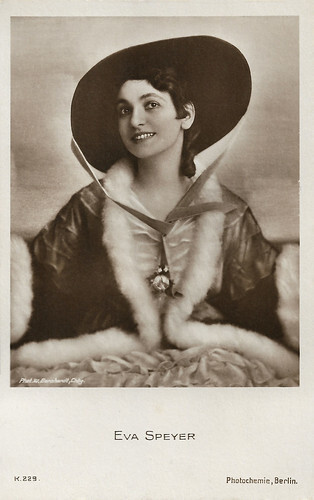
German postcard by Photochemie, Berlin, no. K. 229. Photo: W. Bernhardt, Chbg.
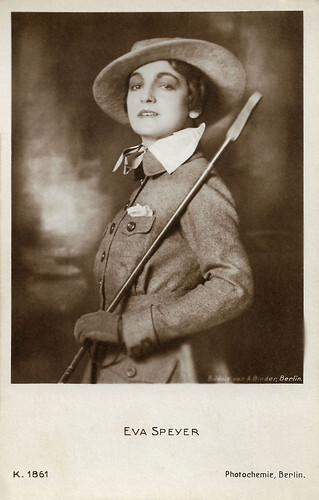
German postcard by Photochemie, Berlin, no. K. 1861. Photo: Alex Binder, Berlin.
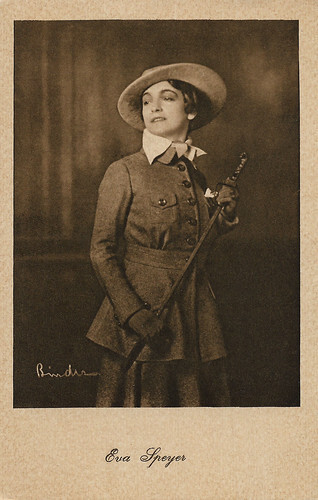
German postcard. Photo: Alex Binder.
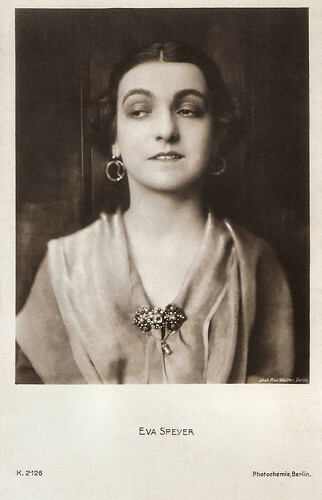
German postcard by Photochemie, Berlin no. K. 2126. Photo: Mac Walten, Berlin.
Suffering women in short melodramas
Eva Speyer was born Eva Esther Speier in 1883 in Berlin, Germany. She was the daughter of the stockbroker Fedor Speier and his wife, the milliner Wilhelmine, née Mahn.
Eva received her training as an actress at the Marie Seebach School and made her debut in Hirschberg in 1904. In 1905 she appeared in Posen and from 1906 to 1908 at the Schauspielhaus Düsseldorf. In 1908 she embarked for America and appeared on stage in Milwaukee and in 1909 in New York.
In November 1910 she returned to Germany and played at Berlin stages such as the Lessingtheater, Trianon-Theater, and the Kleines Theater. She got in touch with the film business by chance. During an engagement at the Lessingtheater, she was asked by Paul Otto to play in the silent film Nora (1911).
The new medium film was becoming commercially successful in Germany. Thomas Staedeli at Cyranos : "She viewed the new medium as a welcome extra income without artistic challenge. When the technological basis improved considerably she changed her attitude to the film and saw the possibility to make the art accessible to the audience in an easy way."
In the next years, Speyer developed into one of the first stars of the German silent cinema. She played suffering women in such short melodramas as Die gelbe Rasse/The yellow breed (Max Mack, 1912), Dämonen der Tiefe/Demons of the Deep (Harry Piel, 1912), and Zwischen Himmel und Erde/'Tween Heaven and Earth (Otto Rippert, 1913) with Ernst Rückert .
During World War I, Eva starred in films like Der Geisterseher/The Ghost Seer (Waldemar Hecker, 1915), Der Talismann/The Talisman (Eddie Seefeld, 1915), Die Flucht des Arno Jessen/The Flight of Arno Jessen (Richard Eichberg, 1917) starring Ernst Rückert , and Es werde Licht! 2. Teil/Let there be light. Part 2 (Richard Oswald, 1918).
Spyer also played the female lead in the silent Science-Fiction film Die Arche/The Ark (Richard Oswald, 1919) starring Leo Connard. This is a two-part German epic about a near future in which civilisation has been destroyed.
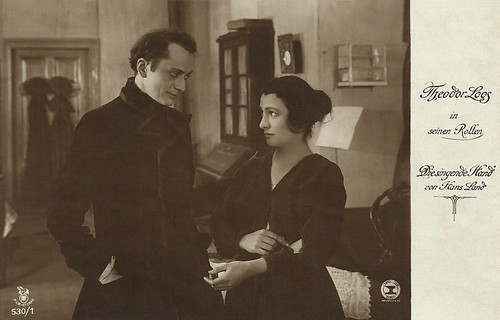
German postcard by Rotophot in the Film-Sterne series, no. 530/1. Photo: Amboß-Film Dworsky & Co. Theodor Loos and Eva Speyer in Die singende Hand (Arthur Wellin, 1918). Hans Land was the pseudonym of Hugo Landsberger, who scripted the film.
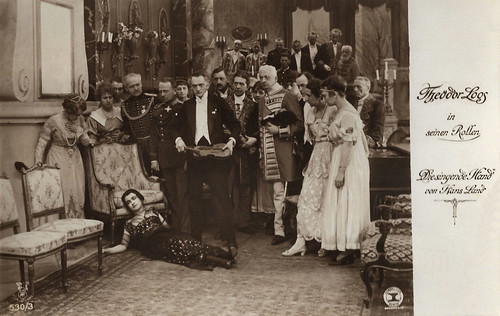
German postcard by Rotophot in the Film-Sterne series, no. 530/3. Photo: Amboß-Film Dworsky & Co. Theodor Loos as the violin player Leonid Heller in Die singende Hand (Arthur Wellin, 1918). The woman on the ground is Eva Speyer as Esther. The man left of Loos is Otto Gebühr , playing the Duke of Gralby.
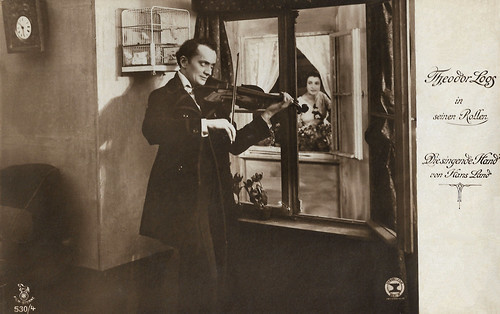
German postcard by Rotophot in the Film-Sterne series, no. 530/4. Photo: Amboß-Film Dworsky & Co. Theodor Loos in Die singende Hand (Arthur Wellin, 1918). The woman is Eva Speyer.
A character actress in many well-known films
From the 1920s onwards, Eva Speyer's days as a star were over but she proved her talent as a character actress in many well-known films. These included § 182 minderjährig/Paragraph 182 (Ernst Winar, 1927) starring Colette Brettel , Dirnentragödie/Tragedy of the Street (Bruno Rahn, 1927) starring Asta Nielsen , and Unter der Laterne/Under the Lantern (Gerhard Lamprecht, 1928) starring Lissy Arna .
In the drama Jugendtragödie/Tragedy of Youth (Adolf Trotz, 1929), she played a washerwoman, whose son ( Roland Varno ) is sent to a reform school for a minor crime. He breaks out and commits a murder.
During the sound era, Speyer appeared in three more films, Namensheirat/Marriage in Name Only (Heinz Paul, 1930) with Evelyn Holt , the comedy Ich bleib bei Dir/I stay with you (Johannes Meyer, 1932), and the drugs drama Der weisse Dämon/The White Demon (Kurt Gerron, 1932) starring Hans Albers .
Speyer was initially married to the actor Otto Stöckl and was therefore also known as Eva Speyer-Stöckl. In 1918, she wed merchant Robert Ebert in her second marriage. About what happened to her after 1932, the sources differ.
According to German Wikipedia , she was completely excluded from public culture because of her Jewish descent after the National Socialists came to power in 1933 and probably emigrated a short time later.
However, Italian Wikipedia quotes IMDb that indicates that the actress died in 1932 at the age of 50. Where is unknown. Filmportal.de confirms this date.
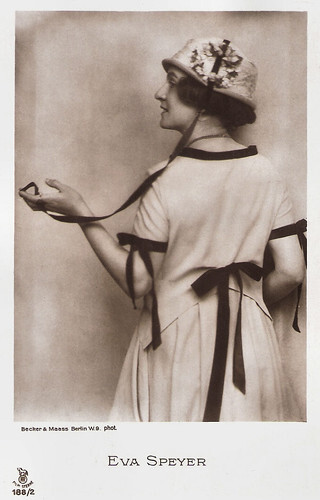
German postcard in the Film Sterne Series by Rotophot, no. 188/2. Photo: Becker & Maass.
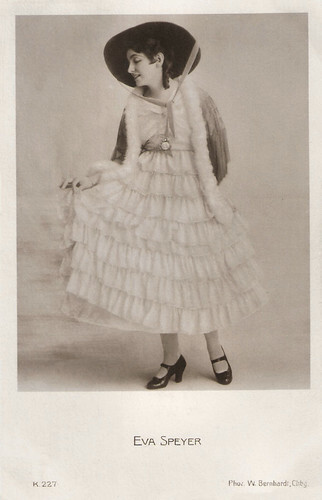
German postcard by Photochemie, Berlin, no. K. 227. Photo: W. Bernhardt, Chbg.
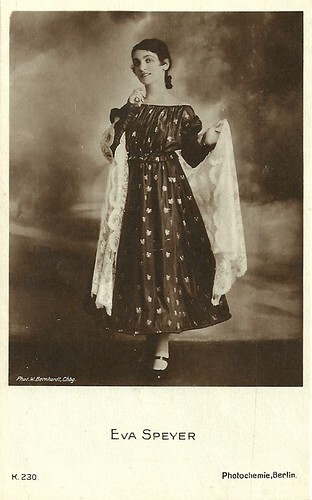
German postcard by Photochemie, Berlin, no. K. 230. Photo: W. Bernhardt, Chbg.
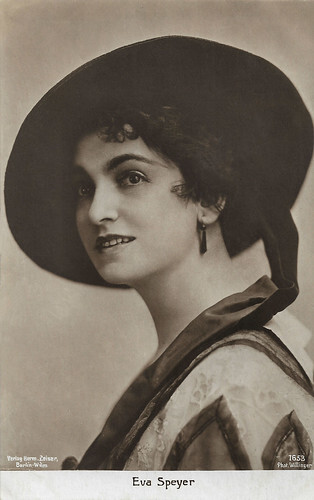
German postcard by Verlag Herm. Leiser, Berlin-Wilm., no. 1653. Photo: Willinger.
Sources: Thomas Staedeli (Cyranos), Filmportal.de, Wikipedia (English, German and Italian), and .

German postcard by Photochemie, Berlin, no. K. 229. Photo: W. Bernhardt, Chbg.

German postcard by Photochemie, Berlin, no. K. 1861. Photo: Alex Binder, Berlin.

German postcard. Photo: Alex Binder.

German postcard by Photochemie, Berlin no. K. 2126. Photo: Mac Walten, Berlin.
Suffering women in short melodramas
Eva Speyer was born Eva Esther Speier in 1883 in Berlin, Germany. She was the daughter of the stockbroker Fedor Speier and his wife, the milliner Wilhelmine, née Mahn.
Eva received her training as an actress at the Marie Seebach School and made her debut in Hirschberg in 1904. In 1905 she appeared in Posen and from 1906 to 1908 at the Schauspielhaus Düsseldorf. In 1908 she embarked for America and appeared on stage in Milwaukee and in 1909 in New York.
In November 1910 she returned to Germany and played at Berlin stages such as the Lessingtheater, Trianon-Theater, and the Kleines Theater. She got in touch with the film business by chance. During an engagement at the Lessingtheater, she was asked by Paul Otto to play in the silent film Nora (1911).
The new medium film was becoming commercially successful in Germany. Thomas Staedeli at Cyranos : "She viewed the new medium as a welcome extra income without artistic challenge. When the technological basis improved considerably she changed her attitude to the film and saw the possibility to make the art accessible to the audience in an easy way."
In the next years, Speyer developed into one of the first stars of the German silent cinema. She played suffering women in such short melodramas as Die gelbe Rasse/The yellow breed (Max Mack, 1912), Dämonen der Tiefe/Demons of the Deep (Harry Piel, 1912), and Zwischen Himmel und Erde/'Tween Heaven and Earth (Otto Rippert, 1913) with Ernst Rückert .
During World War I, Eva starred in films like Der Geisterseher/The Ghost Seer (Waldemar Hecker, 1915), Der Talismann/The Talisman (Eddie Seefeld, 1915), Die Flucht des Arno Jessen/The Flight of Arno Jessen (Richard Eichberg, 1917) starring Ernst Rückert , and Es werde Licht! 2. Teil/Let there be light. Part 2 (Richard Oswald, 1918).
Spyer also played the female lead in the silent Science-Fiction film Die Arche/The Ark (Richard Oswald, 1919) starring Leo Connard. This is a two-part German epic about a near future in which civilisation has been destroyed.

German postcard by Rotophot in the Film-Sterne series, no. 530/1. Photo: Amboß-Film Dworsky & Co. Theodor Loos and Eva Speyer in Die singende Hand (Arthur Wellin, 1918). Hans Land was the pseudonym of Hugo Landsberger, who scripted the film.

German postcard by Rotophot in the Film-Sterne series, no. 530/3. Photo: Amboß-Film Dworsky & Co. Theodor Loos as the violin player Leonid Heller in Die singende Hand (Arthur Wellin, 1918). The woman on the ground is Eva Speyer as Esther. The man left of Loos is Otto Gebühr , playing the Duke of Gralby.

German postcard by Rotophot in the Film-Sterne series, no. 530/4. Photo: Amboß-Film Dworsky & Co. Theodor Loos in Die singende Hand (Arthur Wellin, 1918). The woman is Eva Speyer.
A character actress in many well-known films
From the 1920s onwards, Eva Speyer's days as a star were over but she proved her talent as a character actress in many well-known films. These included § 182 minderjährig/Paragraph 182 (Ernst Winar, 1927) starring Colette Brettel , Dirnentragödie/Tragedy of the Street (Bruno Rahn, 1927) starring Asta Nielsen , and Unter der Laterne/Under the Lantern (Gerhard Lamprecht, 1928) starring Lissy Arna .
In the drama Jugendtragödie/Tragedy of Youth (Adolf Trotz, 1929), she played a washerwoman, whose son ( Roland Varno ) is sent to a reform school for a minor crime. He breaks out and commits a murder.
During the sound era, Speyer appeared in three more films, Namensheirat/Marriage in Name Only (Heinz Paul, 1930) with Evelyn Holt , the comedy Ich bleib bei Dir/I stay with you (Johannes Meyer, 1932), and the drugs drama Der weisse Dämon/The White Demon (Kurt Gerron, 1932) starring Hans Albers .
Speyer was initially married to the actor Otto Stöckl and was therefore also known as Eva Speyer-Stöckl. In 1918, she wed merchant Robert Ebert in her second marriage. About what happened to her after 1932, the sources differ.
According to German Wikipedia , she was completely excluded from public culture because of her Jewish descent after the National Socialists came to power in 1933 and probably emigrated a short time later.
However, Italian Wikipedia quotes IMDb that indicates that the actress died in 1932 at the age of 50. Where is unknown. Filmportal.de confirms this date.

German postcard in the Film Sterne Series by Rotophot, no. 188/2. Photo: Becker & Maass.

German postcard by Photochemie, Berlin, no. K. 227. Photo: W. Bernhardt, Chbg.

German postcard by Photochemie, Berlin, no. K. 230. Photo: W. Bernhardt, Chbg.

German postcard by Verlag Herm. Leiser, Berlin-Wilm., no. 1653. Photo: Willinger.
Sources: Thomas Staedeli (Cyranos), Filmportal.de, Wikipedia (English, German and Italian), and .
Published on May 29, 2022 22:00
May 28, 2022
Marthe Keller
Beautiful Swiss actress Marthe Keller (1945) appeared in several French, Italian and German films but she became a star when she played a beautiful princess in the TV series La demoiselle d'Avignon/The lady of Avignon (1972). She then seemed to make it big in Hollywood with an award-winning role in Marathon Man (1976) and a much-publicised affair with Al Pacino. But the failure of Fedora (1978) halted a major international film career. She continued to act in European productions, and since 1999, she has had a new career as an opera director.
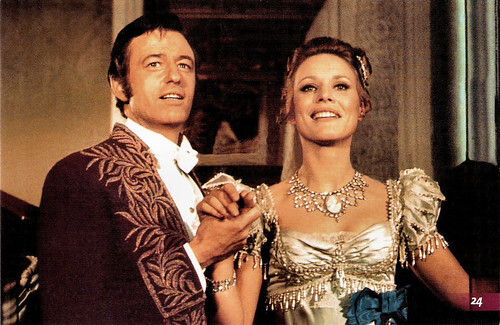
French postcard by Editions Atlas, Evreux, no. 24. Photo: Marthe Keller and Louis Velle in the TV series La demoiselle d'Avignon/The lady of Avignon (Michel Wyn, 1972).

Romanian postcard by Casa Filmului Acin.
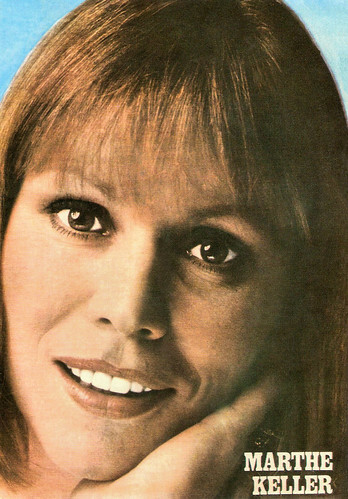
Romanian postcard by Casa Filmului Acin, no. 570.
Koba Lye-Lye
Marthe Keller was born on a horse farm located near Basel, Switzerland in 1945. She studied ballet as a child, but stopped after a skiing accident at age 16 and changed to acting. She studied three years at the Stanislavsky School in Munich and meanwhile modeled to pay the rent.
She worked in Berlin at the Schiller Theater and the Berliner Ensemble. From 1964 on, Keller appeared in German TV films like Der trojanische Krieg findet nicht statt/The Trojan war will not take place (Franz Josef Wild, 1964) and Corinne und der Seebär/Corinne and the Fur Seal (Thomas Engel, 1966).
Keller's film debut was an uncredited bit part in the Spy thriller Funeral in Berlin (Guy Hamilton, 1966) starring Michael Caine . She had a bigger role in the German film comedy Wilder Reiter GmbH/Wild Rider Ltd. (Franz-Josef Spieker, 1967).
In 1968 she moved to Paris. In France, she appeared in the comedy Le diable par la queue/The Devil by the Tail (Philippe de Broca, 1969) starring Yves Montand . She and director Philippe de Broca started a relationship. She played the title role in his romantic comedy Les caprices de Marie/Give Her the Moon (Philippe de Broca, 1970), and in 1971 their son, Alexandre was born.
In Paris, she also played on stage as Sheila in Peter Nichols's 'Un jour dans la mort de Joe Egg' (A Day in the Death of Joe Egg) (1970). For this part, she was awarded the French Critics' Award for the best stage performance. In the following years, she appeared in a series of French films, including Un cave/A Loser (Gilles Grangier, 1971) opposite Claude Brasseur , and the comedy La vieille fille/The Old Maid (Jean-Pierre Blanc, 1972) starring Annie Girardot .
Another medium made her a star though. She won the hearts of millions of European TV viewers as Princess Kristina of Kurland aka Koba Lye-Lye in the popular series La demoiselle d'Avignon/The lady of Avignon (Michel Wyn, 1972). Nicholas Rhodes reviews it at IMDb : “This series is a piece of pure magic (...) and captivated the whole of France (99.4 percent of satisfied viewers at the time!). Although the picture quality is pretty bad, the story itself and the sets are absolutely magnificent. It's all about a love affair between a Frenchman whose mother owns a chateau near Avignon and a princess from the imaginary country of ‘Kurland'”
She followed the successful series with a leading role in the romance Toute une vie/And Now My Love (Claude Lelouch, 1974), and a part opposite Marcello Mastroianni in the Italian-French drama Per le antiche scale/Down the Ancient Staircase (Mauro Bolognini, 1975).
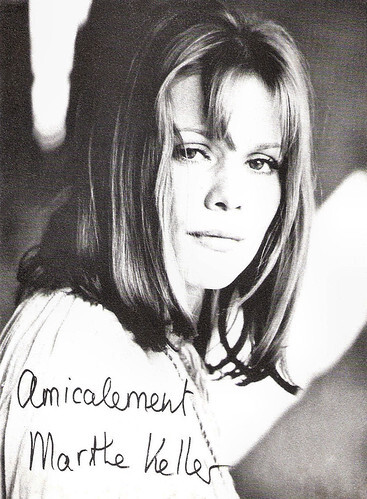
French postcard by La Roue Tourne, Paris.
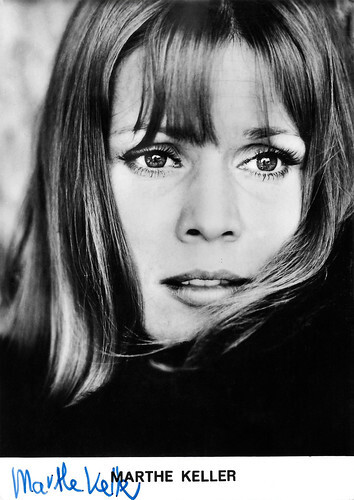
French postcard by Editions P.I., Paris, no. 2534.
Al Pacino
In the mid-1970s Marthe Keller made the cross-over to Hollywood. She played Dustin Hoffman 's girlfriend in the thriller Marathon Man (John Schlesinger, 1976). The film became a huge hit and Keller was nominated for a Golden Globe for Best Supporting Actress. Then she played a femme fatale Arab terrorist who leads an attack on the Super Bowl in the suspense thriller Black Sunday (John Frankenheimer, 1977).
Next, she appeared alongside Al Pacino in the auto racing film Bobby Deerfield (Sydney Pollack, 1977), and subsequently, the two stars were involved in a relationship. She garnered a great deal of publicity from these movies and from her love affair with Pacino.
Keller’s next film was expected to make her a major star. Hollywood legend Billy Wilder was making Fedora (1978), based on Tom Tryon’s bestseller 'Crowned Heads' about old Hollywood and the old star system, and offered her the title role opposite William Holden.
Jon C. Hopwood in his IMDb bio describes what went wrong: “Wilder had wanted to cast Faye Dunaway as ‘Fedora’, a pastiche of Greta Garbo and Marlene Dietrich (...) He expected the actress to play the fictional movie queen both in her youthful incarnation and as an older woman (now known as ‘Countess Sobryanski’). When Dunaway passed on the part, the red-hot Keller was cast in the movie.
However, Wilder was dismayed when the makeup prepared to transform Keller into the older Fedora (as Countess Sobryanski) aggravated a large scar on her forehead and caused so much pain that she couldn't act under those conditions. Wilder was forced to cast an older actress ( Hildegard Knef ) as the Countess. Wilder and Keller never established a good working relationship, with the result that her poor performance essentially was blamed for the failure of the film both artistically and at the box office.”
Marthe Keller appeared in just one more Hollywood production, the thriller The Formula (John G. Avilssen, 1980) with George C. Scott and Marlon Brando , and in 1982 she returned to Europe.
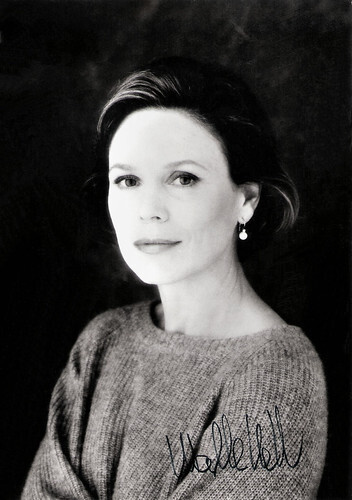
French postcard by Editions P.I., Ivry/Seine. Photo: Fabian / Sygma.
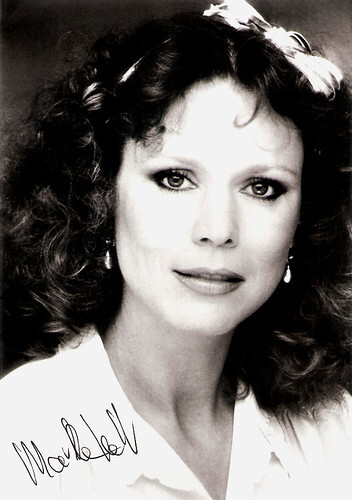
French postcard by Editions P.I., Paris, no. 3740. Photo: Sygma.
Opera Director
Since then, Marthe Keller mainly worked in European cinema and for TV. Mauro Bolognini directed her again in the Mini-series La certosa di Parma/The Charterhouse of Parma (1982), based on the novel by Stendhal and co-starring Gian Maria Volonté. She reunited with Marcello Mastroianni in Oci Cionie/Dark Eyes (Nikita Mikhalkov, 1987), which was nominated for the Oscar for Best Foreign Language Film, and in Sostiene Pereira/According to Pereira (Roberto Faenza, 1995).
Interesting is also the Yukio Mishima adaptation L'école de la chair/The School of Flesh (Benoit Jacquot, 1998) in which she appeared with Isabelle Huppert . In 2001, Keller appeared in a Broadway adaptation of Abby Mann's play 'Judgment at Nuremberg' as Mrs. Bertholt, the role played by Marlene Dietrich in the 1961 film version. She was nominated for a Tony Award as Best Featured Actress for this performance.
In addition to her work in film and theatre, Keller has developed a career in classical music as a speaker and opera director. She has performed the speaking role of Joan of Arc in the oratorio 'Jeanne d'Arc au Bûcher' of Arthur Honegger on several occasions, with conductors such as Seiji Ozawa and Kurt Masur. She has recorded the role for Deutsche Grammophon with Ozawa. Keller has also recited the spoken part in Igor Stravinsky's 'Perséphone'.
She has performed classical music melodramas for speaker and piano in recital. The Swiss composer Michael Jarrell wrote the melodrama 'Cassandre', after the novel of Christa Wolf, for Keller, who gave the world premiere in 1994. Keller's first production as an opera director was 'Dialogues des Carmélites', for Opéra National du Rhin, in 1999. This production subsequently received a semi-staged performance in London that year. She has also directed 'Lucia di Lammermoor' for the Washington National Opera and for the Los Angeles Opera. Her directorial debut at the Metropolitan Opera was in a 2004 production of 'Don Giovanni.
She also worked again as a film actress and was seen in a small role in Clint Eastwood ’s fantasy drama Hereafter (2010) starring Cécile de France and Matt Damon. It was followed by a bigger role in the German WW II comedy Mein bester Feind/My Best Enemy (Wolfgang Murnberger, 2011) starring Moritz Bleibtreu, the Belgian drama Les géants/The Giants (Bouli Lanners, 2011), and the BBC TV thriller Page Eight (David Hare, 2011) starring Bill Nighy. In 2012 the French government named her Chevalier de la Légion d'honneur.
Since then, Marthe Keller appeared in several films including Amnesia (Barbet Schroeder, 2015), The Witness (Mitko Panov, 2018), both with Bruno Ganz , Schwesterlein/My Little Sister (Stéphanie Chuat, Véronique Reymond, 2020), starring Nina Hoss , and the upcoming Tout le monde aime Jeanne/Everybody Loves Jeanne (Céline Devaux, 2022). Keller has one son, Alexandre (born in 1971), from her relationship with director Philippe de Broca.
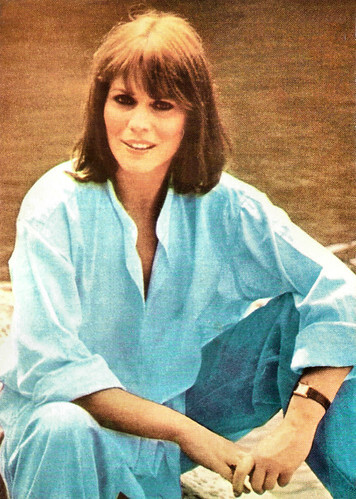
Romanian postcard by Casa Filmului Acin.
Leader for La demoiselle d'Avignon/The lady of Avignon (1972). Source: Génération Générique (YouTube).
Trailer Marathon Man (1976). Source: Worley Clarence (YouTube).
Sources: (IMDb), Sandra Brennan (AllMovie), Wikipedia, and .

French postcard by Editions Atlas, Evreux, no. 24. Photo: Marthe Keller and Louis Velle in the TV series La demoiselle d'Avignon/The lady of Avignon (Michel Wyn, 1972).

Romanian postcard by Casa Filmului Acin.

Romanian postcard by Casa Filmului Acin, no. 570.
Koba Lye-Lye
Marthe Keller was born on a horse farm located near Basel, Switzerland in 1945. She studied ballet as a child, but stopped after a skiing accident at age 16 and changed to acting. She studied three years at the Stanislavsky School in Munich and meanwhile modeled to pay the rent.
She worked in Berlin at the Schiller Theater and the Berliner Ensemble. From 1964 on, Keller appeared in German TV films like Der trojanische Krieg findet nicht statt/The Trojan war will not take place (Franz Josef Wild, 1964) and Corinne und der Seebär/Corinne and the Fur Seal (Thomas Engel, 1966).
Keller's film debut was an uncredited bit part in the Spy thriller Funeral in Berlin (Guy Hamilton, 1966) starring Michael Caine . She had a bigger role in the German film comedy Wilder Reiter GmbH/Wild Rider Ltd. (Franz-Josef Spieker, 1967).
In 1968 she moved to Paris. In France, she appeared in the comedy Le diable par la queue/The Devil by the Tail (Philippe de Broca, 1969) starring Yves Montand . She and director Philippe de Broca started a relationship. She played the title role in his romantic comedy Les caprices de Marie/Give Her the Moon (Philippe de Broca, 1970), and in 1971 their son, Alexandre was born.
In Paris, she also played on stage as Sheila in Peter Nichols's 'Un jour dans la mort de Joe Egg' (A Day in the Death of Joe Egg) (1970). For this part, she was awarded the French Critics' Award for the best stage performance. In the following years, she appeared in a series of French films, including Un cave/A Loser (Gilles Grangier, 1971) opposite Claude Brasseur , and the comedy La vieille fille/The Old Maid (Jean-Pierre Blanc, 1972) starring Annie Girardot .
Another medium made her a star though. She won the hearts of millions of European TV viewers as Princess Kristina of Kurland aka Koba Lye-Lye in the popular series La demoiselle d'Avignon/The lady of Avignon (Michel Wyn, 1972). Nicholas Rhodes reviews it at IMDb : “This series is a piece of pure magic (...) and captivated the whole of France (99.4 percent of satisfied viewers at the time!). Although the picture quality is pretty bad, the story itself and the sets are absolutely magnificent. It's all about a love affair between a Frenchman whose mother owns a chateau near Avignon and a princess from the imaginary country of ‘Kurland'”
She followed the successful series with a leading role in the romance Toute une vie/And Now My Love (Claude Lelouch, 1974), and a part opposite Marcello Mastroianni in the Italian-French drama Per le antiche scale/Down the Ancient Staircase (Mauro Bolognini, 1975).

French postcard by La Roue Tourne, Paris.

French postcard by Editions P.I., Paris, no. 2534.
Al Pacino
In the mid-1970s Marthe Keller made the cross-over to Hollywood. She played Dustin Hoffman 's girlfriend in the thriller Marathon Man (John Schlesinger, 1976). The film became a huge hit and Keller was nominated for a Golden Globe for Best Supporting Actress. Then she played a femme fatale Arab terrorist who leads an attack on the Super Bowl in the suspense thriller Black Sunday (John Frankenheimer, 1977).
Next, she appeared alongside Al Pacino in the auto racing film Bobby Deerfield (Sydney Pollack, 1977), and subsequently, the two stars were involved in a relationship. She garnered a great deal of publicity from these movies and from her love affair with Pacino.
Keller’s next film was expected to make her a major star. Hollywood legend Billy Wilder was making Fedora (1978), based on Tom Tryon’s bestseller 'Crowned Heads' about old Hollywood and the old star system, and offered her the title role opposite William Holden.
Jon C. Hopwood in his IMDb bio describes what went wrong: “Wilder had wanted to cast Faye Dunaway as ‘Fedora’, a pastiche of Greta Garbo and Marlene Dietrich (...) He expected the actress to play the fictional movie queen both in her youthful incarnation and as an older woman (now known as ‘Countess Sobryanski’). When Dunaway passed on the part, the red-hot Keller was cast in the movie.
However, Wilder was dismayed when the makeup prepared to transform Keller into the older Fedora (as Countess Sobryanski) aggravated a large scar on her forehead and caused so much pain that she couldn't act under those conditions. Wilder was forced to cast an older actress ( Hildegard Knef ) as the Countess. Wilder and Keller never established a good working relationship, with the result that her poor performance essentially was blamed for the failure of the film both artistically and at the box office.”
Marthe Keller appeared in just one more Hollywood production, the thriller The Formula (John G. Avilssen, 1980) with George C. Scott and Marlon Brando , and in 1982 she returned to Europe.

French postcard by Editions P.I., Ivry/Seine. Photo: Fabian / Sygma.

French postcard by Editions P.I., Paris, no. 3740. Photo: Sygma.
Opera Director
Since then, Marthe Keller mainly worked in European cinema and for TV. Mauro Bolognini directed her again in the Mini-series La certosa di Parma/The Charterhouse of Parma (1982), based on the novel by Stendhal and co-starring Gian Maria Volonté. She reunited with Marcello Mastroianni in Oci Cionie/Dark Eyes (Nikita Mikhalkov, 1987), which was nominated for the Oscar for Best Foreign Language Film, and in Sostiene Pereira/According to Pereira (Roberto Faenza, 1995).
Interesting is also the Yukio Mishima adaptation L'école de la chair/The School of Flesh (Benoit Jacquot, 1998) in which she appeared with Isabelle Huppert . In 2001, Keller appeared in a Broadway adaptation of Abby Mann's play 'Judgment at Nuremberg' as Mrs. Bertholt, the role played by Marlene Dietrich in the 1961 film version. She was nominated for a Tony Award as Best Featured Actress for this performance.
In addition to her work in film and theatre, Keller has developed a career in classical music as a speaker and opera director. She has performed the speaking role of Joan of Arc in the oratorio 'Jeanne d'Arc au Bûcher' of Arthur Honegger on several occasions, with conductors such as Seiji Ozawa and Kurt Masur. She has recorded the role for Deutsche Grammophon with Ozawa. Keller has also recited the spoken part in Igor Stravinsky's 'Perséphone'.
She has performed classical music melodramas for speaker and piano in recital. The Swiss composer Michael Jarrell wrote the melodrama 'Cassandre', after the novel of Christa Wolf, for Keller, who gave the world premiere in 1994. Keller's first production as an opera director was 'Dialogues des Carmélites', for Opéra National du Rhin, in 1999. This production subsequently received a semi-staged performance in London that year. She has also directed 'Lucia di Lammermoor' for the Washington National Opera and for the Los Angeles Opera. Her directorial debut at the Metropolitan Opera was in a 2004 production of 'Don Giovanni.
She also worked again as a film actress and was seen in a small role in Clint Eastwood ’s fantasy drama Hereafter (2010) starring Cécile de France and Matt Damon. It was followed by a bigger role in the German WW II comedy Mein bester Feind/My Best Enemy (Wolfgang Murnberger, 2011) starring Moritz Bleibtreu, the Belgian drama Les géants/The Giants (Bouli Lanners, 2011), and the BBC TV thriller Page Eight (David Hare, 2011) starring Bill Nighy. In 2012 the French government named her Chevalier de la Légion d'honneur.
Since then, Marthe Keller appeared in several films including Amnesia (Barbet Schroeder, 2015), The Witness (Mitko Panov, 2018), both with Bruno Ganz , Schwesterlein/My Little Sister (Stéphanie Chuat, Véronique Reymond, 2020), starring Nina Hoss , and the upcoming Tout le monde aime Jeanne/Everybody Loves Jeanne (Céline Devaux, 2022). Keller has one son, Alexandre (born in 1971), from her relationship with director Philippe de Broca.

Romanian postcard by Casa Filmului Acin.
Leader for La demoiselle d'Avignon/The lady of Avignon (1972). Source: Génération Générique (YouTube).
Trailer Marathon Man (1976). Source: Worley Clarence (YouTube).
Sources: (IMDb), Sandra Brennan (AllMovie), Wikipedia, and .
Published on May 28, 2022 22:00
May 27, 2022
Norman Kerry
Norman Kerry (1894–1956) was an American actor of the silent era, who peaked in the Lon Chaney films The Hunchback of the Notre Dame (1923), The Phantom of the Opera (1925), and The Unknown (1927).
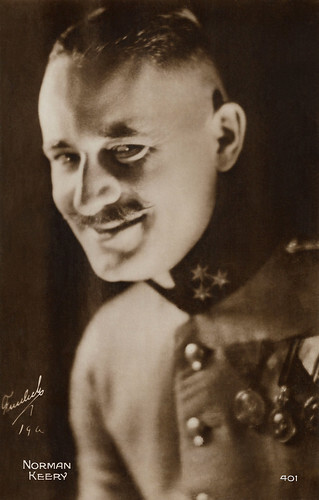
French postcard by Cinémagazine-Edition, no. 401. Photo: Roman Freulich. Norman Kerry in Merry-Go-Round (Rupert Julian, Erich von Stroheim, 1923). Norman Kerry's surname is misspelled on the card as Keery.
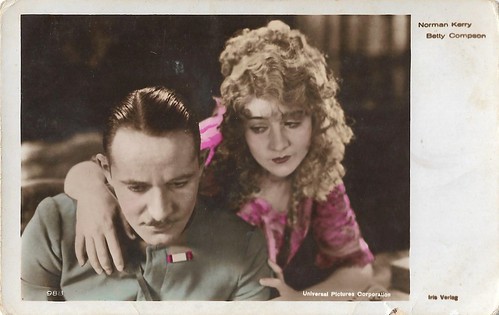
Austrian postcard by Iris Verlag, no. 988. Photo: Universal Pictures Corporation. Betty Compson and Norman Kerry in Love Me and the World Is Mine (Ewald André Dupont, 1927).
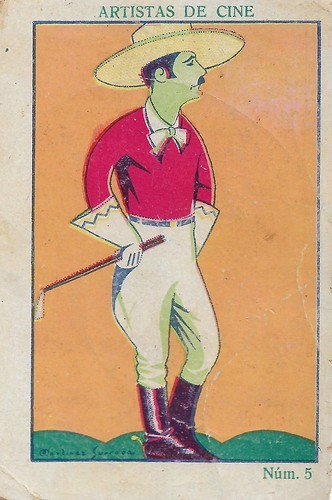
Spanish collectors card by Chocolates Amatller, Barcelona, in the 'Artistas de cine' series, no. 5: Norman Kerry. Image: Martinez Surroca.
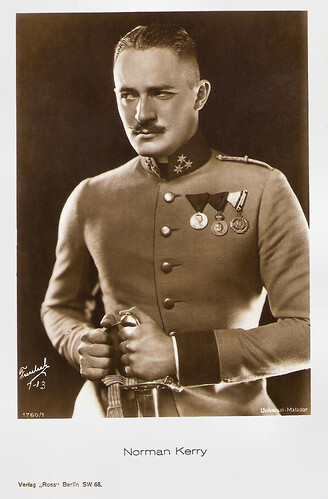
German postcard by Ross Verlag, Berlin, no. 1760/1, 1927-1928. Photo: Freulich / Universal-Matador. Norman Kerry in Merry-Go-Round (Rupert Julian, Erich von Stroheim, 1923).
A matinee idol with his slicked-back hair and thin, waxed mustache
Of German origin, Norman Kerry was born Arnold Kaiser in Rochester in New York State in 1894.
Kaiser began working as a clerk in the New York fur trade but felt that he had no aptitude for this type of work. He left everything and became a theatrical agent. Kaiser changed his name to Norman Kerry during the First World War.
In 1916, he met Rudolph Valentino , and the two soon became friends. It was Kerry who advised the Italian to try his hand at the young film industry. Kerry played his first part in the Douglas Fairbanks film Manhattan Madness (Allan Dwan, 1916).
Immediately after his film debut, he had an important lead in the Mary Pickford film A Little Princess (Marshall Neilan, 1917). A second success followed with the Constance Talmadge film Up the Road with Sallie (William Desmond Taylor, 1918).
Norman Kerry became a matinee idol with his slicked-back hair and thin, waxed mustache.
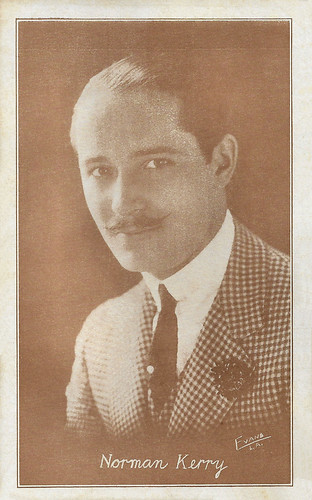
American postcard. Photo: Evans, L.A.
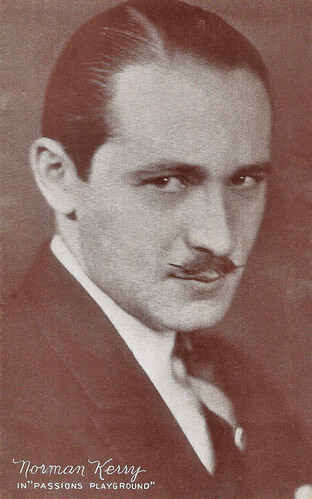
American postcard. Norman Kerry in Passion's Playgroun (J.A. Barry, 1920).
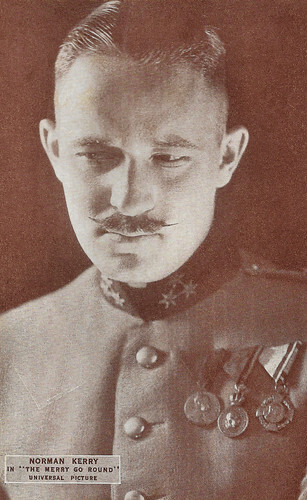
American postcard. Photo: Universal. Norman Kerry in Merry-Go-Round (Erich von Stroheim, 1923).
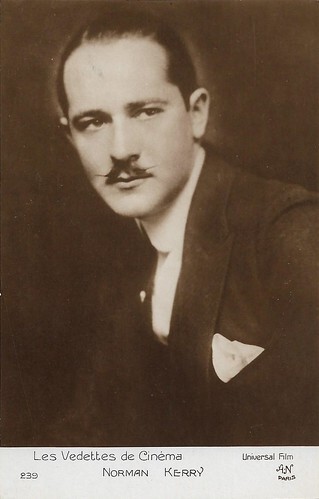
French postcard in the Les Vedettes de Cinéma series by A.N., Paris, no. 239. Photo: Universal Film.
An aristocrat posing as a salesman
His popularity peaked in 1923, when he acted as the dashing Captain Phoebus in The Hunchback of Notre Dame (Wallace Worsley, 1923), starring Lon Chaney and Patsy Ruth Miller, and as the aristocrat posing as a salesman in Merry-Go-Round (Erich von Stroheim, Rupert Julian, 1923), with Mary Philbin as his love interest.
Norman Kerry was again paired with Philbin in another Lon Chaney classic, The Phantom of the Opera (Rupert Julian, 1925). The third get-together with Chaney happened with the bizarre horror film The Unknown (Tod Browning, 1927), starring Chaney and Joan Crawford . Kerry plays Chaney's rival as a strongman, risking being ripped apart in a circus act when Chaney's character takes revenge for having needlessly removed his both own arms.
Kerry continued to appear in several films and alongside the leading actresses of the moment, including Lillian Gish in Annie Laurie (John S. Robertson, 1927), Bebe Daniels , Irene Rich , Eleanor Boardman , Corinne Griffith , Pauline Starke, Aileen Pringle , and many others.
Norman Kerry was not so lucky in his personal life as he married three times. With the advent of sound cinema, he did not have the desired success, and after 1931 he stopped. Having acted in the film The Foreign Legion (Edward Sloman, 1928), Kerry drew his conclusions and joined the real French Foreign Legion.
He returned to the United States only in 1940, when France was invaded by Hitler's Nazi army, and acted in one last film. Norman Kerry died in Los Angeles in 1956, at the age of 61, the victim of liver disease.
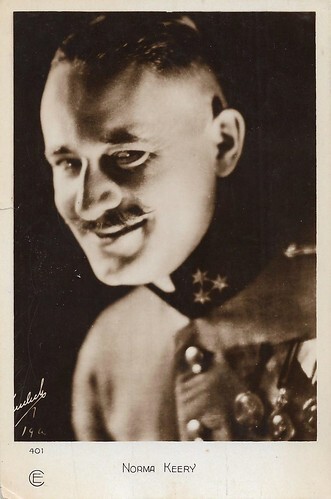
French postcard by Cinémagazine-Edition, no. 401. Photo: Roman Freulich. Norman Kerry in Merry-Go-Round (Rupert Julian, Erich von Stroheim, 1923). Norman Kerry's name is misspelled and sexchanged into Norma Keery.
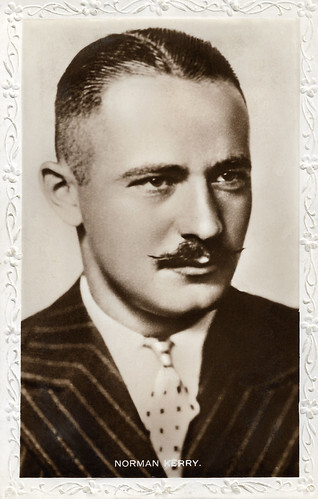
British Real Photograph postcard.
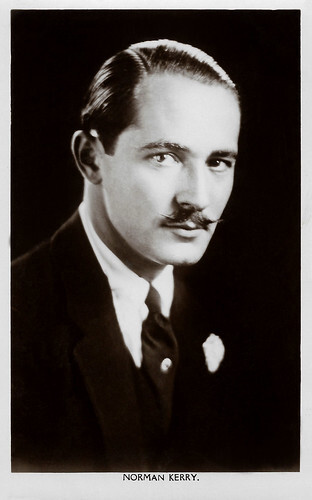
British postcard in the Picturegoer Series, London, no. 121.
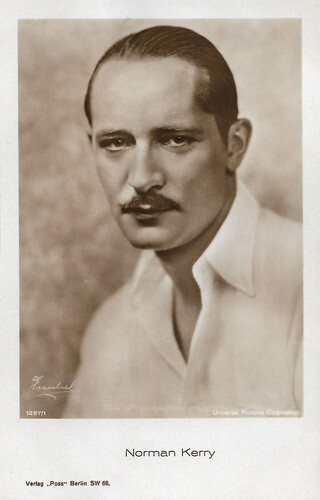
German postcard by Ross Verlag, Berlin, no. 1287/1, 1927-1928. Photo: Roman Freulich / Universal Pictures Corporation.

Austrian postcard by Iris Verlag, no. 988. Photo: Universal Pictures Corporations. Norman Kerry and Betty Compson in Love Me and the World Is Mine (Ewald André Dupont, 1927).
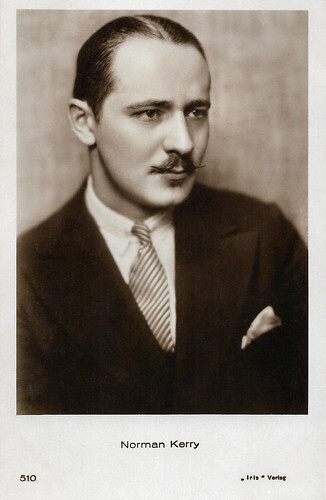
Austrian postcard by Iris-Verlag, Berlin, no. 510.
Sources: Wikipedia (English and Italian), and .

French postcard by Cinémagazine-Edition, no. 401. Photo: Roman Freulich. Norman Kerry in Merry-Go-Round (Rupert Julian, Erich von Stroheim, 1923). Norman Kerry's surname is misspelled on the card as Keery.

Austrian postcard by Iris Verlag, no. 988. Photo: Universal Pictures Corporation. Betty Compson and Norman Kerry in Love Me and the World Is Mine (Ewald André Dupont, 1927).

Spanish collectors card by Chocolates Amatller, Barcelona, in the 'Artistas de cine' series, no. 5: Norman Kerry. Image: Martinez Surroca.

German postcard by Ross Verlag, Berlin, no. 1760/1, 1927-1928. Photo: Freulich / Universal-Matador. Norman Kerry in Merry-Go-Round (Rupert Julian, Erich von Stroheim, 1923).
A matinee idol with his slicked-back hair and thin, waxed mustache
Of German origin, Norman Kerry was born Arnold Kaiser in Rochester in New York State in 1894.
Kaiser began working as a clerk in the New York fur trade but felt that he had no aptitude for this type of work. He left everything and became a theatrical agent. Kaiser changed his name to Norman Kerry during the First World War.
In 1916, he met Rudolph Valentino , and the two soon became friends. It was Kerry who advised the Italian to try his hand at the young film industry. Kerry played his first part in the Douglas Fairbanks film Manhattan Madness (Allan Dwan, 1916).
Immediately after his film debut, he had an important lead in the Mary Pickford film A Little Princess (Marshall Neilan, 1917). A second success followed with the Constance Talmadge film Up the Road with Sallie (William Desmond Taylor, 1918).
Norman Kerry became a matinee idol with his slicked-back hair and thin, waxed mustache.

American postcard. Photo: Evans, L.A.

American postcard. Norman Kerry in Passion's Playgroun (J.A. Barry, 1920).

American postcard. Photo: Universal. Norman Kerry in Merry-Go-Round (Erich von Stroheim, 1923).

French postcard in the Les Vedettes de Cinéma series by A.N., Paris, no. 239. Photo: Universal Film.
An aristocrat posing as a salesman
His popularity peaked in 1923, when he acted as the dashing Captain Phoebus in The Hunchback of Notre Dame (Wallace Worsley, 1923), starring Lon Chaney and Patsy Ruth Miller, and as the aristocrat posing as a salesman in Merry-Go-Round (Erich von Stroheim, Rupert Julian, 1923), with Mary Philbin as his love interest.
Norman Kerry was again paired with Philbin in another Lon Chaney classic, The Phantom of the Opera (Rupert Julian, 1925). The third get-together with Chaney happened with the bizarre horror film The Unknown (Tod Browning, 1927), starring Chaney and Joan Crawford . Kerry plays Chaney's rival as a strongman, risking being ripped apart in a circus act when Chaney's character takes revenge for having needlessly removed his both own arms.
Kerry continued to appear in several films and alongside the leading actresses of the moment, including Lillian Gish in Annie Laurie (John S. Robertson, 1927), Bebe Daniels , Irene Rich , Eleanor Boardman , Corinne Griffith , Pauline Starke, Aileen Pringle , and many others.
Norman Kerry was not so lucky in his personal life as he married three times. With the advent of sound cinema, he did not have the desired success, and after 1931 he stopped. Having acted in the film The Foreign Legion (Edward Sloman, 1928), Kerry drew his conclusions and joined the real French Foreign Legion.
He returned to the United States only in 1940, when France was invaded by Hitler's Nazi army, and acted in one last film. Norman Kerry died in Los Angeles in 1956, at the age of 61, the victim of liver disease.

French postcard by Cinémagazine-Edition, no. 401. Photo: Roman Freulich. Norman Kerry in Merry-Go-Round (Rupert Julian, Erich von Stroheim, 1923). Norman Kerry's name is misspelled and sexchanged into Norma Keery.

British Real Photograph postcard.

British postcard in the Picturegoer Series, London, no. 121.

German postcard by Ross Verlag, Berlin, no. 1287/1, 1927-1928. Photo: Roman Freulich / Universal Pictures Corporation.

Austrian postcard by Iris Verlag, no. 988. Photo: Universal Pictures Corporations. Norman Kerry and Betty Compson in Love Me and the World Is Mine (Ewald André Dupont, 1927).

Austrian postcard by Iris-Verlag, Berlin, no. 510.
Sources: Wikipedia (English and Italian), and .
Published on May 27, 2022 22:00
May 26, 2022
Moderne Schönheitsgalerie
During the 1920s and 1930s, Ross Verlag in Berlin produced some colourful collectors card series for several cigarette factories in Germany. 'Unsere Bunten Filmbilder' (Our Colourful Film Images) is a well-known example, 'Moderne Schönheitsgalerie' (Modern Beauty Gallery) is another. Ross Verlag produced three series of 300 small cards for the Garbaty Cigarette Company as a supplement for their 'Edelzigarette' (precious cigarettes): 'Moderne Schönheitsgalerie' in 1934, 'Galerie Schöner-Frauen Des Films' (Gallery of Beautiful Women in Film) in 1936, and Film-Lieblinge (Film Favorites) in 1937. These cigarette cards of glamorous female film stars from Hollywood and Germany are wonderful miniatures. Each card is in full colour, is embossed with an individual pattern, and has a varnish coat. We reproduce nine of them, bigger-than-life.
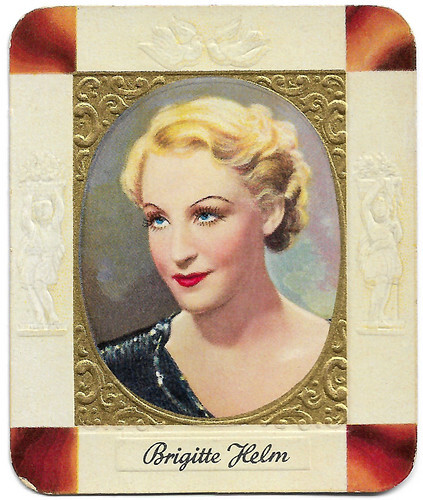
German collectors card in the Moderne Schönheitsgalerie Series by Ross Verlag, no 6 (of 300). Photo: Ufa. The card was a supplement to 'Edelzigarette' Kurmark of the Garbaty Cigarette Company.
German actress Brigitte Helm (1908-1996) is still famous for her dual role as Maria and her double the evil Maria, the Maschinenmensch, in the silent SF classic Metropolis (Fritz Lang, 1927). After Metropolis she made a string of over 30 films in which she almost always had the starring role. She easily made the transition to sound films, before she abruptly retired in 1935.
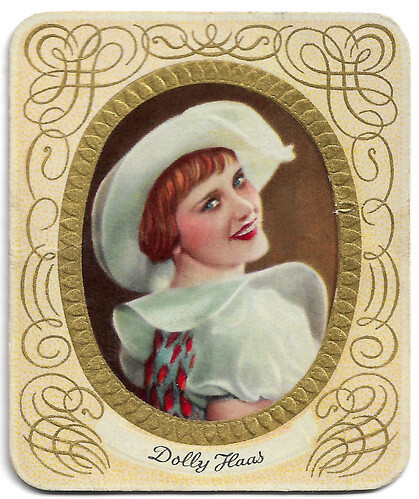
German collectors card in the Moderne Schönheitsgalerie by Ross Verlag for 'Edelzigarette' Kurmark of the Garbaty Cigarette Company, no. 55. Photo: Hisa-Film.
German-born, British stage and screen actress Dolly Haas (1910-1994) was popular in the 1930s as a vivacious, red-haired gamine often wearing trousers in German and British films. Although she got a 3-year contract with Columbia and she worked in Hollywood with Alfred Hitchcock, Dolly's American career mainly took place on and Off-Broadway.
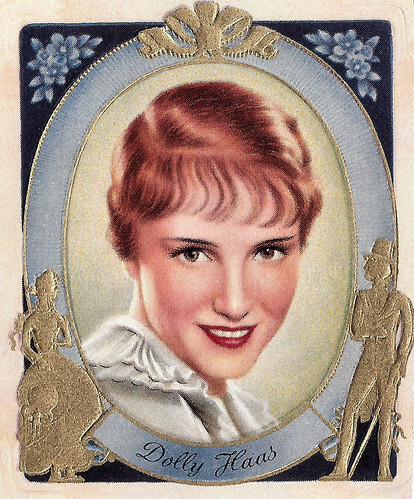
German collectors card in the Moderne Schönheitsgalerie by Ross Verlag for 'Edelzigarette' Kurmark of the Garbaty Cigarette Company, no. 56. Photo: Dolly Haas in Warum lügt Fräulein Käthe?/Why is Miss Käthe lying? (Georg Jacoby, 1935).
The Jewish Garbaty Family
In the 1930s, the Nazi regime in Germany was not happy with Hollywood. One of the reasons was the Jewish background of many of the Hollywood studio moguls, another was the themes of the films.
However, American movies, and their stars, were quite popular with German audiences, and it wasn't until late in the decade that Hollywood studio product was heavily suppressed.
The Garbaty family, which had owned the cigarette firm for nearly half a century, was Jewish. In late 1938, the Nazis staged Kristallnacht, where several hundred Jews were murdered and their property seized.
Owner Moritz Garbaty hid out at the home of his Catholic secretary, and his wife and 8-year-old son Thomas were visited by the Gestapo, which was seeking his father.
Several days later, Moritz was reunited with his family; he sold the company for a fraction of its worth and left for America, securing the family's safety with a million-dollar bribe to authorities. The family survived in the USA.
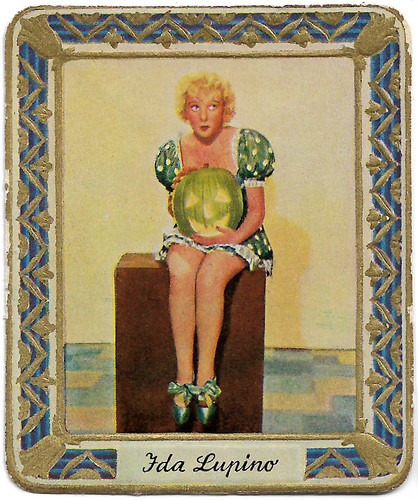
German collectors card in the Moderne Schönheitsgalerie series by Ross Verlag for 'Edelzigarette' Kurmark of the Garbaty Cigarette Company, no. 142. Photo: Paramount.
Ida Lupino (1918-1995) was an English-American actress and singer, who became a pioneering director and producer — the only woman working within the 1950s Hollywood studio system to do so.
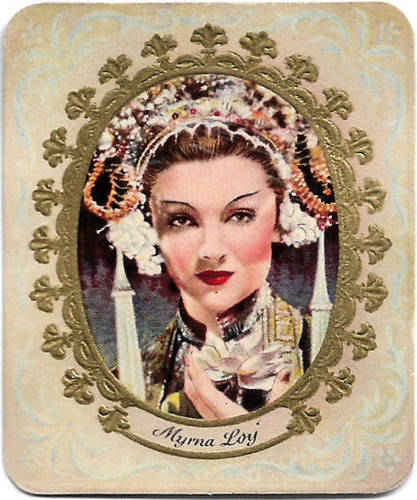
German collectors card in the Moderne Schönheitsgalerie series, no. 149 (out of 300). The series was produced by Ross Verlag for the Garbaty Cigarette Company as a supplement for their 'Edelzigarette' Kurmark. Photo: Metro Goldwyn Mayer (M.G.M.). Myrna Loy in The Mask of Fu Manchu (Charles Brabin, 1932).
Myrna Loy (1905-1993) was an American film, television, and stage actress. She was originally typecast in exotic roles, often as a vamp or a woman of Asian descent, but her career prospects improved greatly following her portrayal of Nora Charles in The Thin Man (W.S. Van Dyke, 1934). Suddenly she was 'Queen of the Movies' and remained so until the late 1940s.
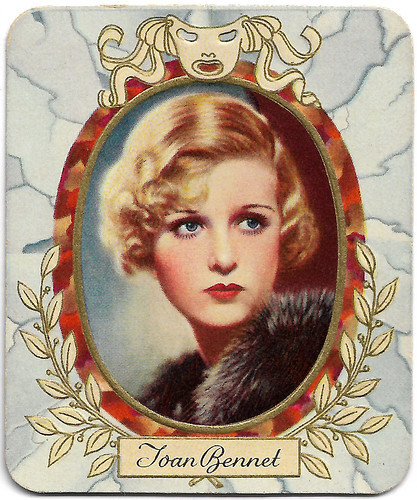
German collectors card in the Moderne Schönheitsgalerie by Ross Verlag for the Garbaty Cigarette Company as a supplement for their 'Edelzigarette' Kurmark, no. 151 of 300. Photo: Fox.
Joan Bennett (1910–1990) was an American actress who had her breakthrough in Little Women (George Cukor, 1933). Producer Walter Wanger helped to manage her career and eventually married her in 1940. At the beginning of the 1940s, Bennett appeared in four films by Fritz Lang. These turned her into a femme fatale of the Film Noir.
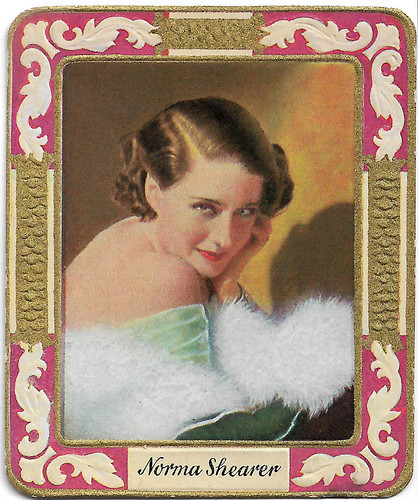
German cigarette card by Ross Verlag in the 'Moderne Schönheitsgalerie' series for the Garbaty Cigarette Company as a supplement for their 'Edelzigarette' Kurmark, no. 289. Photo: Metro-Goldwyn-Mayer (MGM).
American actress Norma Shearer (1902-1983) was the 'First Lady of MGM'.
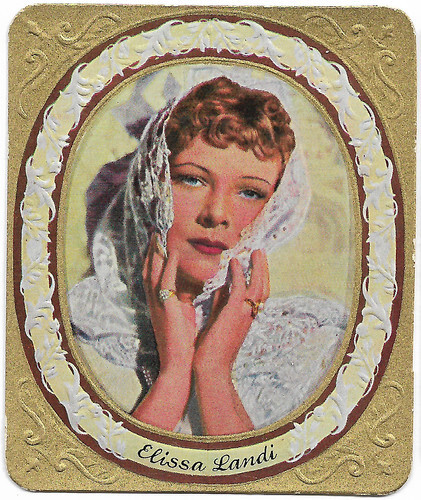
German collectors card in the 'Moderne Schönheitsgalerie' by Ross Verlag for the Garbaty Cigarette Company as a supplement for their 'Edelzigarette' Kurmark, no 292 (of 300). Photo: Paramount.
Austrian-born actress and writer Elissa Landi (1904–1948) was (falsely) rumoured to be a descendant of Emperor Franz Joseph of Austria. During the 1920s, she appeared in British, French, and German films before travelling to the United States. In Hollywood, she became a popular star of the 1930s.
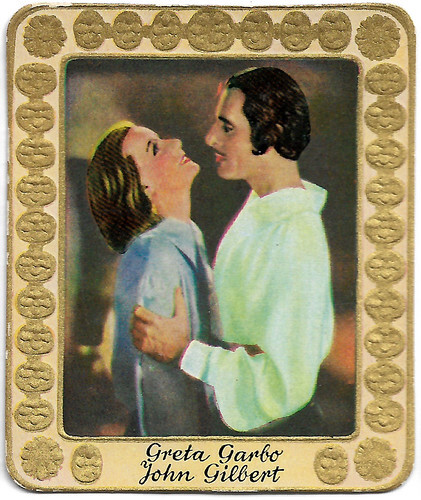
German collectors card in the 'Galerie Schöner-Frauen Des Films' (Gallery of Beautiful Women in Film) in 1936 by Ross Verlag for the Garbaty Cigarette Company as a supplement for their 'Edelzigarette' Kurmark, series 2, no. 47 (of 300). Photo: Metro-Goldwyn-Mayer. Greta Garbo and John Gilbert in Queen Christina (Rouben Mamoulian, 1933).
Souces: Virtual History, Carole & Co, and Garbo Forever.

German collectors card in the Moderne Schönheitsgalerie Series by Ross Verlag, no 6 (of 300). Photo: Ufa. The card was a supplement to 'Edelzigarette' Kurmark of the Garbaty Cigarette Company.
German actress Brigitte Helm (1908-1996) is still famous for her dual role as Maria and her double the evil Maria, the Maschinenmensch, in the silent SF classic Metropolis (Fritz Lang, 1927). After Metropolis she made a string of over 30 films in which she almost always had the starring role. She easily made the transition to sound films, before she abruptly retired in 1935.

German collectors card in the Moderne Schönheitsgalerie by Ross Verlag for 'Edelzigarette' Kurmark of the Garbaty Cigarette Company, no. 55. Photo: Hisa-Film.
German-born, British stage and screen actress Dolly Haas (1910-1994) was popular in the 1930s as a vivacious, red-haired gamine often wearing trousers in German and British films. Although she got a 3-year contract with Columbia and she worked in Hollywood with Alfred Hitchcock, Dolly's American career mainly took place on and Off-Broadway.

German collectors card in the Moderne Schönheitsgalerie by Ross Verlag for 'Edelzigarette' Kurmark of the Garbaty Cigarette Company, no. 56. Photo: Dolly Haas in Warum lügt Fräulein Käthe?/Why is Miss Käthe lying? (Georg Jacoby, 1935).
The Jewish Garbaty Family
In the 1930s, the Nazi regime in Germany was not happy with Hollywood. One of the reasons was the Jewish background of many of the Hollywood studio moguls, another was the themes of the films.
However, American movies, and their stars, were quite popular with German audiences, and it wasn't until late in the decade that Hollywood studio product was heavily suppressed.
The Garbaty family, which had owned the cigarette firm for nearly half a century, was Jewish. In late 1938, the Nazis staged Kristallnacht, where several hundred Jews were murdered and their property seized.
Owner Moritz Garbaty hid out at the home of his Catholic secretary, and his wife and 8-year-old son Thomas were visited by the Gestapo, which was seeking his father.
Several days later, Moritz was reunited with his family; he sold the company for a fraction of its worth and left for America, securing the family's safety with a million-dollar bribe to authorities. The family survived in the USA.

German collectors card in the Moderne Schönheitsgalerie series by Ross Verlag for 'Edelzigarette' Kurmark of the Garbaty Cigarette Company, no. 142. Photo: Paramount.
Ida Lupino (1918-1995) was an English-American actress and singer, who became a pioneering director and producer — the only woman working within the 1950s Hollywood studio system to do so.

German collectors card in the Moderne Schönheitsgalerie series, no. 149 (out of 300). The series was produced by Ross Verlag for the Garbaty Cigarette Company as a supplement for their 'Edelzigarette' Kurmark. Photo: Metro Goldwyn Mayer (M.G.M.). Myrna Loy in The Mask of Fu Manchu (Charles Brabin, 1932).
Myrna Loy (1905-1993) was an American film, television, and stage actress. She was originally typecast in exotic roles, often as a vamp or a woman of Asian descent, but her career prospects improved greatly following her portrayal of Nora Charles in The Thin Man (W.S. Van Dyke, 1934). Suddenly she was 'Queen of the Movies' and remained so until the late 1940s.

German collectors card in the Moderne Schönheitsgalerie by Ross Verlag for the Garbaty Cigarette Company as a supplement for their 'Edelzigarette' Kurmark, no. 151 of 300. Photo: Fox.
Joan Bennett (1910–1990) was an American actress who had her breakthrough in Little Women (George Cukor, 1933). Producer Walter Wanger helped to manage her career and eventually married her in 1940. At the beginning of the 1940s, Bennett appeared in four films by Fritz Lang. These turned her into a femme fatale of the Film Noir.

German cigarette card by Ross Verlag in the 'Moderne Schönheitsgalerie' series for the Garbaty Cigarette Company as a supplement for their 'Edelzigarette' Kurmark, no. 289. Photo: Metro-Goldwyn-Mayer (MGM).
American actress Norma Shearer (1902-1983) was the 'First Lady of MGM'.

German collectors card in the 'Moderne Schönheitsgalerie' by Ross Verlag for the Garbaty Cigarette Company as a supplement for their 'Edelzigarette' Kurmark, no 292 (of 300). Photo: Paramount.
Austrian-born actress and writer Elissa Landi (1904–1948) was (falsely) rumoured to be a descendant of Emperor Franz Joseph of Austria. During the 1920s, she appeared in British, French, and German films before travelling to the United States. In Hollywood, she became a popular star of the 1930s.

German collectors card in the 'Galerie Schöner-Frauen Des Films' (Gallery of Beautiful Women in Film) in 1936 by Ross Verlag for the Garbaty Cigarette Company as a supplement for their 'Edelzigarette' Kurmark, series 2, no. 47 (of 300). Photo: Metro-Goldwyn-Mayer. Greta Garbo and John Gilbert in Queen Christina (Rouben Mamoulian, 1933).
Souces: Virtual History, Carole & Co, and Garbo Forever.
Published on May 26, 2022 22:00
May 25, 2022
Zany Joan
In 1928, Joan Crawford became a star with her role as Diana Medford in Our Dancing Daughters (Harry Beaumont, 1928). The film and her role struck a chord with the Zeitgeist. Joan played a spunky and wild-but-good flapper and he became a symbol of modern 1920s style femininity. She became a rival for Clara Bow, the original It girl, and Hollywood's foremost flapper. A stream of hits followed in which Joan played the free-spirited, all-American girl, and her delicious postcards at the time presented Joan at her zaniest. However, a fox loses its hair, but not its pranks...
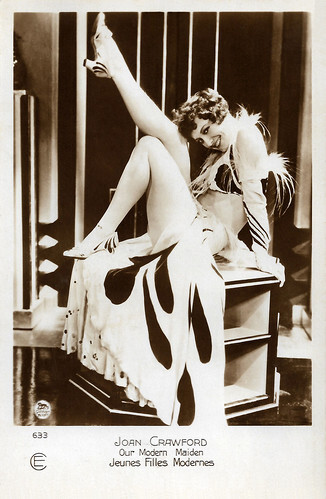
French postcard by Cinémagazine-Edition, no. 633. Photo: MGM. Joan Crawford in Our Modern Maidens (Jack Conway, 1929).
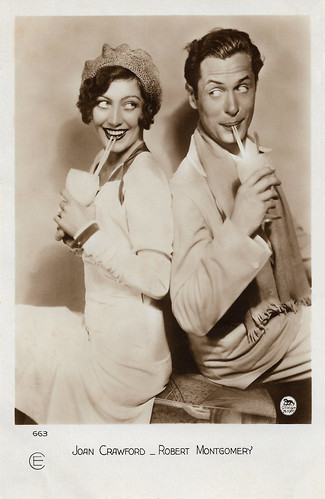
French postcard by Cinémagazine-Edition, Paris, no. 663. Photo: Metro-Goldwyn-Mayer. Joan Crawford and Robert Montgomery in Untamed (Jack Conway, 1929). Collection: Geoffrey Donaldson Institute.
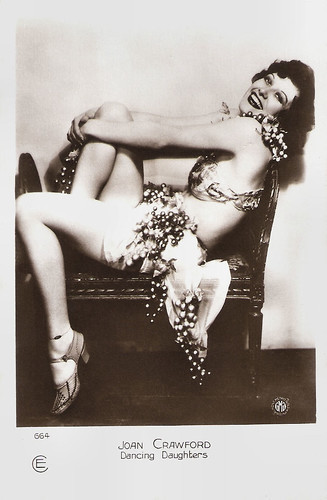
French postcard by Cinémagazine-Edition, no. 664. Photo: MGM. Joan Crawford in Our Dancing Daughters (Harry Beaumont, 1928).
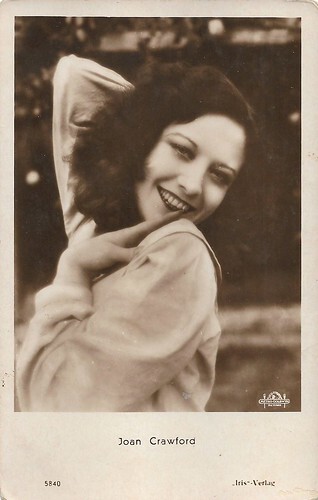
Austrian postcard by Iris Verlag, no. 5840. Photo: MGM.
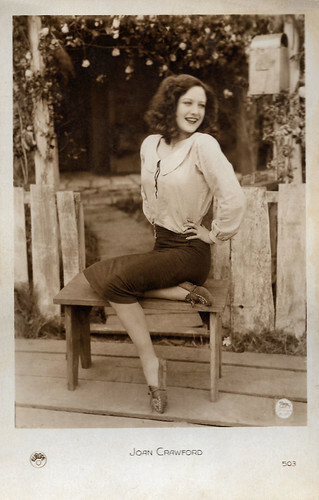
French postcard by Europe, no. 503. Photo: MGM.
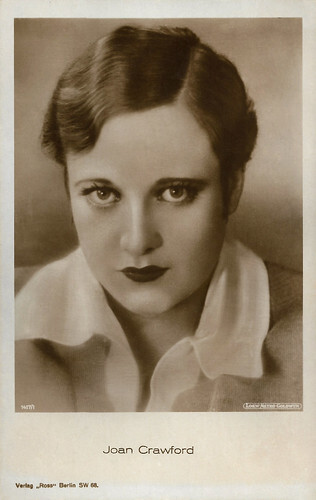
German postcard by Ross Verlag, no. 1417/1, 1927-1928. Photo: Loew-Goldwyn-Mayer.
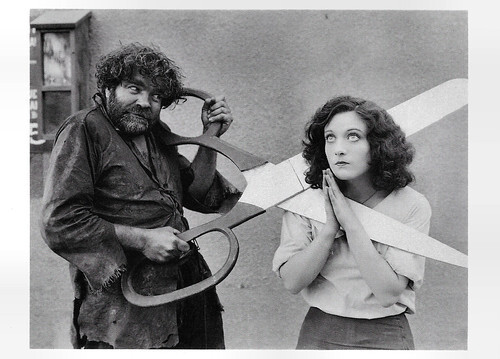
Swiss-German-British postcard by News Productions, Baulmes / Filmwelt Berlin, Bakede / News Productions, Stroud, no. 56546 Photo: Collection Cinémathèque Suisse, Lausanne. Photo: MGM. Caption: Gibson Gowland & Joan Crawford, USA, 1927. Gibson Gowland and Joan Crawford in Rose-Marie (Lucien Hubbard, 1928).
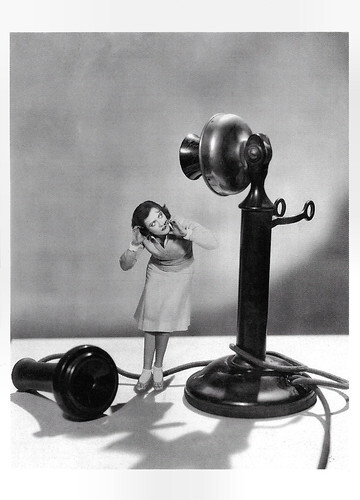
Swiss-German-British postcard by News Productions, Baulmes / Filmwelt Berlin, Bakede / News Productions, Stroud, no. 56554. Photo: Collection Cinémathèque Suisse, Lausanne. Photo: MGM.
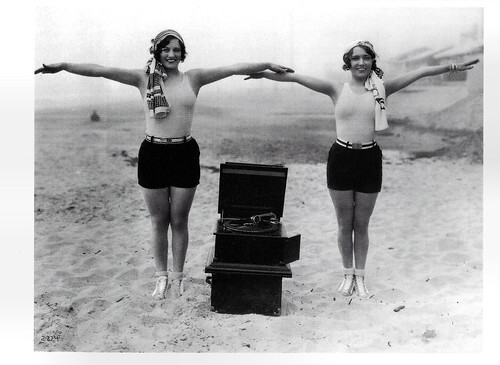
Swiss-German-British postcard by News Productions, Baulmes / Filmwelt Berlin, Bakede / News Productions, Stroud, no. 56558. Photo: MGM / Collection Cinémathèque Suisse, Lausanne. Caption: Joan Crawford & Dorothy Sebastian, Santa Monica, 1929.
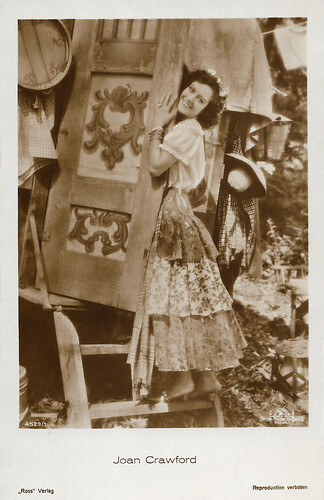
German postcard by Ross Verlag, no. 4529/1, 1929-1930. Photo: MGM.
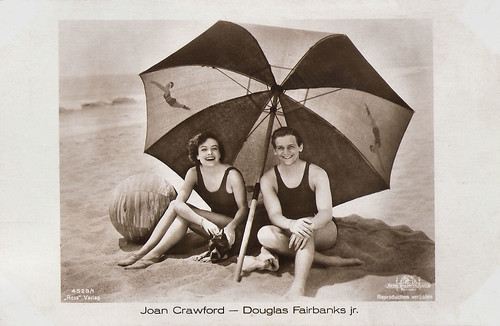
With Douglas Fairbanks jr. German postcard by Ross Verlag, Berlin, no. 4628/1, 1929-1930. Photo: Metro-Goldwyn-Mayer.
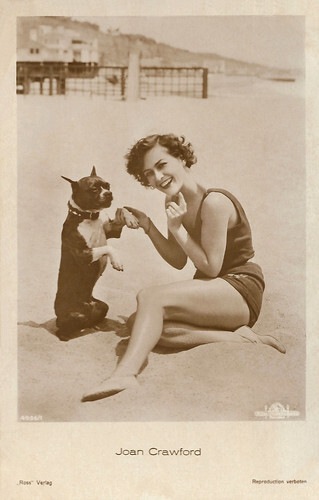
German postcard by Ross Verlag, no. 4906/1, 1929-1930. Photo: Metro-Goldwyn-Mayer.
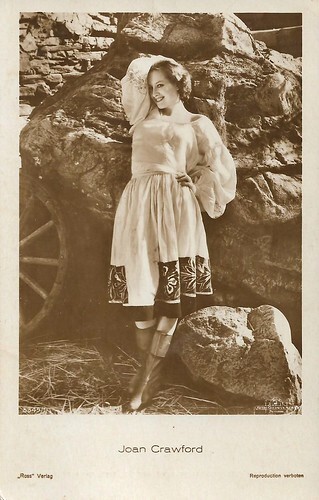
German postcard by Ross Verlag, no. 5349/1, 1930-1931. Photo: Metro-Goldwyn-Mayer.
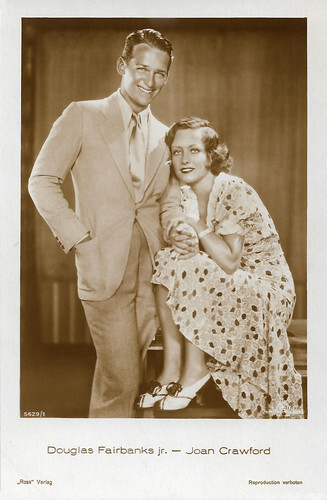
With Douglas Fairbanks jr. German postcard by Ross Verlag, no. 5629/1, 1930-1931. Photo: Metro-Goldwyn-Mayer.
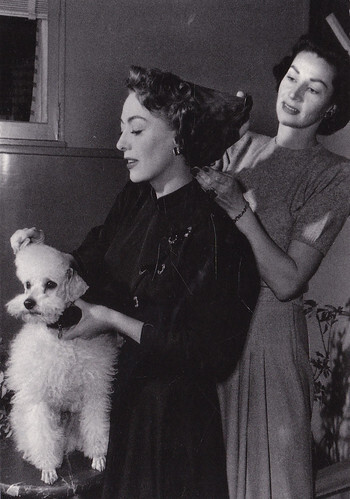
German postcard by pwe Verlag, München (Munich). From the Prestel book 'Fashion in Film'. Caption: Cliquot the poodle, Joan Crawford , Gertrude Wheeler during a break in shooting The Damned Don't Cry, 1950. Directed by Vincent Sherman. Costumes by Sheila O'Brian. Collection: Carla Bosch.

French postcard by Cinémagazine-Edition, no. 633. Photo: MGM. Joan Crawford in Our Modern Maidens (Jack Conway, 1929).

French postcard by Cinémagazine-Edition, Paris, no. 663. Photo: Metro-Goldwyn-Mayer. Joan Crawford and Robert Montgomery in Untamed (Jack Conway, 1929). Collection: Geoffrey Donaldson Institute.

French postcard by Cinémagazine-Edition, no. 664. Photo: MGM. Joan Crawford in Our Dancing Daughters (Harry Beaumont, 1928).

Austrian postcard by Iris Verlag, no. 5840. Photo: MGM.

French postcard by Europe, no. 503. Photo: MGM.

German postcard by Ross Verlag, no. 1417/1, 1927-1928. Photo: Loew-Goldwyn-Mayer.

Swiss-German-British postcard by News Productions, Baulmes / Filmwelt Berlin, Bakede / News Productions, Stroud, no. 56546 Photo: Collection Cinémathèque Suisse, Lausanne. Photo: MGM. Caption: Gibson Gowland & Joan Crawford, USA, 1927. Gibson Gowland and Joan Crawford in Rose-Marie (Lucien Hubbard, 1928).

Swiss-German-British postcard by News Productions, Baulmes / Filmwelt Berlin, Bakede / News Productions, Stroud, no. 56554. Photo: Collection Cinémathèque Suisse, Lausanne. Photo: MGM.

Swiss-German-British postcard by News Productions, Baulmes / Filmwelt Berlin, Bakede / News Productions, Stroud, no. 56558. Photo: MGM / Collection Cinémathèque Suisse, Lausanne. Caption: Joan Crawford & Dorothy Sebastian, Santa Monica, 1929.

German postcard by Ross Verlag, no. 4529/1, 1929-1930. Photo: MGM.

With Douglas Fairbanks jr. German postcard by Ross Verlag, Berlin, no. 4628/1, 1929-1930. Photo: Metro-Goldwyn-Mayer.

German postcard by Ross Verlag, no. 4906/1, 1929-1930. Photo: Metro-Goldwyn-Mayer.

German postcard by Ross Verlag, no. 5349/1, 1930-1931. Photo: Metro-Goldwyn-Mayer.

With Douglas Fairbanks jr. German postcard by Ross Verlag, no. 5629/1, 1930-1931. Photo: Metro-Goldwyn-Mayer.

German postcard by pwe Verlag, München (Munich). From the Prestel book 'Fashion in Film'. Caption: Cliquot the poodle, Joan Crawford , Gertrude Wheeler during a break in shooting The Damned Don't Cry, 1950. Directed by Vincent Sherman. Costumes by Sheila O'Brian. Collection: Carla Bosch.
Published on May 25, 2022 22:00
May 24, 2022
Quick (1932)
In the comedy Quick (1932), the Ufa teamed two of their brightest stars, Lilian Harvey and Hans Albers. But their chemistry was less sensational than the sparks that fly between Harvey and Willy Fritsch. Supposedly there were competitive issues that put Harvey on her guard and challenged Albers' ego. Still, the tension between the two works to the advantage of this stage farce filled with mistaken identities and lover's quarrels. The young director Robert Siodmak was in charge. Together with André Daven, Siodmak also co-directed a French-language version, Quick (1932) in which Harvey co-starred with Jules Berry as Quick.

German postcard by Agfa. Photo: Ufa. Hans Albers and Lilian Harvey in Quick (Robert Siodmak, 1932).
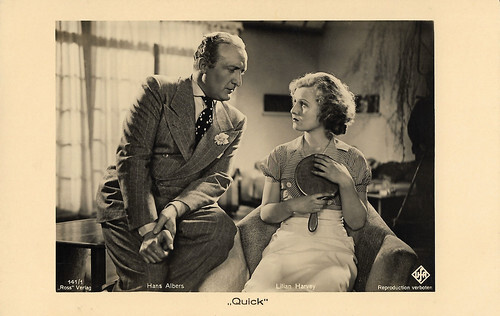
German postcard by Ross Verlag, no. 141/1. Photo: Ufa. Hans Albers and Lilian Harvey in Quick (Robert Siodmak, 1932).
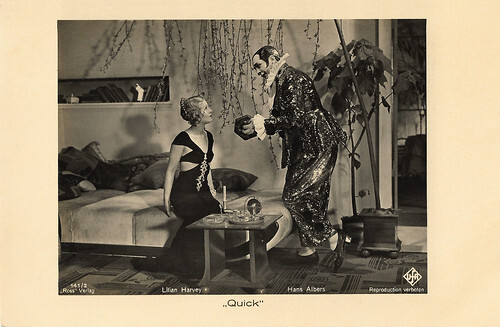
German postcard by Ross Verlag, no. 141/2. Photo: Ufa. Hans Albers and Lilian Harvey in Quick (Robert Siodmak, 1932).
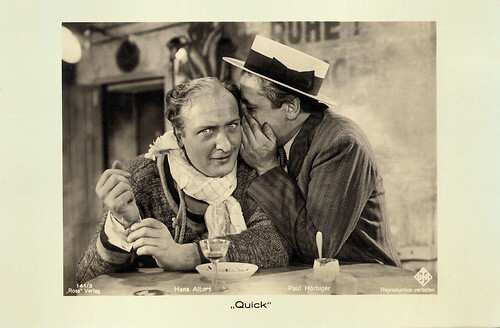
German postcard by Ross Verlag, no. 141/3. Photo: Ufa. Hans Albers and Paul Hörbiger in Quick (Robert Siodmak, 1932).
Witty dialogues and charming stars
Lilian Harvey plays 21-year-old divorcee Eva Prätorius who is taking some time in a posh spa, the Sonneneck sanatorium, which is under the medical management of the respected Prof. Bertram. Every evening she keeps sneaking out to the Apollo Theatre, the town's vaudeville theatre. She wants to see a performer, the musical clown Quick ( Hans Albers in heavy white make-up), do his act.
Eva goes backstage to meet Quick. But she doesn't recognise him when he happens to stand in front of her - without make-up, as she has never seen him before. He also begins to take a shine for the young, capricious woman who adores him every evening from her box. He tries to woo her, masquerading as the theatre's manager.
Quick tries to get her to fall in love with who he is in real life but Eva only likes him as a person who can introduce her to Quick. Unable to resolve her feelings for both the clown and the theatre manager, Eva is angered when she finally learns that they are one and the same. But not for long, of course...
Quick (Robert Siodmak, 1932) was clearly based on a stage play, by Félix Gandéra, and not a particularly good showcase for any of the main talents except for Hans Albers . However, the mistaken identity and following runaround are never tiresome as and Quick is better than most Ufa films in this genre.
Mayesgwtw39 (IMDb) notes that Quick contains "some witty dialogue [by Hans Müller], but the stars are relying mostly on their screen personas to supply the charm. They do so quite effectively from the leads to the supporting cast. The whole thing makes for a lively and somewhat stylish farce." The sets were designed by art director Erich Kettelhut. Max Pfeiffer was production manager and film editor Viktor Gertler also served as Robert Siodmak's assistant director.
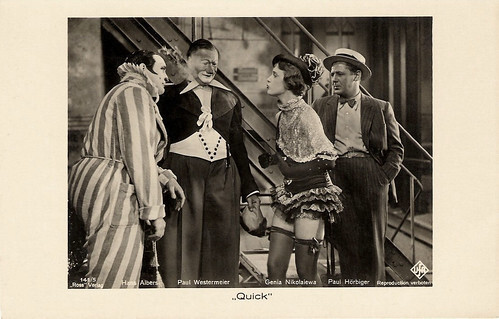
German postcard by Ross Verlag, no. 141/5, 1931-1932. Photo: Ufa. Hans Albers , Paul Hörbiger , Paul Westermeier and Genia Nikolaieva in Quick (Robert Siodmak, 1931).
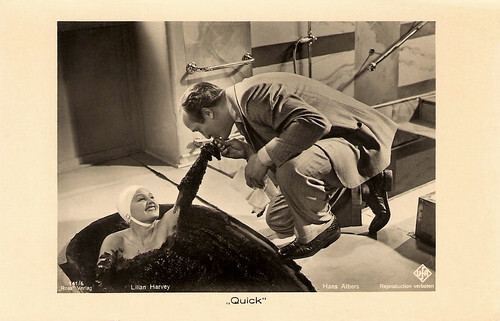
German postcard by Ross Verlag, no. 141/6. Photo: Ufa. Lilian Harvey and Hans Albers in Quick (Robert Siodmak, 1932). Collection: Geoffrey Donaldson Institute.
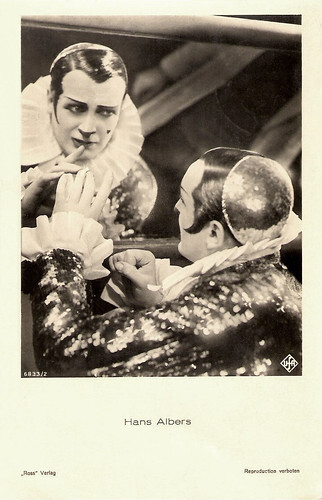
German postcard by Ross Verlag, no. 6833/2, 1931-1932. Photo: Ufa. Hans Albers in Quick (Robert Siodmak, 1932).
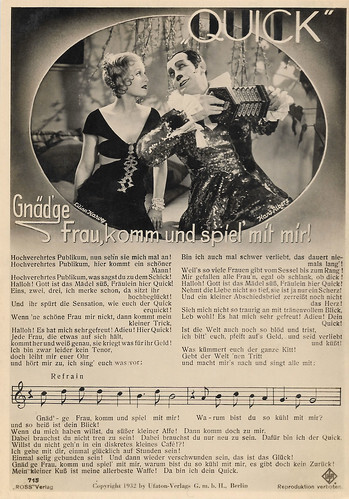
German postcard by Ross Verlag, no. 715/1. Photo: Ufa. Hans Albers and Lilian Harvey in Quick (Robert Siodmak, 1932). Song text of 'Gnädige Frau, komm und spiel mit mir' (Madam, come and play with me). Copyright: Ufaton-Verlag, 1932.
Sources: Mayesgwtw39 (IMDb), Wikipedia (German and English), and IMDb.

German postcard by Agfa. Photo: Ufa. Hans Albers and Lilian Harvey in Quick (Robert Siodmak, 1932).

German postcard by Ross Verlag, no. 141/1. Photo: Ufa. Hans Albers and Lilian Harvey in Quick (Robert Siodmak, 1932).

German postcard by Ross Verlag, no. 141/2. Photo: Ufa. Hans Albers and Lilian Harvey in Quick (Robert Siodmak, 1932).

German postcard by Ross Verlag, no. 141/3. Photo: Ufa. Hans Albers and Paul Hörbiger in Quick (Robert Siodmak, 1932).
Witty dialogues and charming stars
Lilian Harvey plays 21-year-old divorcee Eva Prätorius who is taking some time in a posh spa, the Sonneneck sanatorium, which is under the medical management of the respected Prof. Bertram. Every evening she keeps sneaking out to the Apollo Theatre, the town's vaudeville theatre. She wants to see a performer, the musical clown Quick ( Hans Albers in heavy white make-up), do his act.
Eva goes backstage to meet Quick. But she doesn't recognise him when he happens to stand in front of her - without make-up, as she has never seen him before. He also begins to take a shine for the young, capricious woman who adores him every evening from her box. He tries to woo her, masquerading as the theatre's manager.
Quick tries to get her to fall in love with who he is in real life but Eva only likes him as a person who can introduce her to Quick. Unable to resolve her feelings for both the clown and the theatre manager, Eva is angered when she finally learns that they are one and the same. But not for long, of course...
Quick (Robert Siodmak, 1932) was clearly based on a stage play, by Félix Gandéra, and not a particularly good showcase for any of the main talents except for Hans Albers . However, the mistaken identity and following runaround are never tiresome as and Quick is better than most Ufa films in this genre.
Mayesgwtw39 (IMDb) notes that Quick contains "some witty dialogue [by Hans Müller], but the stars are relying mostly on their screen personas to supply the charm. They do so quite effectively from the leads to the supporting cast. The whole thing makes for a lively and somewhat stylish farce." The sets were designed by art director Erich Kettelhut. Max Pfeiffer was production manager and film editor Viktor Gertler also served as Robert Siodmak's assistant director.

German postcard by Ross Verlag, no. 141/5, 1931-1932. Photo: Ufa. Hans Albers , Paul Hörbiger , Paul Westermeier and Genia Nikolaieva in Quick (Robert Siodmak, 1931).

German postcard by Ross Verlag, no. 141/6. Photo: Ufa. Lilian Harvey and Hans Albers in Quick (Robert Siodmak, 1932). Collection: Geoffrey Donaldson Institute.

German postcard by Ross Verlag, no. 6833/2, 1931-1932. Photo: Ufa. Hans Albers in Quick (Robert Siodmak, 1932).

German postcard by Ross Verlag, no. 715/1. Photo: Ufa. Hans Albers and Lilian Harvey in Quick (Robert Siodmak, 1932). Song text of 'Gnädige Frau, komm und spiel mit mir' (Madam, come and play with me). Copyright: Ufaton-Verlag, 1932.
Sources: Mayesgwtw39 (IMDb), Wikipedia (German and English), and IMDb.
Published on May 24, 2022 22:00
May 23, 2022
Nicole Maurey
Glamorous French beauty Nicole Maurey (1926-2016) appeared in 65 film and television productions between 1944 and 1997. She flirted with Hollywood stardom in the 1950s, co-starring with Bing Crosby in Little Boy Lost (1953) and Danny Kaye in Me and the Colonel (1958). She probably remains most noted as Charlton Heston's leading lady in Secret of the Incas (1954), often cited as the primary inspiration for Raiders of the Lost Ark (1981).
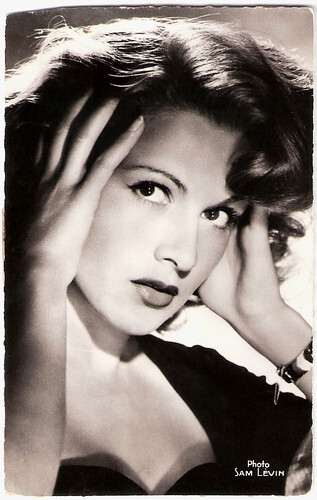
French postcard by Editions du Globe, Paris. Photo: Sam Lévin.
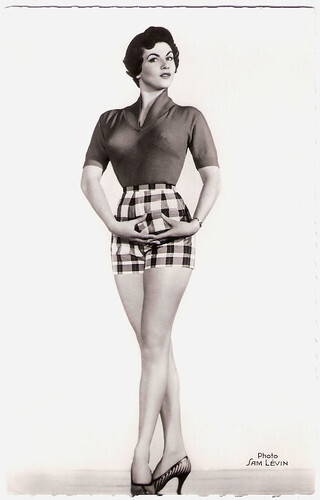
French postcard by Editions du Globe, Paris, no. 361. Photo: Sam Lévin.
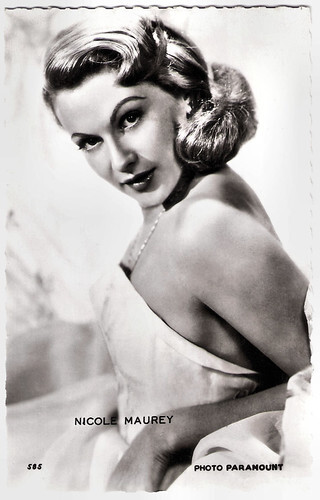
French postcard by Editions P.I., Paris, no. 585. Photo: Paramount, 1955.
Robert Bresson
Nicole Arlette Maurey was born in Bois-Colombes, a northwestern suburb of Paris, in 1926. Her father was an architect, her mother a housewife. She had one sister. Besides going to school, she took ballet lessons. She entered as a ‘petit rat’ at the Paris Opera, but her family preferred a career in the theatre. So she took drama lessons at the Cours d'Art Dramatique from Maurice Escande .
Nicole played her first film role in Blondine (Henri Mahé, 1944) opposite Georges Marchal . Other films were Le cavalier noir/The black knight (Gilles Grangier, 1945) with Georges Guétary , and La bataille du feu/The Battle of fire (Maurice de Canonge, 1949). In 1950 she married the young actor Jacques L. Gallo whom she had met on the Paris metro.
An important film on her résumé is Journal d'un curé de campagne/Diary of a Country Priest (1951) directed by Robert Bresson. It tells the story of an inexperienced and frail priest (Claude Laydu), who has just arrived in his first parish, a village in northern France, where he is not welcome. He tries to fulfill his duties even as he fights a mysterious stomach ailment.
The film won eight international awards, including the Grand Prize at the Venice International Film Festival, and the Prix Louis Delluc. It was a financial success in France and established Bresson's international reputation as a major film director. Film critic André Bazin wrote an entire essay on the film, calling it a masterpiece "because of its power to stir the emotions, rather than the intelligence." The film also had considerable influence on Martin Scorsese's Taxi Driver (1976).
Two years later, Maurey appeared in the American drama Little Boy Lost (George Seaton, 1953) about a war correspondent (Bing Crosby) stationed in Paris during World War II and once married to a French girl (Maurey) who was murdered by the Nazis. Following the war, he returns to France trying to find their son, whom he lost during a bombing raid but has been told is living in an orphanage in Paris. Filmed on location in Paris, Little Boy Lost received the Golden Globe Award for Best Film Promoting International Understanding and was also entered into the 1954 Cannes Film Festival.
Maurey was then Charlton Heston 's leading lady in Secret of the Incas (Jerry Hopper, 1954), often cited as the primary inspiration for Raiders of the Lost Ark (Steven Spielberg, 1981). Secret of the Incas was filmed by Paramount Pictures on location in Peru at Cuzco and Machu Picchu, the first time that a Hollywood studio filmed at this archeological site. Five hundred native Indians were used as extras in the film, which also featured the Peruvian singer Yma Sumac. The film caused a surge in tourism to Peru in 1954. Many of the scenes in Secret of the Incas bear a striking resemblance in tone and structure to scenes from the Indiana Jones films. Heston and Maurey reprised their roles in 1954 in a Lux Radio Theater version of Secret of the Incas.
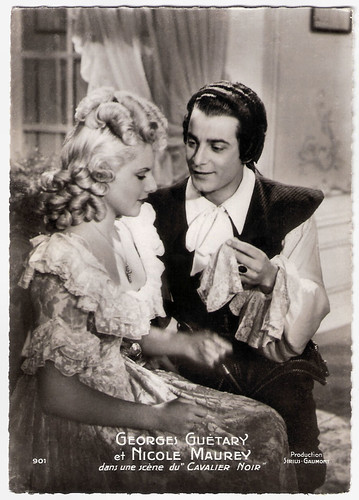
French postcard by Edition d'Art BelFrance, Paris, no. 901. Photo: Sirius / Gaumont, Paris. Georges Guétary and Nicole Maurey in Le Cavalier noir/The Black Cavalier (Gilles Grangier, 1945).
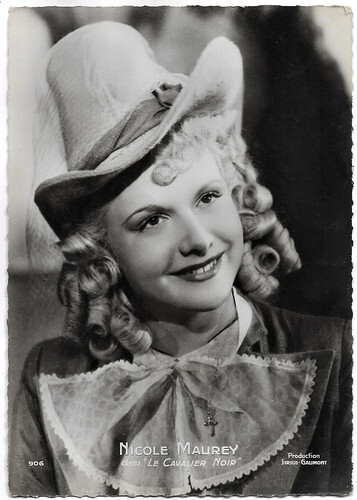
French postcard by Editions d'Art BelFrance (EAP), Paris, no. 906. Photo: Sirius-Gaumont. Nicole Maurey in Le cavalier noir/The black rider (Gilles Grangier, 1945).
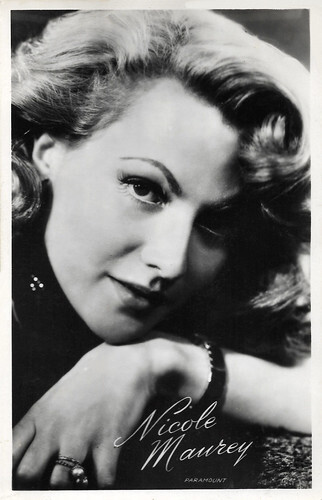
Dutch postcard by Takken / 't Sticht, Utrecht, no. 1662. Photo: Paramount.
The Day of the Triffids
In the following decade, Nicole Maurey worked as well in France as internationally. In France, she was one of the many stars in the historical drama Si Versailles m'était conté/Royal Affairs in Versailles (Sacha Guitry, 1954), which portrayed the personalities who lived in the Royal Palace, the Chateau of Versailles. The following year, she also appeared in Guitry’s historical epic Napoléon (Sacha Guitry, 1955) which follows the life of Napoleon from his early years in Corsica to his death at Saint Helena.
Other French films were the crime film Section des disparus/The Missing Section (Pierre Chenal, 1956) with Maurice Ronet , and the crime comedy Action immédiate/To Catch a Spy (Maurice Labro, 1957), starring Henri Vidal . In Great Britain, she appeared in the comedy The Constant Husband (Sidney Gilliat, 1955) starring Rex Harrison . Then she co-starred in the American war film The Bold and the Brave (Lewis R. Foster, 1956), which traces the destinies of three American soldiers (Wendell Corey, Mickey Rooney , and Don Taylor) stationed in Italy during World War II. Maurey reunited with Bing Crosby in the comedy High Time (Blake Edwards, 1960), about a middle-aged widower who goes back to college, enters the world of a new generation of postwar youth and falls for professor Maurey. She settled in England and appeared pleasantly in a variety of films but without much fanfare.
Other international films were the thriller The Weapon (Val Guest, 1957) with Lizabeth Scott, the war comedy Me and the Colonel (Peter Glenville, 1958) starring Danny Kaye and Curd Jürgens , the crime film The Scapegoat (Robert Hamer, 1959) with Alec Guinness and Bette Davis , and the Western The Jayhawkers! (Melvin Frank, 1959). In 1960 she divorced Jacques L. Gallo.
One of her best-known British films is the Science-Fiction classic The Day of the Triffids (Steve Sekely, 1962) based on the novel by John Wyndham. Triffids are plants with a deadly sting that are able to uproot themselves, walk and even communicate. Craig Butler at AllMovie : “Although it takes entirely too many liberties with the excellent novel upon which it is based, The Day of the Triffids is generally an entertaining sci-fi romp. It has many of the classic (some might say clichéd) elements often associated with the genre - an alien invasion, stalwart hero, rag-tag band of allies, and a race against time to save the entire planet.”
In 1965, Maurey was back in France for the comedy thriller Pleins feux sur Stanislas/Killer Spy (Jean-Charles Dudrumet, 1965), starring Jean Marais . Later, she moved into television appearing in different made-for-TV movies and mini-series, like the hit series La demoiselle d'Avignon/The Maid of Avignon (Michel Wyn, 1972) starring Marthe Keller .
Her final film was the British-French historical drama Chanel Solitaire (George Kaczender, 1981) starring Marie-France Pisier as legendary couturier Coco Chanel. On television Nicole Maurey was last seen in the drama Le grand Batre/The great Batre (Laurent Carcélès, 1997) starring Marie-Christine Barrault and Jean-Claude Drouot .In 2016, Nicole Maurey died at age 90 in Versailles, Franc.
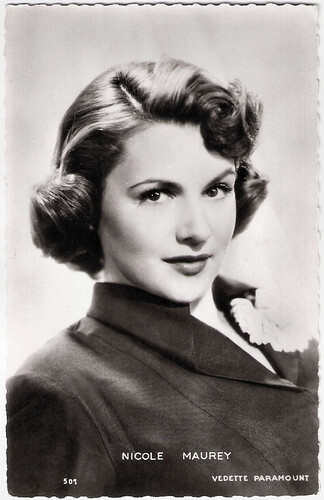
French postcard by Editions P.I., no. 501. Photo: Paramount Pictures Inc., 1954.
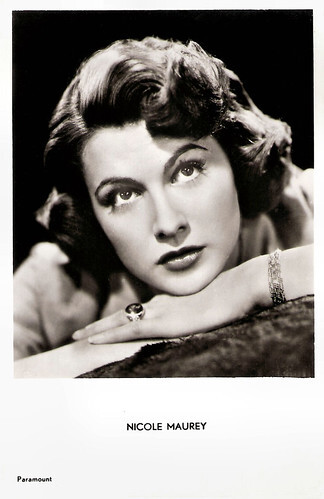
French postcard offered by Kores 'Carboplane', no. 350. Photo: Paramount.
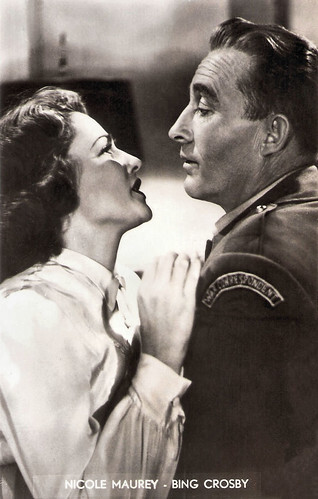
Vintage postcard. Photo: Paramount. Nicole Maurey and Bing Crosby in Little Boy Lost (George Seaton, 1953).
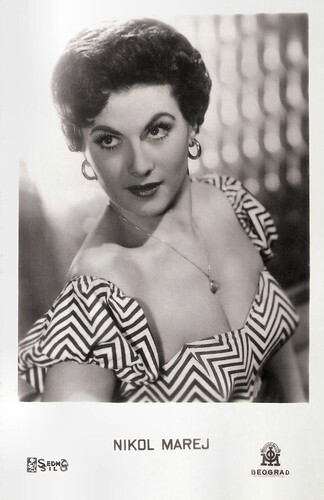
Yugoslavian postcard by Sedma Sila. Photo: IOM, Beograd.
Scene from Little Boy Lost (1953) with Nicole Maurey and Bing Crosby singing 'Darktown Strutters' Ball'. Source: Nicoley133 (YouTube).
Trailer The Day of the Triffids (1962). Source: Super Vintage Cinema (YouTube).
Sources: Hal Erickson (AllMovie), (IMDb), Craig Butler (AllMovie), Glamour Girls of the Silver Screen, Wikipedia, and .

French postcard by Editions du Globe, Paris. Photo: Sam Lévin.

French postcard by Editions du Globe, Paris, no. 361. Photo: Sam Lévin.

French postcard by Editions P.I., Paris, no. 585. Photo: Paramount, 1955.
Robert Bresson
Nicole Arlette Maurey was born in Bois-Colombes, a northwestern suburb of Paris, in 1926. Her father was an architect, her mother a housewife. She had one sister. Besides going to school, she took ballet lessons. She entered as a ‘petit rat’ at the Paris Opera, but her family preferred a career in the theatre. So she took drama lessons at the Cours d'Art Dramatique from Maurice Escande .
Nicole played her first film role in Blondine (Henri Mahé, 1944) opposite Georges Marchal . Other films were Le cavalier noir/The black knight (Gilles Grangier, 1945) with Georges Guétary , and La bataille du feu/The Battle of fire (Maurice de Canonge, 1949). In 1950 she married the young actor Jacques L. Gallo whom she had met on the Paris metro.
An important film on her résumé is Journal d'un curé de campagne/Diary of a Country Priest (1951) directed by Robert Bresson. It tells the story of an inexperienced and frail priest (Claude Laydu), who has just arrived in his first parish, a village in northern France, where he is not welcome. He tries to fulfill his duties even as he fights a mysterious stomach ailment.
The film won eight international awards, including the Grand Prize at the Venice International Film Festival, and the Prix Louis Delluc. It was a financial success in France and established Bresson's international reputation as a major film director. Film critic André Bazin wrote an entire essay on the film, calling it a masterpiece "because of its power to stir the emotions, rather than the intelligence." The film also had considerable influence on Martin Scorsese's Taxi Driver (1976).
Two years later, Maurey appeared in the American drama Little Boy Lost (George Seaton, 1953) about a war correspondent (Bing Crosby) stationed in Paris during World War II and once married to a French girl (Maurey) who was murdered by the Nazis. Following the war, he returns to France trying to find their son, whom he lost during a bombing raid but has been told is living in an orphanage in Paris. Filmed on location in Paris, Little Boy Lost received the Golden Globe Award for Best Film Promoting International Understanding and was also entered into the 1954 Cannes Film Festival.
Maurey was then Charlton Heston 's leading lady in Secret of the Incas (Jerry Hopper, 1954), often cited as the primary inspiration for Raiders of the Lost Ark (Steven Spielberg, 1981). Secret of the Incas was filmed by Paramount Pictures on location in Peru at Cuzco and Machu Picchu, the first time that a Hollywood studio filmed at this archeological site. Five hundred native Indians were used as extras in the film, which also featured the Peruvian singer Yma Sumac. The film caused a surge in tourism to Peru in 1954. Many of the scenes in Secret of the Incas bear a striking resemblance in tone and structure to scenes from the Indiana Jones films. Heston and Maurey reprised their roles in 1954 in a Lux Radio Theater version of Secret of the Incas.

French postcard by Edition d'Art BelFrance, Paris, no. 901. Photo: Sirius / Gaumont, Paris. Georges Guétary and Nicole Maurey in Le Cavalier noir/The Black Cavalier (Gilles Grangier, 1945).

French postcard by Editions d'Art BelFrance (EAP), Paris, no. 906. Photo: Sirius-Gaumont. Nicole Maurey in Le cavalier noir/The black rider (Gilles Grangier, 1945).

Dutch postcard by Takken / 't Sticht, Utrecht, no. 1662. Photo: Paramount.
The Day of the Triffids
In the following decade, Nicole Maurey worked as well in France as internationally. In France, she was one of the many stars in the historical drama Si Versailles m'était conté/Royal Affairs in Versailles (Sacha Guitry, 1954), which portrayed the personalities who lived in the Royal Palace, the Chateau of Versailles. The following year, she also appeared in Guitry’s historical epic Napoléon (Sacha Guitry, 1955) which follows the life of Napoleon from his early years in Corsica to his death at Saint Helena.
Other French films were the crime film Section des disparus/The Missing Section (Pierre Chenal, 1956) with Maurice Ronet , and the crime comedy Action immédiate/To Catch a Spy (Maurice Labro, 1957), starring Henri Vidal . In Great Britain, she appeared in the comedy The Constant Husband (Sidney Gilliat, 1955) starring Rex Harrison . Then she co-starred in the American war film The Bold and the Brave (Lewis R. Foster, 1956), which traces the destinies of three American soldiers (Wendell Corey, Mickey Rooney , and Don Taylor) stationed in Italy during World War II. Maurey reunited with Bing Crosby in the comedy High Time (Blake Edwards, 1960), about a middle-aged widower who goes back to college, enters the world of a new generation of postwar youth and falls for professor Maurey. She settled in England and appeared pleasantly in a variety of films but without much fanfare.
Other international films were the thriller The Weapon (Val Guest, 1957) with Lizabeth Scott, the war comedy Me and the Colonel (Peter Glenville, 1958) starring Danny Kaye and Curd Jürgens , the crime film The Scapegoat (Robert Hamer, 1959) with Alec Guinness and Bette Davis , and the Western The Jayhawkers! (Melvin Frank, 1959). In 1960 she divorced Jacques L. Gallo.
One of her best-known British films is the Science-Fiction classic The Day of the Triffids (Steve Sekely, 1962) based on the novel by John Wyndham. Triffids are plants with a deadly sting that are able to uproot themselves, walk and even communicate. Craig Butler at AllMovie : “Although it takes entirely too many liberties with the excellent novel upon which it is based, The Day of the Triffids is generally an entertaining sci-fi romp. It has many of the classic (some might say clichéd) elements often associated with the genre - an alien invasion, stalwart hero, rag-tag band of allies, and a race against time to save the entire planet.”
In 1965, Maurey was back in France for the comedy thriller Pleins feux sur Stanislas/Killer Spy (Jean-Charles Dudrumet, 1965), starring Jean Marais . Later, she moved into television appearing in different made-for-TV movies and mini-series, like the hit series La demoiselle d'Avignon/The Maid of Avignon (Michel Wyn, 1972) starring Marthe Keller .
Her final film was the British-French historical drama Chanel Solitaire (George Kaczender, 1981) starring Marie-France Pisier as legendary couturier Coco Chanel. On television Nicole Maurey was last seen in the drama Le grand Batre/The great Batre (Laurent Carcélès, 1997) starring Marie-Christine Barrault and Jean-Claude Drouot .In 2016, Nicole Maurey died at age 90 in Versailles, Franc.

French postcard by Editions P.I., no. 501. Photo: Paramount Pictures Inc., 1954.

French postcard offered by Kores 'Carboplane', no. 350. Photo: Paramount.

Vintage postcard. Photo: Paramount. Nicole Maurey and Bing Crosby in Little Boy Lost (George Seaton, 1953).

Yugoslavian postcard by Sedma Sila. Photo: IOM, Beograd.
Scene from Little Boy Lost (1953) with Nicole Maurey and Bing Crosby singing 'Darktown Strutters' Ball'. Source: Nicoley133 (YouTube).
Trailer The Day of the Triffids (1962). Source: Super Vintage Cinema (YouTube).
Sources: Hal Erickson (AllMovie), (IMDb), Craig Butler (AllMovie), Glamour Girls of the Silver Screen, Wikipedia, and .
Published on May 23, 2022 22:00
May 22, 2022
Written by Émile Zola
In our series 'Written by ...' today a post with postcards of stage and screen adaptations of the novels by French author Émile Zola (1940-1902). He is considered the most important representative of the literary school of naturalists and is one of the most popular French novelists ever. Zola's literary work was influenced by the works of authors Honoré de Balzac and Gustave Flaubert. In the late nineteenth century, he raised social awareness through his literature. The naturalistic style of his novels such as 'Thérèse Raquin' (1867) and 'Nana' (1880) translated very well to the screen.
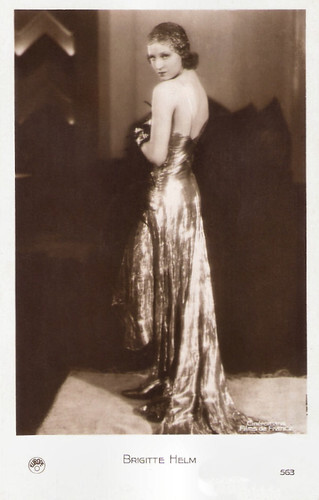
French postcard by Europe, no. 563. Photo: Cinéromans Films de France. Brigitte Helm in L'argent (Marcel L'Herbier, 1928), freely adapted from the novel by Emile Zola.
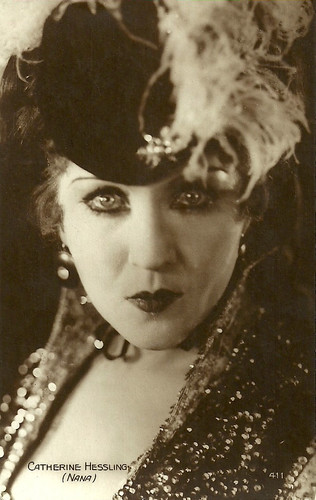
French postcard by Editions Cinémagazine, no. 411. Catherine Hessling as the title character in Nana (Jean Renoir, 1926), based on the homonymous novel (1880) by Émile Zola.
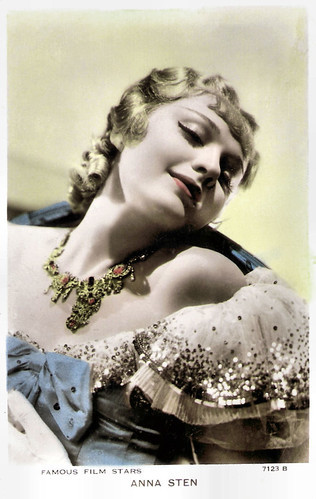
British postcard in the Famous Film Stars Series by Valentine's, no. 7123B. Photo: United Artists. Anna Sten in Nana (Dorothy Arzner, George Fitzmaurice, 1934).
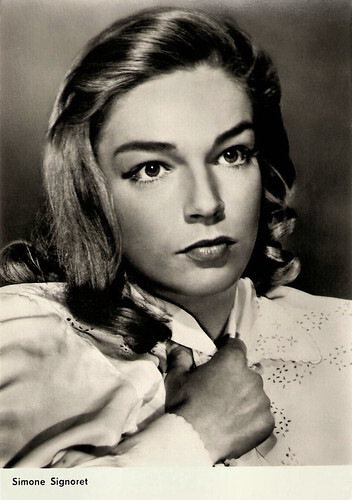
East-German postcard by VEB Progress Film-Vertrieb, nr. 1924. Photo: Simone Signoret in Therese Raquin Thérèse Raquin/The Adultress (Marcel Carné, 1953).
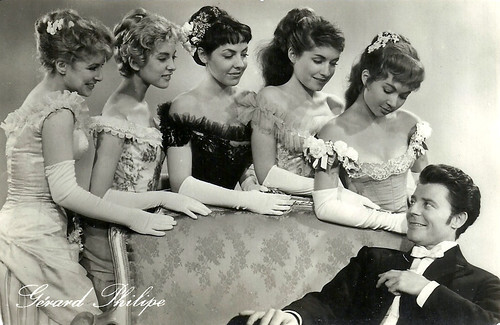
East-German postcard by VEB Progress Filmvertrieb GmbH., Starfoto no. 1288. Gérard Philipe and at right Dany Carel in the Zola adaptation Pot Bouille/Lovers of Paris (Julien Duvivier, 1957), released in Germany as Der schöne Octave.
Writing his true vocation
Émile Édouard Charles Antoine Zola was born in 1840 in Paris. He spent his childhood and school years in Aix-en-Provence, where his father Francesco Zola, of Italian origin, was an engineer. He was implementing a plan for a drinking water supply when he died unexpectedly. Poor years followed for Zola and his mother, Émilie Aubert. In 1858 they went to Paris.
From his earliest youth, Émile Zola was fascinated by literature. He read a great deal and very early on envisaged the idea of writing professionally. From an early age, he considered writing to be his true vocation. In the sixth grade, he had already written a novel about the Crusades. He told his childhood friends several times in his letters that one day he would be a recognised writer.
Zola failed his baccalauréat (bachelor of sciences) twice in 1859. These failures left a deep impression on the young man, who despaired of having disappointed his mother. He was also aware that, without a diploma, he would face serious material difficulties. In Paris, he became friends with Édouard Manet and other painters of the Impressionist movement. Manet depicted him several times in his paintings, and through Manet, he came into contact with the poet Stéphane Mallarmé.
In 1862, Zola found a job in the publicity department of the publishing house Hachette. There he met writers and became familiar with the practical side of being a writer. He learned all the techniques of books and their marketing. He also published as a journalist in various magazines. As a critic, he was particularly harsh on the official Salon jury when 'The Flute Player' by Manet was rejected. He would also become a fervent defender of impressionism.
Zola managed to get his first book published by Hetzel: 'Les Contes à Ninon' (1864). He became famous with novels such as 'Germinal', 'Nana' and the enormous success, 'L'Assommoir' (1877), which are part of the great cycle 'Les Rougon-Macquart'. 'Les Rougon-Macquart' is a twenty-volume novelistic fresco depicting French society under the Second Empire, which follows the trajectory of the Rougon-Macquart family through its different generations, each of whose representatives, from a particular period and generation, is the subject of a novel.
In 'L'Oeuvre' (1886), he depicts the tragic life of a painter, a character largely inspired by Paul Cézanne, a childhood friend of Zola's from Aix-en-Provence. Cézanne had introduced him to the graphic arts, and more particularly to painting. After receiving this novel, Cézanne abruptly ended their friendship, which had not been very intense for some time.
Zola's open letter to President Félix Faure in L'Aurore of 13 January 1898 under the title 'J'accuse...!' was also famous. In this letter about the Dreyfus affair, he sides with the Jewish captain Alfred Dreyfus, who was unjustly accused of espionage. Zola accused the French General Staff of producing evidence. Zola was sentenced for libel to one year in prison and a 3000 Francs fine, which was paid for him by Octave Mirbeau. On the advice of friends, Zola did not wait for the appeal and fled to Britain. After a year he was able to return and was received as a hero.
Zola married Alexandrine 'Gabrielle' Meley in 1870, a working-class woman who had been a model for Impressionist painters such as Manet. She introduced him to the people on the fringes of society in Paris. She also organised weekly literary dinners for Zola to further his career. Zola also had a mistress, Jeanne Rozerot, who was the family laundress. While his marriage remained childless, he and Jeanne had two children.
Émile Zola died unexpectedly in Paris in 1902 at his home on the Rue de Bruxelles due to carbon monoxide poisoning. According to Philipp Blom, a roofer confessed to placing a piece of wood on the chimney to kill the writer in revenge for his defence of the Jewish captain. In 1908, his body was transferred to the Panthéon.
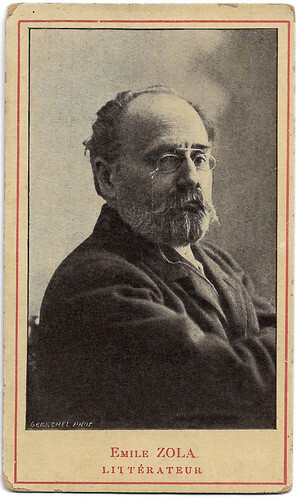
French card. Photo: Gerschel. Émile Zola.
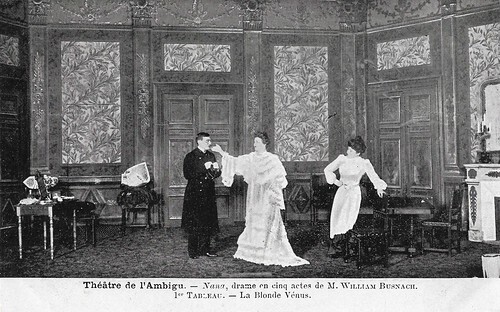
Vintage French postcard. Scene from the play 'Nanà' by William Busnach, a play in five acts adapted from the novel by Émile Zola. Théâtre de l'Ambigu, Paris. Tableau 1, The Blonde Venus. The play was first performed at the Théâtre de l'Ambigu on 6 February 1904.
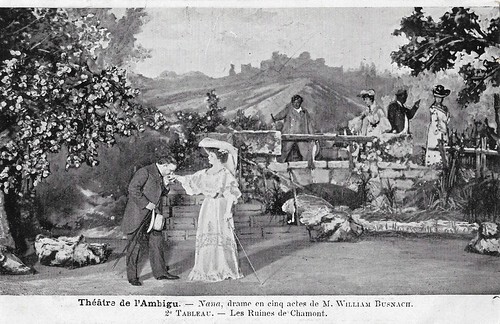
Vintage French postcard. Scene from the play 'Nanà' by William Busnach, a play in five acts adapted from the novel by Emile Zola. Théâtre de l'Ambigu. Tableau 2, The Ruins of Chamont. The play was first performed at the Théâtre de l'Ambigu on 6 February 1904. Nanâ was played by Armande Cassive. It was one of her most memorable roles.
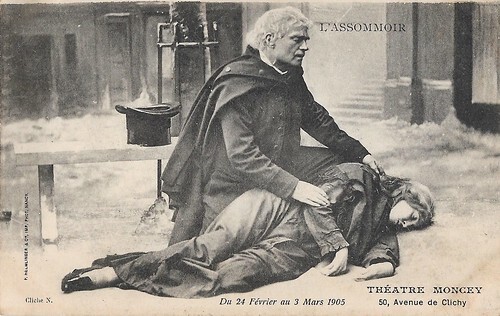
French postcard by P. Helmlinger & Co., Nancy. Cliché: N. (Nadar). Promotion for the Théâtre Moncey's production of Émile Zola's novel 'L'Assommoir' (24 February - 3 March 1905). Çaption: The death of Gervaise (Hélène Petit). This postcard shows a photo from the 1879 first stage adaptation, starring Hélène Petit as Gervaise, Gil Naza as Coupeau, and Angelo as Goujot. The original photos were by Nadar.
In 1879, two years after its publication, Émile Zola's novel 'L'Assommoir' was adapted for the stage by William Busnach and Octave Gastineau, with the help of Zola. The premiere took place on 18 January 1879 and was a great success. Afterwards, the play was often re-staged, in and outside of France. From 24 February 1905, the play was staged at the Parisian Théâtre Moncey, 50, Avenue de Clichy. The journal La Presse of 26 February 1905 lauded the play and the performances, in the first place by M. Pouctal as Coupeau, Gabrielle Fleury as Gervaise, and M. Lemarchand as Lantier. Also praised were Mlle Delorme, Mme Gaudy, and M. Berthon as Lorilleux. Of course, there were tears, but also many laughs over the drunkards Mes-Bottes, Bec-Salé, and Bibi-la-Grillade, played by Mori, Prika, and Martin. The first night took place before a packed crowd.
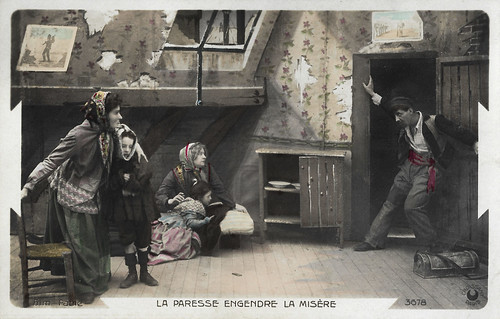
French postcard by Croissant, Paris, no. 3678. Photo: Film Pathé. Publicity still for Les victimes de l'alcoolisme/Alcohol and Its Victims (Ferdinand Zecca, 1902).
Les victimes de l'alcoolisme/Alcohol and Its Victims (Ferdinand, Zecca, 1902) is a four minutes short, directed, and written by Ferdinand Zecca. It was based on 'L'Assommoir', and the first Zola film adaptation ever. Les victimes de l'alcoolisme/Alcohol and Its Victims tells a moral story of what happens to a man if he starts to drink and gamble. Bob Lipton at IMDb : "this is a very advanced film for 1902, being offered in five scenes, on elaborately painted sets. It was probably not intended solely for movie programs, but for anti-booze lectures, Chautauquas, and conferences."
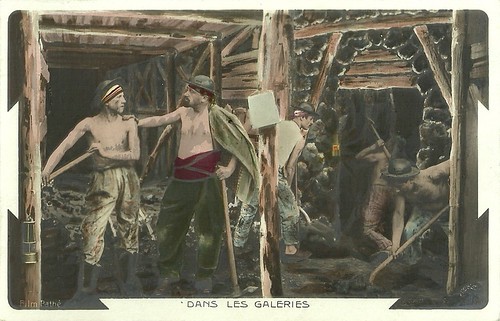
French postcard by Croissant, Paris. Photo: Film Pathé. Publicity still for Au pays noir/Tragedy in a Coal Mine (Ferdinand Zecca or Lucien Nonguet, 1905). Caption: In the mine galleries. This refers to the 5th scene of the film.
Au pays noir (1905) was partly inspired by Émile Zola's novel, the popular workman's drama 'Germinal' (1885). Au pays noir narrates the life of the miner: his life at home, going to work, gathering at the pit and descending, and having a break. But then an explosion takes place and water crushes the beams that uphold the galleries, killing the miners. A few manage to escape and withdraw to a higher gallery where the water can reach them only to their middle. They hear their liberators, who finally free them. Outside, gendarmes try to hold the crowd, who, frightened, see the rescuers bringing dead bodies one by one to the ground. When the foreman's dead son is brought to earth, his father explodes with grief and clenches his fist against the murderous mine. A year after the film, the worst mine disaster in Europe occurred in Courrières, France, when on 10 May 1906 a coal dust explosion killed almost 1100 mine workers. Zola's 'Germinal' was already filmed by Ferdinand Zecca in 1903. In 1912 Victorin Jasset filmed for the Eclair company another liberal adaptation, Au pays des ténèbres, while Albert Capellani filmed Germinal under its own title in 1913.
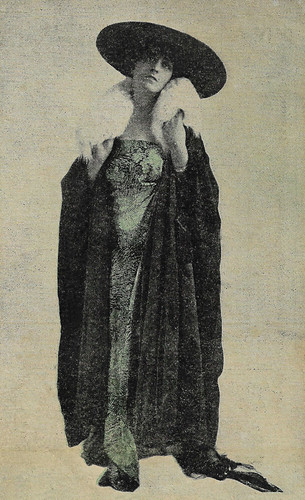
Spanish collectors card by Chocolat Imperial, no. 1 (in a series of 18 chromos). Photo: Caesar Film / J. Gurgui, Barcelona. Tilde Kassay in Una donna funesta/Nanà (Camillo De Riso, 1917-1919). Tilde Kassay (1887-1964), was an Italian silent film actress between 1915 and 1921.
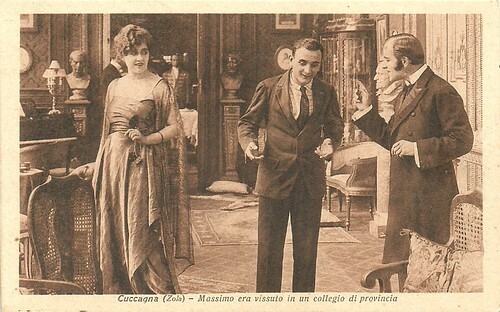
Italian postcard by IPA CT. V. Uff. Rev. St., Terni., no. 5076. Photo: Tiber Film. Hesperia in La Cuccagna (Baldassarre Negroni 1917). Caption: "Massimo had been raised in a provincial college." The film was an adaptation of Emile Zola's 'La curée'. Hesperia is Renata/Renée, the second wife of the cunning and wealthy Saccard, who married young Renata for her money. She has an affair with Saccard's son Max (Massimo), played by Alberto Collo . In the end money triumphs instead of love, just as in Zola's novel.
In search of truth
Emile Zola paints the society of the Second Empire in all its diversity, highlighting its harshness towards the workers ('Germinal', 1885), its turpitude ('Nana', 1880), but also its successes (the advent of department stores in 'Au Bonheur des Dames', 1883).
In a search for truth that takes scientific methods as a model, Émile Zola accumulates direct observations and documentation on each subject. With his acute sense of detail "that rings true" and of effective metaphor, with the rhythm of his sentences and his narrative constructions, he creates a powerful fictional world, inhabited by anguished questions about the human and social body.
Émile Zola's work has been widely adapted to film, with more than 150 films and TV movies based on his works, in various languages. The first adaptations were of 'L'Assommoir', by Ferdinand Zecca, under the titles Le Rêve d'un buveur (1898) and Les Victimes de l'alcoolisme (1902).
In addition to L'Assommoir, more than half of the titles in the Rougon-Macquart series have been adapted for the screen. Some, such as 'Nana' and 'Germinal', have been adapted several times, with varying degrees of faithfulness to the original works.
Apart from the Rougon-Macquart cycle, the only work by Zola that has been widely adapted for the screen is 'Thérèse Raquin', but several of his short stories have also been adapted.
In 1937, the French novelist inspired the Hollywood production The Life of Emile Zola, directed by William Dieterle and starring Paul Muni , which won the 1938 Academy Award for Best Picture.
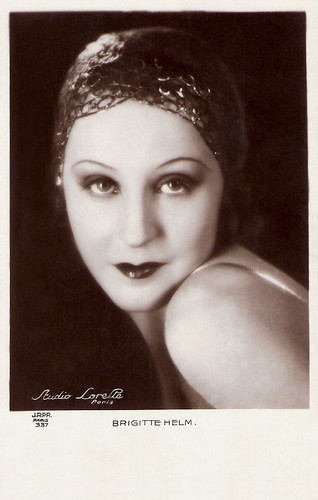
French postcard by J.R.P.R., Paris, no. 337. Photo: Studio Lorelle (Lucien Lorelle), Paris. Brigitte Helm in L'Argent/The Money (Marcel L'Herbier, 1928).
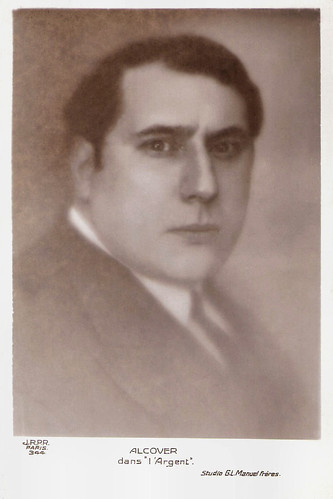
French postcard by J.R.P.R., Paris, no. 344. Photo: Studio G.L. Manuel Frères. Pierre Alcover in L'Argent/The Money (Marcel L'Herbier, 1928).
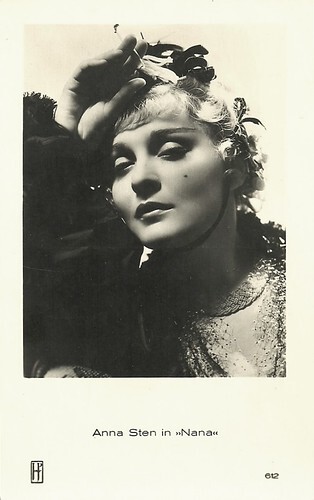
Dutch postcard by JosPe, Arnhem, no. 612. Anna Sten in Nana (Dorothy Arzner, George Fitzmaurice, 1934). Strikingly beautiful Anna Sten (1908-1993) was a Ukrainian-born actress, who became the most famous, or rather, the most notorious of the many ‘new Greta Garbos’ of the 1930s.
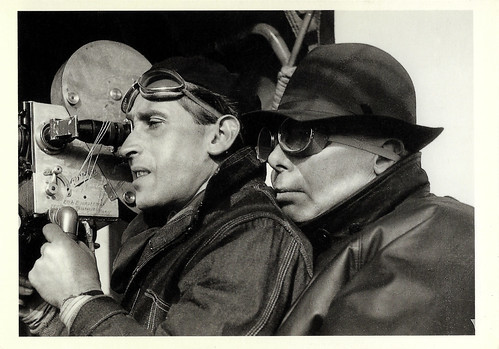
French postcard in the Collection Noire by Editions Hazan, Paris, no. 6011, 1988. Photo: Sam Levin. Director Jean Renoir at the set of La bête humaine/The Human Beast (1938).
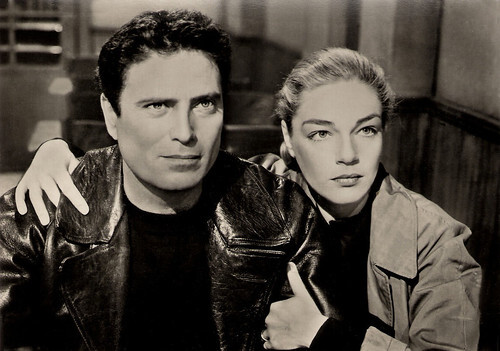
East-German postcard by VEB Progress Film-Vertrieb, Berlin, no. 1925. Retail price: 0,20 DM. Photo: Raf Vallone and Simone Signoret in Thérèse Raquin/The Adultress (Marcel Carné, 1953), after the novel by Emile Zola.
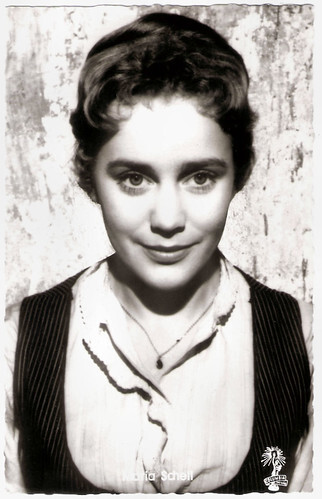
German postcard by Kolibri-Verlag, Minden/Westf., no. 2230. Photo: Columbia. Maria Schell in Gervaise (René Clément, 1956).
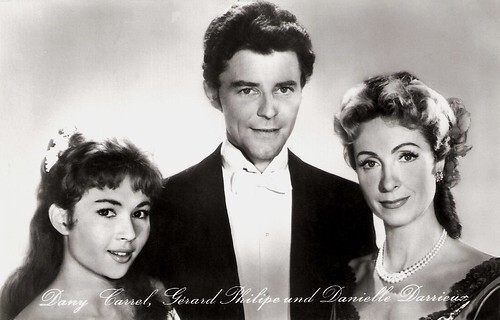
East-German postcard by VEB Progress Filmvertrieb, no. 1294, 1960. Photo: Dany Carrel , Gérard Philipe and Danièle Darrieux in Pot-Bouille/Lovers of Paris (Julien Duvivier, 1957), adapted from the novel by Zola.
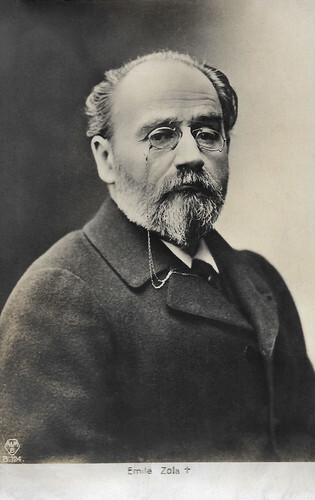
French postcard by A & M, B., no. B 124. Emile Zola.
Sources: Gallica (French), Bob Lipton (IMDb), Wikipedia (French and Dutch), and .

French postcard by Europe, no. 563. Photo: Cinéromans Films de France. Brigitte Helm in L'argent (Marcel L'Herbier, 1928), freely adapted from the novel by Emile Zola.

French postcard by Editions Cinémagazine, no. 411. Catherine Hessling as the title character in Nana (Jean Renoir, 1926), based on the homonymous novel (1880) by Émile Zola.

British postcard in the Famous Film Stars Series by Valentine's, no. 7123B. Photo: United Artists. Anna Sten in Nana (Dorothy Arzner, George Fitzmaurice, 1934).

East-German postcard by VEB Progress Film-Vertrieb, nr. 1924. Photo: Simone Signoret in Therese Raquin Thérèse Raquin/The Adultress (Marcel Carné, 1953).

East-German postcard by VEB Progress Filmvertrieb GmbH., Starfoto no. 1288. Gérard Philipe and at right Dany Carel in the Zola adaptation Pot Bouille/Lovers of Paris (Julien Duvivier, 1957), released in Germany as Der schöne Octave.
Writing his true vocation
Émile Édouard Charles Antoine Zola was born in 1840 in Paris. He spent his childhood and school years in Aix-en-Provence, where his father Francesco Zola, of Italian origin, was an engineer. He was implementing a plan for a drinking water supply when he died unexpectedly. Poor years followed for Zola and his mother, Émilie Aubert. In 1858 they went to Paris.
From his earliest youth, Émile Zola was fascinated by literature. He read a great deal and very early on envisaged the idea of writing professionally. From an early age, he considered writing to be his true vocation. In the sixth grade, he had already written a novel about the Crusades. He told his childhood friends several times in his letters that one day he would be a recognised writer.
Zola failed his baccalauréat (bachelor of sciences) twice in 1859. These failures left a deep impression on the young man, who despaired of having disappointed his mother. He was also aware that, without a diploma, he would face serious material difficulties. In Paris, he became friends with Édouard Manet and other painters of the Impressionist movement. Manet depicted him several times in his paintings, and through Manet, he came into contact with the poet Stéphane Mallarmé.
In 1862, Zola found a job in the publicity department of the publishing house Hachette. There he met writers and became familiar with the practical side of being a writer. He learned all the techniques of books and their marketing. He also published as a journalist in various magazines. As a critic, he was particularly harsh on the official Salon jury when 'The Flute Player' by Manet was rejected. He would also become a fervent defender of impressionism.
Zola managed to get his first book published by Hetzel: 'Les Contes à Ninon' (1864). He became famous with novels such as 'Germinal', 'Nana' and the enormous success, 'L'Assommoir' (1877), which are part of the great cycle 'Les Rougon-Macquart'. 'Les Rougon-Macquart' is a twenty-volume novelistic fresco depicting French society under the Second Empire, which follows the trajectory of the Rougon-Macquart family through its different generations, each of whose representatives, from a particular period and generation, is the subject of a novel.
In 'L'Oeuvre' (1886), he depicts the tragic life of a painter, a character largely inspired by Paul Cézanne, a childhood friend of Zola's from Aix-en-Provence. Cézanne had introduced him to the graphic arts, and more particularly to painting. After receiving this novel, Cézanne abruptly ended their friendship, which had not been very intense for some time.
Zola's open letter to President Félix Faure in L'Aurore of 13 January 1898 under the title 'J'accuse...!' was also famous. In this letter about the Dreyfus affair, he sides with the Jewish captain Alfred Dreyfus, who was unjustly accused of espionage. Zola accused the French General Staff of producing evidence. Zola was sentenced for libel to one year in prison and a 3000 Francs fine, which was paid for him by Octave Mirbeau. On the advice of friends, Zola did not wait for the appeal and fled to Britain. After a year he was able to return and was received as a hero.
Zola married Alexandrine 'Gabrielle' Meley in 1870, a working-class woman who had been a model for Impressionist painters such as Manet. She introduced him to the people on the fringes of society in Paris. She also organised weekly literary dinners for Zola to further his career. Zola also had a mistress, Jeanne Rozerot, who was the family laundress. While his marriage remained childless, he and Jeanne had two children.
Émile Zola died unexpectedly in Paris in 1902 at his home on the Rue de Bruxelles due to carbon monoxide poisoning. According to Philipp Blom, a roofer confessed to placing a piece of wood on the chimney to kill the writer in revenge for his defence of the Jewish captain. In 1908, his body was transferred to the Panthéon.

French card. Photo: Gerschel. Émile Zola.

Vintage French postcard. Scene from the play 'Nanà' by William Busnach, a play in five acts adapted from the novel by Émile Zola. Théâtre de l'Ambigu, Paris. Tableau 1, The Blonde Venus. The play was first performed at the Théâtre de l'Ambigu on 6 February 1904.

Vintage French postcard. Scene from the play 'Nanà' by William Busnach, a play in five acts adapted from the novel by Emile Zola. Théâtre de l'Ambigu. Tableau 2, The Ruins of Chamont. The play was first performed at the Théâtre de l'Ambigu on 6 February 1904. Nanâ was played by Armande Cassive. It was one of her most memorable roles.

French postcard by P. Helmlinger & Co., Nancy. Cliché: N. (Nadar). Promotion for the Théâtre Moncey's production of Émile Zola's novel 'L'Assommoir' (24 February - 3 March 1905). Çaption: The death of Gervaise (Hélène Petit). This postcard shows a photo from the 1879 first stage adaptation, starring Hélène Petit as Gervaise, Gil Naza as Coupeau, and Angelo as Goujot. The original photos were by Nadar.
In 1879, two years after its publication, Émile Zola's novel 'L'Assommoir' was adapted for the stage by William Busnach and Octave Gastineau, with the help of Zola. The premiere took place on 18 January 1879 and was a great success. Afterwards, the play was often re-staged, in and outside of France. From 24 February 1905, the play was staged at the Parisian Théâtre Moncey, 50, Avenue de Clichy. The journal La Presse of 26 February 1905 lauded the play and the performances, in the first place by M. Pouctal as Coupeau, Gabrielle Fleury as Gervaise, and M. Lemarchand as Lantier. Also praised were Mlle Delorme, Mme Gaudy, and M. Berthon as Lorilleux. Of course, there were tears, but also many laughs over the drunkards Mes-Bottes, Bec-Salé, and Bibi-la-Grillade, played by Mori, Prika, and Martin. The first night took place before a packed crowd.

French postcard by Croissant, Paris, no. 3678. Photo: Film Pathé. Publicity still for Les victimes de l'alcoolisme/Alcohol and Its Victims (Ferdinand Zecca, 1902).
Les victimes de l'alcoolisme/Alcohol and Its Victims (Ferdinand, Zecca, 1902) is a four minutes short, directed, and written by Ferdinand Zecca. It was based on 'L'Assommoir', and the first Zola film adaptation ever. Les victimes de l'alcoolisme/Alcohol and Its Victims tells a moral story of what happens to a man if he starts to drink and gamble. Bob Lipton at IMDb : "this is a very advanced film for 1902, being offered in five scenes, on elaborately painted sets. It was probably not intended solely for movie programs, but for anti-booze lectures, Chautauquas, and conferences."

French postcard by Croissant, Paris. Photo: Film Pathé. Publicity still for Au pays noir/Tragedy in a Coal Mine (Ferdinand Zecca or Lucien Nonguet, 1905). Caption: In the mine galleries. This refers to the 5th scene of the film.
Au pays noir (1905) was partly inspired by Émile Zola's novel, the popular workman's drama 'Germinal' (1885). Au pays noir narrates the life of the miner: his life at home, going to work, gathering at the pit and descending, and having a break. But then an explosion takes place and water crushes the beams that uphold the galleries, killing the miners. A few manage to escape and withdraw to a higher gallery where the water can reach them only to their middle. They hear their liberators, who finally free them. Outside, gendarmes try to hold the crowd, who, frightened, see the rescuers bringing dead bodies one by one to the ground. When the foreman's dead son is brought to earth, his father explodes with grief and clenches his fist against the murderous mine. A year after the film, the worst mine disaster in Europe occurred in Courrières, France, when on 10 May 1906 a coal dust explosion killed almost 1100 mine workers. Zola's 'Germinal' was already filmed by Ferdinand Zecca in 1903. In 1912 Victorin Jasset filmed for the Eclair company another liberal adaptation, Au pays des ténèbres, while Albert Capellani filmed Germinal under its own title in 1913.

Spanish collectors card by Chocolat Imperial, no. 1 (in a series of 18 chromos). Photo: Caesar Film / J. Gurgui, Barcelona. Tilde Kassay in Una donna funesta/Nanà (Camillo De Riso, 1917-1919). Tilde Kassay (1887-1964), was an Italian silent film actress between 1915 and 1921.

Italian postcard by IPA CT. V. Uff. Rev. St., Terni., no. 5076. Photo: Tiber Film. Hesperia in La Cuccagna (Baldassarre Negroni 1917). Caption: "Massimo had been raised in a provincial college." The film was an adaptation of Emile Zola's 'La curée'. Hesperia is Renata/Renée, the second wife of the cunning and wealthy Saccard, who married young Renata for her money. She has an affair with Saccard's son Max (Massimo), played by Alberto Collo . In the end money triumphs instead of love, just as in Zola's novel.
In search of truth
Emile Zola paints the society of the Second Empire in all its diversity, highlighting its harshness towards the workers ('Germinal', 1885), its turpitude ('Nana', 1880), but also its successes (the advent of department stores in 'Au Bonheur des Dames', 1883).
In a search for truth that takes scientific methods as a model, Émile Zola accumulates direct observations and documentation on each subject. With his acute sense of detail "that rings true" and of effective metaphor, with the rhythm of his sentences and his narrative constructions, he creates a powerful fictional world, inhabited by anguished questions about the human and social body.
Émile Zola's work has been widely adapted to film, with more than 150 films and TV movies based on his works, in various languages. The first adaptations were of 'L'Assommoir', by Ferdinand Zecca, under the titles Le Rêve d'un buveur (1898) and Les Victimes de l'alcoolisme (1902).
In addition to L'Assommoir, more than half of the titles in the Rougon-Macquart series have been adapted for the screen. Some, such as 'Nana' and 'Germinal', have been adapted several times, with varying degrees of faithfulness to the original works.
Apart from the Rougon-Macquart cycle, the only work by Zola that has been widely adapted for the screen is 'Thérèse Raquin', but several of his short stories have also been adapted.
In 1937, the French novelist inspired the Hollywood production The Life of Emile Zola, directed by William Dieterle and starring Paul Muni , which won the 1938 Academy Award for Best Picture.

French postcard by J.R.P.R., Paris, no. 337. Photo: Studio Lorelle (Lucien Lorelle), Paris. Brigitte Helm in L'Argent/The Money (Marcel L'Herbier, 1928).

French postcard by J.R.P.R., Paris, no. 344. Photo: Studio G.L. Manuel Frères. Pierre Alcover in L'Argent/The Money (Marcel L'Herbier, 1928).

Dutch postcard by JosPe, Arnhem, no. 612. Anna Sten in Nana (Dorothy Arzner, George Fitzmaurice, 1934). Strikingly beautiful Anna Sten (1908-1993) was a Ukrainian-born actress, who became the most famous, or rather, the most notorious of the many ‘new Greta Garbos’ of the 1930s.

French postcard in the Collection Noire by Editions Hazan, Paris, no. 6011, 1988. Photo: Sam Levin. Director Jean Renoir at the set of La bête humaine/The Human Beast (1938).

East-German postcard by VEB Progress Film-Vertrieb, Berlin, no. 1925. Retail price: 0,20 DM. Photo: Raf Vallone and Simone Signoret in Thérèse Raquin/The Adultress (Marcel Carné, 1953), after the novel by Emile Zola.

German postcard by Kolibri-Verlag, Minden/Westf., no. 2230. Photo: Columbia. Maria Schell in Gervaise (René Clément, 1956).

East-German postcard by VEB Progress Filmvertrieb, no. 1294, 1960. Photo: Dany Carrel , Gérard Philipe and Danièle Darrieux in Pot-Bouille/Lovers of Paris (Julien Duvivier, 1957), adapted from the novel by Zola.

French postcard by A & M, B., no. B 124. Emile Zola.
Sources: Gallica (French), Bob Lipton (IMDb), Wikipedia (French and Dutch), and .
Published on May 22, 2022 22:00
Paul van Yperen's Blog
- Paul van Yperen's profile
- 13 followers
Paul van Yperen isn't a Goodreads Author
(yet),
but they
do have a blog,
so here are some recent posts imported from
their feed.



